GA R DENS
7 tranquil rural gardens to escape the modern world

ENTER SANDMAN
Peter Korn,s new experimental garden
Bright sparks
Top 10 plants for early summer colour
Beautiful
edibles
Edimentals
and tasty
PLANTING IDEAS • BEAUTIFUL GARDENS • EXPERT ADVICE
CountryCALM
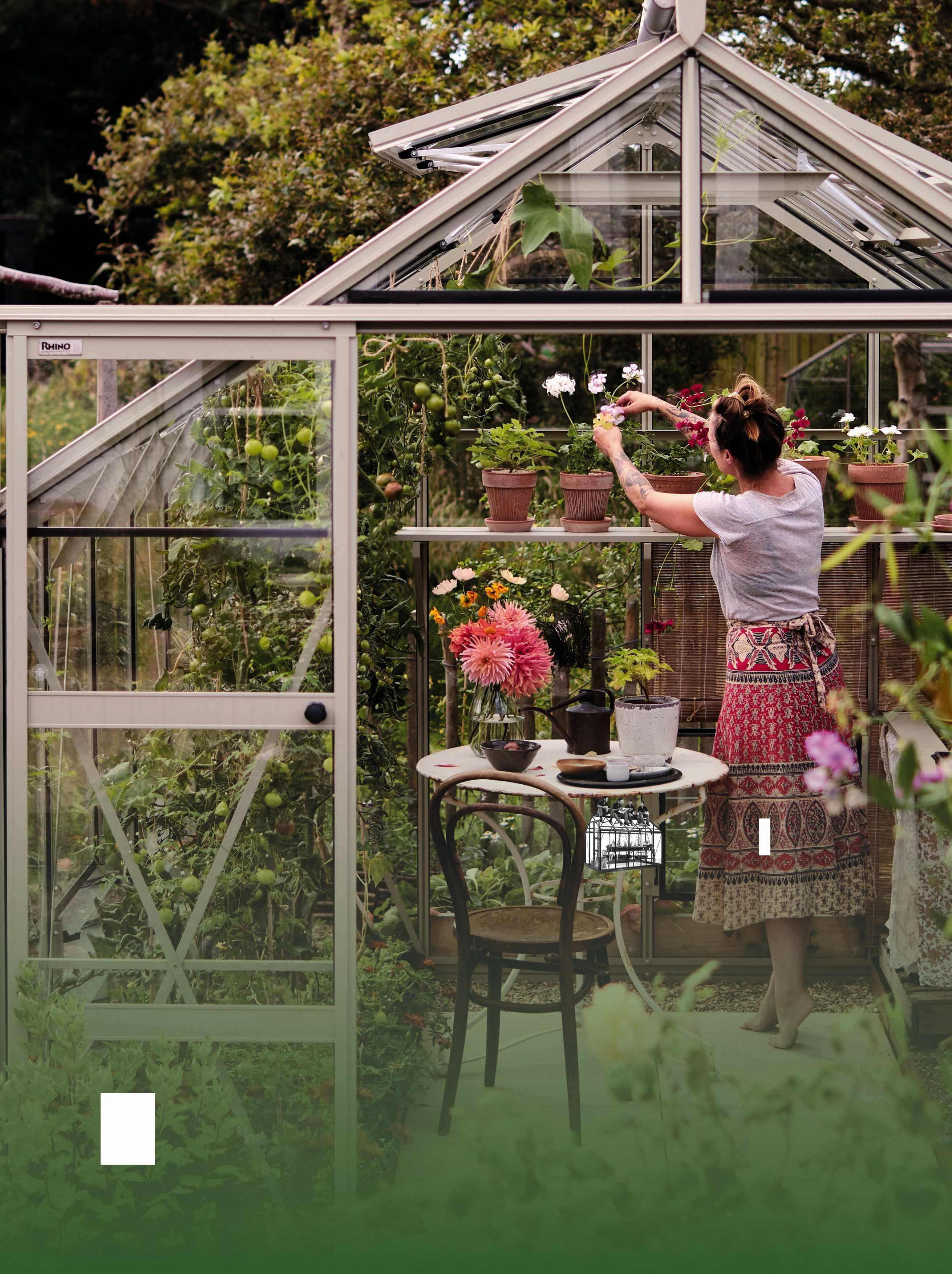
rhinogreenhouses.co.uk 0800 694 1929
After what felt like quite a late spring, summer has blissfully, finally arrived in our gardens. It’s the perfect time to indulge in a bit of garden visiting, enjoying the diverse ideas, styles and planting in other people’s plots. Even if you can’t get out and about in person, you can escape to the country with us this issue as we visit seven amazing seasonal gardens at their peak, from the experimental sand beds of Peter Korn’s garden in Sweden (page 40) to a conceptual courtyard by James Basson in France (page 118), and the pale but interesting walled garden of The White Company founder Chrissie Rucker in Buckinghamshire (page 58).
We also take in a wildlife-friendly East Sussex garden with dreamy planting and a natural swimming pond (page 68); the grand design of an organic garden by Urquhart & Hunt for a historic Gloucestershire home (page 88); a naturalistic scheme by designer Stefano Marinaz for a barn conversion in Essex (page 82); and a small, smart garden with textures of green and a limited palette of repeated flowers, near Amsterdam (page 102).


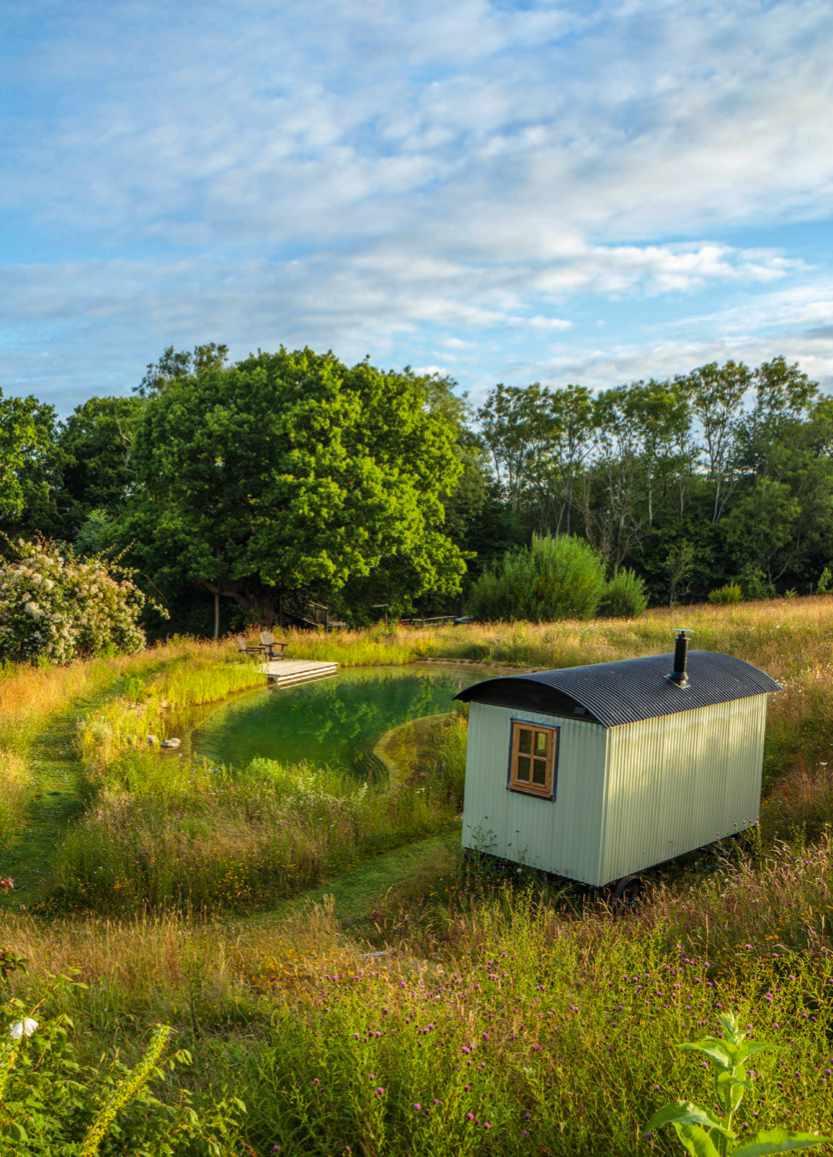
For more inspiration, if you have been thinking about adding a garden studio, you can learn from Alice Vincent’s endeavours to create her own (page 146) and choose from our top selection of stylish outdoor offices, workshops and pods (page 124). And to top it all off, we are focusing on edible plants this month, with picks from experts who have chosen the best ‘edimentals’ – those plants that are both beautiful and tasty (page 76) –and some pretty, flavourful recipes (page 108) for using edible flowers for delicious summer dishes.


Welcome
CLIVE NICHOLS
Wildlife-friendly planting around a natural swimming pond and shepherd’s hut create a dreamy space to relax in this East Sussex garden, page 68.
STEPHANIE MAHON, EDITOR
JOHN CAMPBELL
JUNE 2023 gardensillustrated.com 3
@gardens_illustrated
@GdnsIllustrated
@gardensillustrated
Looking for some easy summer listening? Try our podcast Talking Gardens. To find out more, scan this QR code with your phone or visit link.chtbl.com/TalkingGardens
Instagram
Twitter
Facebook
No petrol means no fuss, no mess and no emissions. Make the choice today for a better environment for all.


Choose Kress. Find out more: Kress.com
Places
40 True grit In his garden in the south of Sweden, Peter Korn plants everything in sand with amazing success
58 Pale and interesting For Chrissie Rucker, founder of The White Company, tranquillity is the guiding principle in her beautifully realised white garden
68 Wild dreams The diverse soil conditions on a sloping site in East Sussex have encouraged an ecological approach to gardening that benefits wildlife

82 Mixed blessings Designer Stefano Marinaz has replaced a lawn with a naturalistic garden of mixed planting that offers year-round interest
88 Nature first The beautiful gardens of this Gloucestershire house have been redesigned by Urquhart & Hunt with wildlife firmly in mind
102 Change of tune In this small Dutch garden, designer Jelle Koot has created a simple rhythm of repeated plants
Plants
28 Plantsperson’s favourites
Åsa Gregers-Warg, head gardener at Beth Chatto’s Plants & Gardens, chooses her top ten plants for June
50 Plant profile: Geum Offering flowers that bloom from late spring into summer, this varied genus of hardy perennials is justly growing in popularity
76 Good enough to eat Three expert growers recommend their favourite plants that are as beautiful in borders as they are delicious on the plate
96 Gathering attention With lilacs once again catching the eye of designers, John Hoyland takes a look at the French cultivars that inspired modern versions
People
37 Gardening talent Meet Cecily Withall, Kew’s first female climbing arborist since the 1980s
66 Who’s who The legendary Italian garden designer Paolo Pejrone on the importance of working with nature
108 Floral flavours Erin Bunting and Jo Facer, of The Edible Flower, show how adding common flowers to your recipes can bring a delicious twist to many dishes
146 Working out Alice Vincent was hoping someone might have taken the hard work out of installing a garden studio
Design
117 Design news A new green development for Nijmegen’s riverfront
Flow state Designer James Basson’s bold walled garden in Provence reflects the canals and fields
Regulars
JUNE 2023
Contents
6 gardensillustrated.com JUNE 2023
ALISTER THORPE
the local landscape 124 Sourcebook Nine of the best garden studios
118
of
3 Welcome 8 Contributors 15 Dig in This month: news of how Sissinghurst plans to cope with a long, hot summer 22 Subscription offer Save when you subscribe to the digital edition of Gardens Illustrated 25 Kitted out For hedging and topiary maintenance 33 Added interest? Ken Thompson urges caution over gardening products that offer miracles 129 Books From garden design inspiration to choosing the most beautiful fruit and nut trees 138 Crossword and back issues 145 Next issue What’s coming up in July
Stefano Marinaz’s low-maintenance design for a barn conversion in Essex, page 82.
digital subscription to Gardens Illustrated
SEE PAGE 22
COVER IMAGE
Peter Korn’s garden by Claire Takacs (page 40)
ON THE COVER ON THE COVER
Country calm, pages 40, 58, 68, 82, 88, 102 and 118
Enter Sandman, page 40 Bright sparks, page 28
Edimentals, pages 76 and 108
EVE EVENTS AND NTS OFFERS
• Join us on a five-day garden tour to explore the gardens of some of the leading names in Dutch horticulture and garden design – page 10
• Save money when you subscribe to the digital edition of Gardens Illustrated – page 22

• Win a three-night stay, worth £1,035, at Le Jardin des Douars in Morocco† – page 141
†Competition open to UK residents only.
Our
packaging
Subscriber copies of Gardens Illustrated are now delivered in paper wrapping instead of recyclable plastic polywrap. This paper wrap is 100% recyclable and made from sustainably sourced paper. Please recycle in your kerbside recycling bin. We would love to hear your feedback, please contact us at paperwrap@immediate.co.uk
Subscribe & save take
a
out
GARDENDESIGN TRAININGFOR PROFESSIONALS
Findoutmoreaboutourinspirational designtrainingatRoyalBotanic GardensKew,RHSGardenWisley andonline.
Contributors
Jodie visits The White Company founder Chrissie Rucker’s garden, page 58. “I wasn’t surprised Chrissie has a white garden, but I was impressed by how interesting it is.”
Alister photographs an Essex garden, page 82.
“I’m intrigued by the way Stefano plants his projects and this Essex garden is the perfect place to observe his ‘plant communities’ in action.”
Clark meets Italian legend Paolo Pejrone, page 66. “Paolo turns 82 this year, and has designed hundreds of gardens all over the world. Squeezing his life into a page was a challenge.”
CONTRIBUTING EDITORS
OurDiplomaandotherprofessional developmentprogrammesaredelivered fromourhomeinRoyalBotanicGardens Kewwithareal-time,onlineoptionfor thosewishingtostudywithusfrom home.In2023wealsohavean expandedshortcourseprogrammefor professionalsandgardenenthusiastsat allourtrainingcentresandonline.
Visitourwebsite lcgd.org.uk toseehow ourstudentsarecreatingsuccessful gardendesigncareersanddiscovera coursethatisrightforyou.
James Basson
James lives in the South of France where he runs Scape Design, a practice specialising in low-maintenance and dry gardens. He is a fervent advocate for creating sustainable landscapes. The winner of four Chelsea Gold medals, he was awarded Best in Show in 2017.




Fergus Garrett
Fergus was appointed head gardener at Great Dixter by Christopher Lloyd in 1993. He is passionate about passing on his knowledge through student programmes at Dixter and worldwide lectures. He was awarded an RHS Associate of Honour in 2008 and an RHS Victoria Medal of Honour in 2019.
Anna Pavord
Anna’s books include her bestseller The Tulip and most recently Landskipping. For 30 years she was The Independent’s gardening correspondent. In 2000 the RHS awarded her the Veitch Memorial Medal. She lives and gardens in Dorset.

Dan Pearson
Dan is one of the UK’s best-known garden designers. Eight of his gardens, including the Tokachi Millennium Forest in Japan, have won awards and he was awarded Best in Show for his garden at Chelsea in 2015. He was awarded an OBE in the 2022 New Year Honours for services to horticulture.


Sarah Price
Sarah is one of the UK’s most sought-after garden designers who gained worldwide recognition for her designs for the 2012 London Olympic Park. She won Gold at Chelsea in 2012 and 2018, and was GMG Garden Columnist of the Year in 2016 for her design series in Gardens Illustrated



ANDREW MONTGOMERY ANDREW MONTGOMERY
+44(0)1483762955info@lcgd.org.uk
Design:CraigAtkinson
Design:CraigAtkinson
Jodie Jones
Clark Lawrence
Alister Thorpe
ANNIE GUILFOYLE
GA R DENS
HOW TO GET IN TOUCH WITH US
Subscription enquiries and back issues
UK 03330 162114
USA/CANADA 1 866 464 8103 (TOLL-FREE) REST OF THE WORLD +44 1604 973722 UK buysubscriptions.com/contact buysubscriptions.com/gardensillustrated
USA/CANADA GILcustserv@cdsfulfillment.com, britsubs.com/garden
UK/REST OF THE WORLD Gardens Illustrated, PO Box 3320, 3 Queensbridge, Northampton NN4 7BF.
USA/CANADA Gardens Illustrated, PO BOX 37495, Boone, IA 50037-0495 USA.
Advertising enquiries
+44 (0)117 300 8805 heather.golden@ourmedia.co.uk
Editorial enquiries
+44 (0)117 300 8622 gardens@gardensillustrated.com

Gardens Illustrated, Our Media Ltd (an Immediate Group Company), Eagle House, Bristol BS1 4ST.
Syndication & Licensing
Gardens Illustrated is available for licensing and syndication. +44 (0)117 300 8787, emma.brunt@ourmedia.co.uk
App support
For App support please visit apps.immediate.co.uk/support
We abide by IPSO’s rules and regulations. To give feedback about our magazines, please visit ourmedia.co.uk, email editorialcomplaints@immediate.co.uk or write to Katherine Conlon, Our Media Ltd (an Immediate Group Company), Eagle House, Bristol BS1 4ST.

MAGAZINE CONTACTS
EDITORIAL
Editor Stephanie Mahon
Art director David Grenham
Deputy editor Sorrel Everton
Deputy art editor Niki Goss
Production editor Juliet Giles
Digital editor Daisy Bowie-Sell
Commissioning content editor Veronica Peerless
Content producer Molly Blair
Botanical adviser Dr James Compton
Thanks this issue Hilary Brown
ADVERTISING
Group advertising manager Laura Jones 0117 300 8509 laura.jones@ourmedia.co.uk

Portfolio advertising manager Heather Golden 0117 300 8805 heather.golden@ourmedia.co.uk
Brand sales executive Mica Enwright 0117 300 8756 mica.enwright@ourmedia.co.uk

Advertising designer Parvin Sepehr
INSERTS
Laurence Robertson +353 (0)876 902208
CIRCULATION, MARKETING, PROMOTIONS, PRESS & PR
Newstrade manager John Lawton
Subscriptions director Jacky Perales-Morris
Direct marketing manager Aimee Rhymer
Buyer Karen Flannigan
PR & Outreach Manager for Comms Emma Cooney emma.cooney@ourmedia.co.uk
MANAGEMENT
Chief executive officer Tom Bureau
Group managing director Our Media Andy Marshall
Managing director Our Media Andrew Davies
Head of brand marketing and brand lead Rosa Sherwood
SYNDICATION & LICENSING
Director of licensing & syndication Tim Hudson
PRODUCTION
Production director Sarah Powell
Group production manager Louisa Molter
Senior production co-ordinator Katty Skardon
Jan-Dec 2022 45,716* *Combined print and digital sales Gardening trousers with stab-proof pockets and waterproof kneepads No more lost secateurs ® The Royal Hort cu tural Society The Royal Hort cultural Society and its ogo are trade marks of The Royal Horticultural Society (Registered Charity No 222879/SC038262) and used under licence from RHS Enterprises Limited. So www.genus.gs CALL US ON 0203 617 1166 www.TinkerandFix.co.uk
Standard subscription rates: UK £64.87 per annum; Eire and Europe €79 for 13 issues; rest of the world US$112 for 13 issues. Distribution Frontline, Peterborough. US distribution Source IPD/Speedimpex. Email intlquery@seymour.co.uk. Printed in the UK by William Gibbons Ltd. Gardens Illustrated (ISSN 0968-8920) (USPS 015-608) is published 13 times a year (monthly with a Summer issue in July) by Our Media Ltd (an Immediate Group Company), Eagle House, Bristol BS1 4ST, UK. Distributed in the USA by NPS Media Group, 2 Corporate Drive, Ste. 945, Shelton, CT 06484. Periodical postage paid at Shelton, CT and additional mailing offices. POSTMASTER: Send address changes to Gardens Illustrated, PO Box 37495, Boone, IA 50037-0495. Unsolicited manuscripts or artwork are accepted on the understanding that the publishers incur no liability for their storage or return. The contents of this magazine are fully protected by copyright and may not be reproduced without permission. The Gardens Illustrated cover is printed on 250gsm FSC Amadeus produced in Belgium by Burgo. Our Media Company is working to ensure that all of its paper comes from well-managed, FSC®-certified forests and other controlled sources. This magazine is printed on Forest Stewardship Council® (FSC®) certified paper. This magazine can be recycled, for use in newspapers and packaging. Please remove any gifts, samples or wrapping and dispose of them at your local collection point. All prices are correct at time of going to press. © Our Media Ltd (an Immediate Group Company) 2023. Member of the Audit Bureau of Circulation. ISSN 0968-8920.
THIS MAGAZ NE IS OWNED MAGAZINE AND PUBLISHED BY
Dutch Design
Join Keith Wiley on a five-day garden tour to explore the gardens of some of the leading names in Dutch horticulture and garden design

The Netherlands is famous for horticultural excellence and innovations at the forefront of garden design, with the likes of internationally renowned Piet Oudolf, Jacqueline van der Kloet and Robert Broekema as contemporary names leading the way.
The tour starts with visits to Oudolf-designed gardens at the Singer Laren museum of Modernist art, including the recently planted sculpture garden, and De Vlinderhof in Máximapark, where more than 100 types of plant create a haven for people and pollinators.
Further visits explore some of the sources of inspiration for today’s designers, such as the gardens of the late Mien Ruys, considered to be one of the most influential garden architects of the 20th century, and the magnificent, restored, 17th-century grounds of the former royal residence Paleis Het Loo.
In Amsterdam, we enjoy a tour of Museum Van Loon, a 17th-century canal house with a fine contemporary garden, along with a visit to the private garden of designer Jacqueline van der Kloet. Your hotels are the country house Kasteel Engelenburg in Brummen, and boutique hotel The Dylan in Amsterdam.
26-30 SEPTEMBER 2023
EVENT DETAILS
Price per person, based on two people sharing, is £4,440 (a single supplement of £350 is levied by the hotel).
The price includes return flights from London to Amsterdam, two nights’ bed and breakfast at Kasteel Engelenburg and two nights’ bed and breakfast at The Dylan, plus four evening meals with wine at the hotels, and five lunches. Please note that Boxwood Tours uses hotels of character featuring a variety of rooms and styles. The price does not include extras at the hotels, or travel insurance. For more details and for an in-depth itinerary with details of day-to-day visits, meals, etc, please contact Boxwood Tours.
FOR INFORMATION AND BOOKING, PLEASE CONTACT
Boxwood Tours, 1 West Street, Buckingham HK18 1HL, UK. Tel +44 (0)1341 241717. Email mail@boxwoodtours.co.uk Website boxwoodtours.co.uk
The tour has been arranged exclusively for readers of Gardens Illustrated by Boxwood Tours Quality Garden Holidays, a specialist garden tour company set up in 1990. Please note that itineraries may be subject to change for reasons beyond Gardens Illustrated’s control. The tour is financially protected by the ATOL scheme. Please see booking conditions for further information or for more information about financial protection and the ATOL Certificate go to: arenatravel.com/why-arena/financial-protection
CLAIRE
10 gardensillustrated.com JUNE 2023
TAKACS, CHARLIE HOPKINSON, FRANS LEMMENS / ALAMY STOCK PHOTO.
Paleis Het Loo.
TOUR GI Reader
De Vlinderhof.
Tour host Keith Wiley was head gardener for 14 years at The Garden House, a ten-acre garden on the edge of Dartmoor, before moving to his garden, Wildside, where he has created one of Britain’s most innovative gardens.

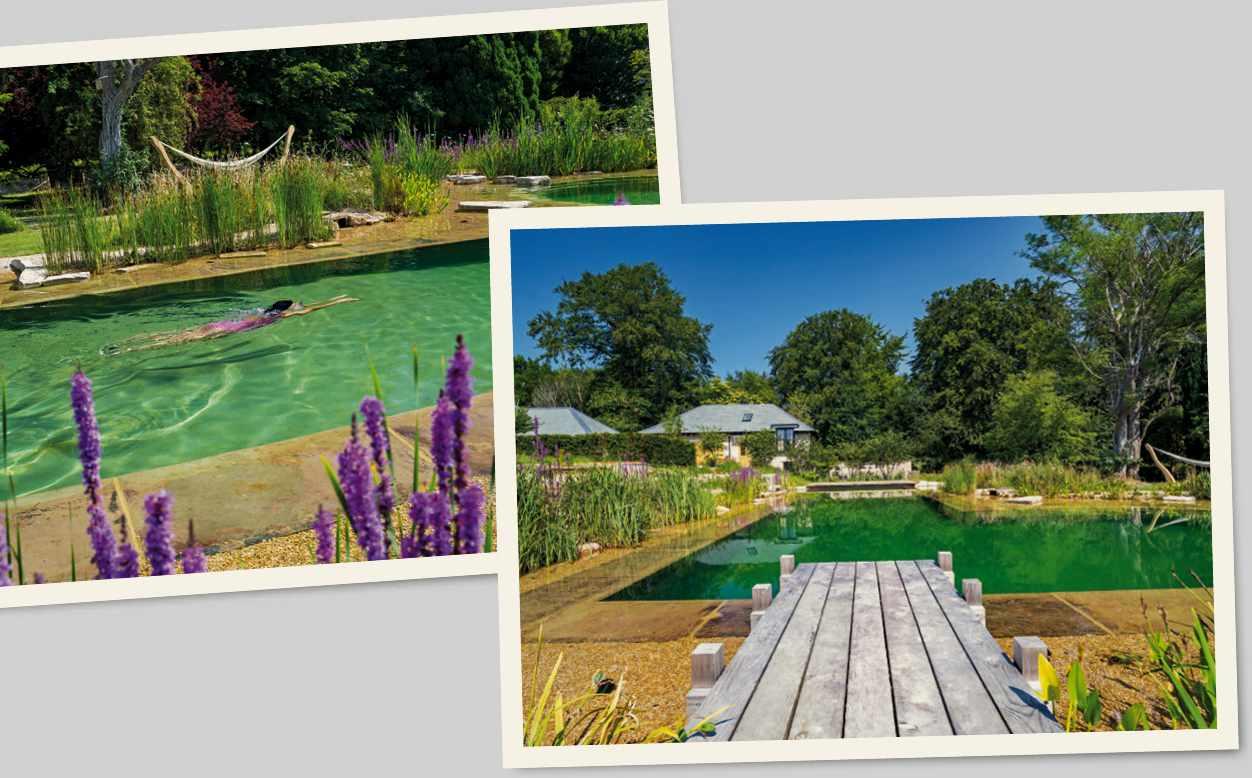

*Price applies to UK orders only. Overseas prices, including postage, are £12.99 for Europe and £13.49 for Rest of World. All orders subject to availability. Transform Your Garden will be on sale from 30 March 2023 and copies will be mailed from this date. Please allow up to 21 days for delivery. †UK calls will cost the same as other standard fixed-line numbers (starting 01 or 02) and are included as part of any inclusive or free-minutes allowances (if offered by your phone tariff). Outside of inclusive or free-call packages, call charges from mobile phones will cost between 3p and 55p per minute. Lines are open 8am-6pm, Monday to Friday, and 9am-1pm Saturday. SPECIANEWLISSUE ONLY £9.99 inc p&p* Order your copy today Order online at buysubscriptions.com/transformyourgarden or call us on 03330 162114† and quote ‘transform your garden 23’ This special edition features advice on designing your garden from the world’s top garden designers, including top tips for redesigning your plot or creating a new garden from scratch. Discover eight inspirational gardens in town and country, and beautiful planting ideas for year-round colour. Learn how to make the most of a small space, how to cope with a slope, and the ten most common mistakes people make, according to professional garden designers, and how to avoid them. Enjoy insights on everything from paths and parking spaces to wildflowers and water features, so that you can be confident in starting to create the garden of your dreams. A GARDENS ILLUSTRATED GUIDE TRANSFORM YOUR GARDEN An expert guide to garden design





Timeless clothing & equipment to carry you through the seasons carriercompany.co.uk always made in the uk F I N D U S A T R H S C H E L S E A F L O W E R S H O W 2 3 r d - 2 7 t h M A Y 2 0 2 3

01278 764444 | davidsalisbury.com ORANGERIES & GARDEN ROOMS THAT TRANSFORM YOUR HOME Request our inspirational brochure & arrange a complimentary design consultation
DIG IN
What’s new, what’s growing and what’s going on this month

NEWS COMPILED BY MOLLY BLAIR
Window on the botanical world
A new exhibition at London’s Saatchi Gallery, the RHS Botanical Art & Photography Show, highlights the botanical world at ts most wonderful. It is fascinating to see the many ways in which botanical artists and photographers have chosen to capture their subjects, from depictions of ecologically important plants, including English seaweeds and Scottish lichens, to endangered species in Korea, and from intricate details of tiny mushrooms and flowers to wide-open landscapes and compositions of gardeners at work. 16 June – 9 July, admission £7. saatchigallery.com
JUNE 2023 gardensillustrated.com 15
Clockwise from top left Sharron Diffley’s photograph Magical Mycena; the flowers of the houseplant Hoya latifolia by Eunike Nugroho; gardeners working in the temple gardens of Kyoto in Christine Adams’ image Quiet Unity; Vaccinium vitis-idaea by Gaynor Dickeson; Annemarie Farley’s Secret Garden; Winter Sun by Vanda Ralevska; salvias take centre stage in Julie Pigula’s Summer in Paradise; and a watercolour of fan weed Callophyllis laciniata by Sarah Jane Humphrey.
SHARRON DIFFLEY; EUNIKE NUGROHO; CHRISTINE ADAMS; GAYNOR DICKESON; ANNEMARIE FARLEY; VANDA RALEVSKA; JULIE PIGULA; SARAH JANE HUMPHREY / RHS BOTANICAL ART AND PHOTOGRAPHY SHOW 2023
EXHIBITION
Talking point TO WATER OR NOT TO WATER
Just in case anyone was still in doubt about climate change, in July last year the UK recorded its highest ever temperature when the mercury hit 40.3°C at RAF Coningsby in Lincolnshire. The Met Office is predicting that this summer could be even hotter, so as we brace ourselves for soaring temperatures and hosepipe bans, is it time to follow the example of Sissinghurst Castle Gardens, and stop watering our borders?
In a recent episode of the new Gardens Illustrated podcast, Talking Gardens, Sissinghurst’s head gardener Troy Scott Smith (above) revealed that “apart from pots and newly planted things” his team had done no watering at all last summer and don’t plan to water this year either. While he admitted the famous gardens went brown for parts of the year as a result of the new regimen, he felt it was important to increase the garden’s tolerance for drought.“I increasingly feel we have to look at our gardening practices and ask ourselves what is acceptable now, what is really needed,” he said.

Read more about how Sissinghurst is adapting to hotter summers, at gardensillustrated.com/ sissinghurstwatering
OUT & ABOUT
Long weekend
This month offers two opportunities to explore the wonderfully relaxed gardens of Ham Court in Oxfordshire, home to illustrator Matthew Rice. On Saturday 10 June, Matthew is hosting a private, evening tour of his gardens from 7pm, followed by a three-course supper, while on Sunday 11 June, he will open the gates from 11am to 5pm for a more family friendly chance to explore the space. Places on the supper evening are limited and cost £75 per person, while entry to the Sunday open day is £5. If you miss the June weekend, there are further dates planned for July and September. For full details visit matthewricewatercolours.co.uk

You can find lots more events to enjoy this month by going to our online diary. Scan this QR code with your phone camera or go to gardensillustrated. com/events

16 gardensillustrated.com JUNE 2023
RACHEL WARNE
MATTHEW RICE

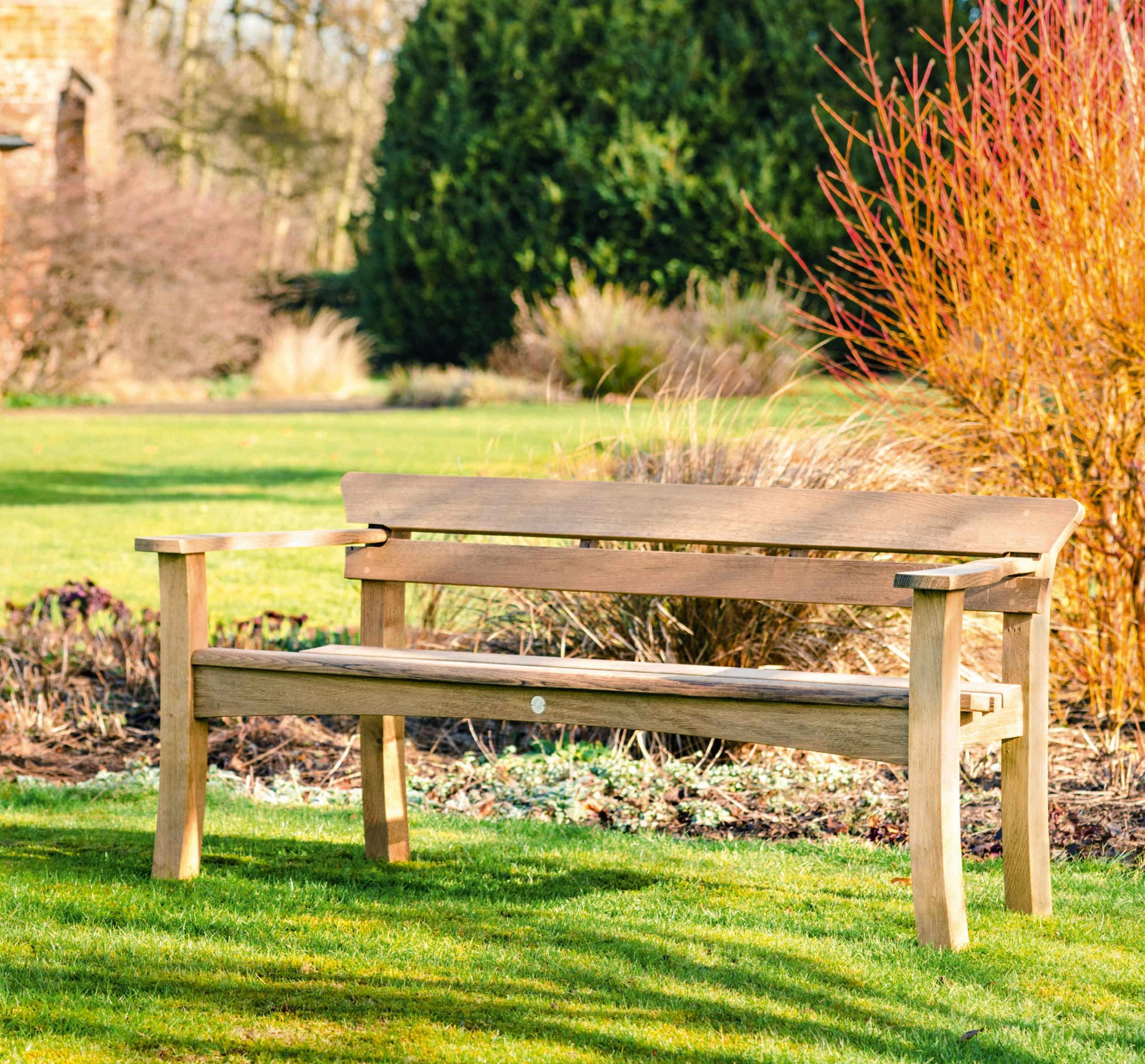


www.gazeburvill.com 01420 588444 Craftsman-made in Hampshire for your garden, a new seat in English Oak, GAZE BURVILL 30 Y EARS Amity Ph. Julie Skelton
PRODUCT Hanging out
Give bees a bright new home with the colourful hanging Bee Nester from Wildlife World. Designed and handmade in Bangladesh by a group of artisan women, each unique nester is made from a mixture of recycled sari material and costs £22.99. They are part of the Fairtrade range that includes bird nesters and hanging planters. thewildlifecommunity.co.uk
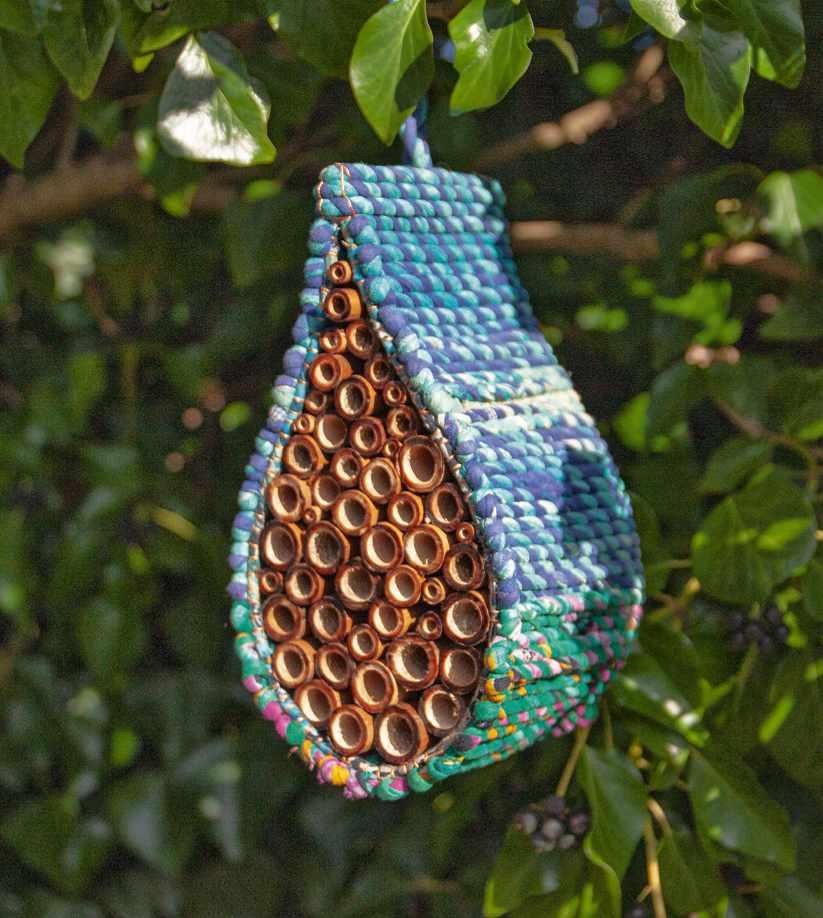
ART IN THE GARDEN
Piece of cake
Visitors to Waddesdon Manor in Buckinghamshire this summer will get the chance to step inside a 12m-high, three-tiered cake. Part artwork, part architectural folly, Wedding Cake is a new piece by Portuguese artist Joana Vasconcelos, who has described it as ‘a temple to love’. In a nod to the Baroque buildings of Lisbon, where she lives, she has clad the patisserie-inspired structure in 25,150 hand-painted tiles made in Portugal by ceramics manufacturer Viúva Lamego. A limited number of tours of the installation, which cost £15 (plus garden entry £13.20), will take place on Thursdays and Sundays from 8 June to 26 October. waddesdon.org.uk

Paradise regained Dan Pearson Studios has created a design for a new community garden for the Garden Museum. Set in part of Old Paradise Gardens, near the museum in Lambeth, south London, the Healing Garden will feature native, medicinal and wildlifefriendly planting as well as a large area for food growing. Local residents will also have the chance to attend weekly Friday gardening sessions under the tutelage of the museum’s gardener Gabby Boraston, to help with planting and maintenance. gardenmuseum.org.uk
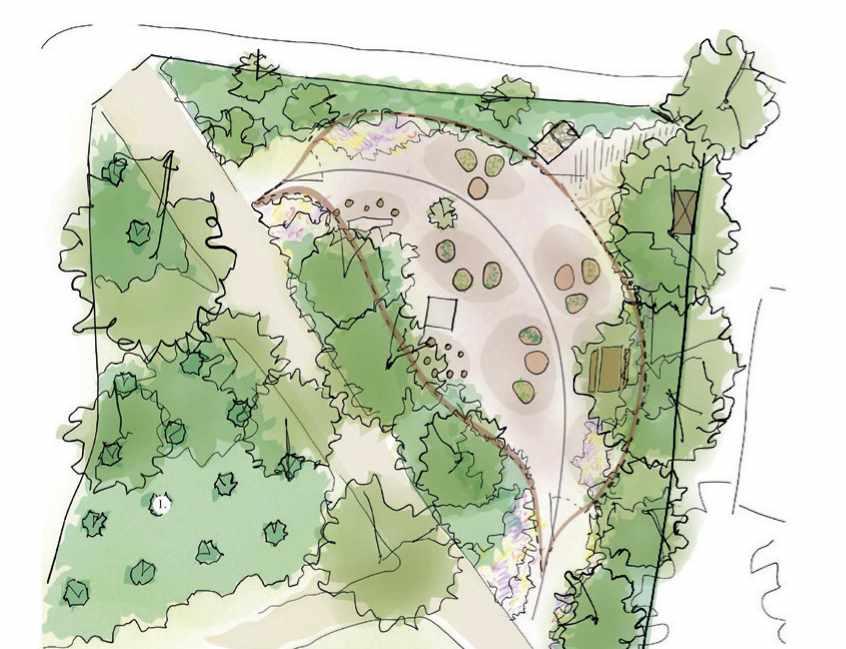
WHAT TO DO IN… JUNE 8
Botanical Painting Workshop
Join artist Katie Lenegan for a one-day introduction to capturing flowers in charcoal, ink, pencil and watercolour. Daylesford Farm. Thursday 8 June, 10am-4pm, from £135. Daylesford Farm, nr Kingham, Gloucestershire GL56 0YG. Tel 01608 731700. daylesford.com

Yeo Valley Organic Garden Workshop
Learn to live in peace and harmony with all the insects in your garden. Thursday 15 June, 10am-12.30pm, £38. Yeo Valley Organic Garden, Rhodyate, Blagdon, Bristol BS40 7YE. Tel 01761 461425, yeovalley.co.uk
23
15 Garden Roses Day
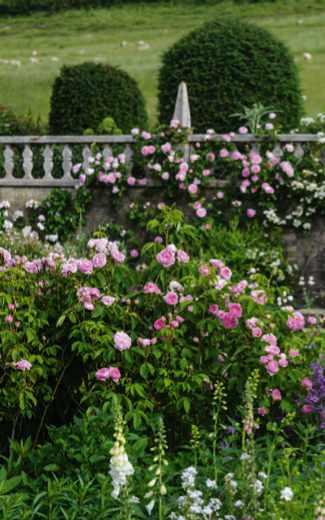
Celebrate summer with a range of demonstrations and workshops at the rosefilled Dorset Walled Garden. Friday 23 June, 10am-4pm, £165. Dorset Walled Garden, Upper Sydling House, Up Sydling, Dorset DT2 9PH. dorsetwalledgarden.co.uk

JUNE 2023
19
gardensillustrated.com
DIG IN NEWS
JASON INGRAM
WEDDING CAKE 3D RENDERING © ATELIER JOANA VASCONCELOS
DESIGN Concrete jungle

A pocket forest will become a permanent feature outside the Hayward Gallery, on London’s South Bank. Created by urban rewilding organisation SUGi, in collaboration with Moët & Chandon, the 130 metre-square Natura Nostra Forest has been planted with 390 trees, using the Miyawaki method, which allows for the quick, dense planting and minimal maintenance and upkeep. It’s estimated that in its first 20 years of growth, the pocket forest will sequester 450kg of carbon a year, and the planting is designed to encourage wildlife. The arrival of the pocket forest coincides with a new exhibition Dear Earth: Art and Hope in a Time of Crisis, which opens on 21 June and runs until 3 September. Admission from £15, southbankcentre.co.uk

3 FOR THE GARDEN… GARDENING


CADDIES
PLANT SCENT OF SUMMER
Peter Beales Roses launched two new roses at this year’s RHS Chelsea Flower Show. Producing an abundance of delicately perfumed, soft-peach, double blooms, the lovely Rosa Louise Peel (=‘Beaweezie’), shown here, is a shrub rose that grows to 1.2m, while floribunda rose R. Beryl Felicia Manthorp (=‘Bearipple’) boasts semi-double apricot blooms. Both can be ordered now for delivery in November, priced £22.50. classicroses.co.uk
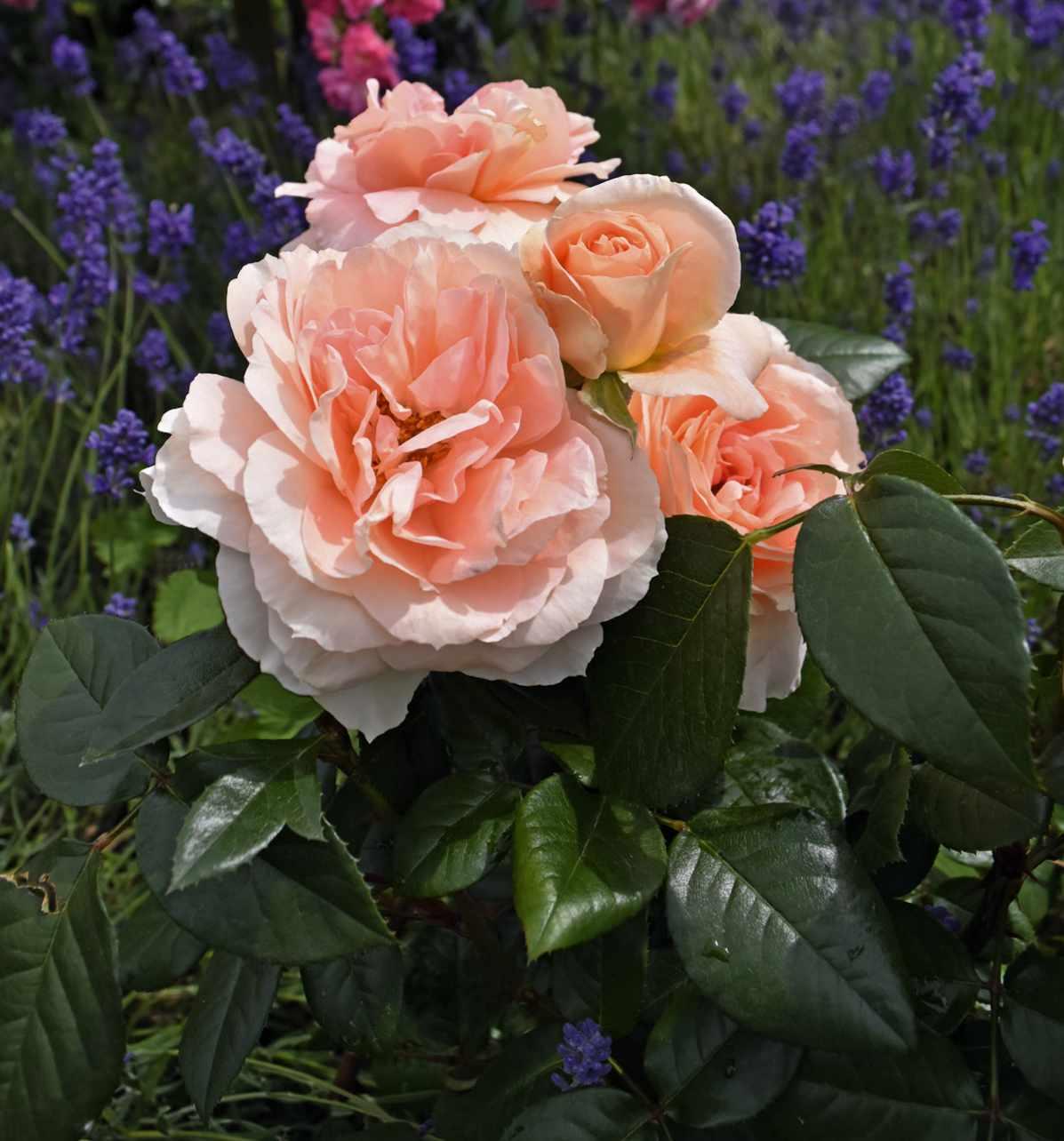
Find more ideas for organising your garden tools by scanning this QR code with your phone camera, or visit gardensillustrated.com /organise

20
JUNE 2023 DIG IN NEWS
gardensillustrated.com
LUXURY
Gardening Tote, £395, Anya Hindmarch, 020 7501 0168, anyahindmarch.com
STYLISH Grey Ticking Gardener’s Tool Bag, £32, Sophie Conran, sophieconran.com
CLASSIC Gardening Caddy Bag, £69, Genus, 020 3617 1166, genus.gs
IMAGE COURTESY OF SUGI
Garden Masterclass is Annie Guilfoyle and Noel Kingsbury and we offer a unique education portal for garden and landscape people.


We seek out experts and innovators, whether well-known or waiting to be discovered. Working with them we organise live one-day workshops in garden venues up and down the British Isles.

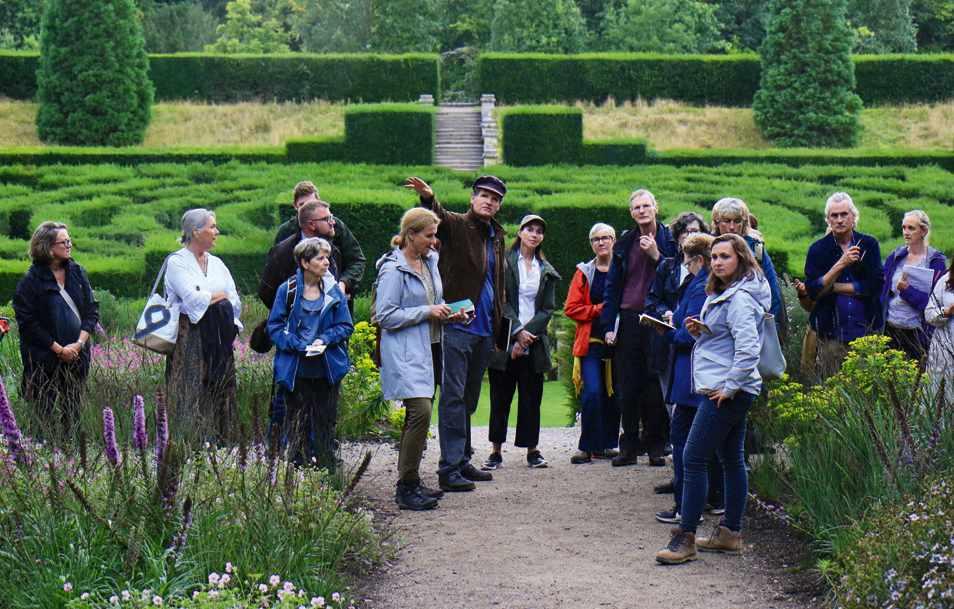
Many of these are recorded, allowing others to share in the experience.
We produce educational webinars, which are recorded: there are now over seventy hours available from our website. We offer online courses for landscape and horticulture professionals and dedicated home gardeners.

We commission films about exceptional gardens and their creators.
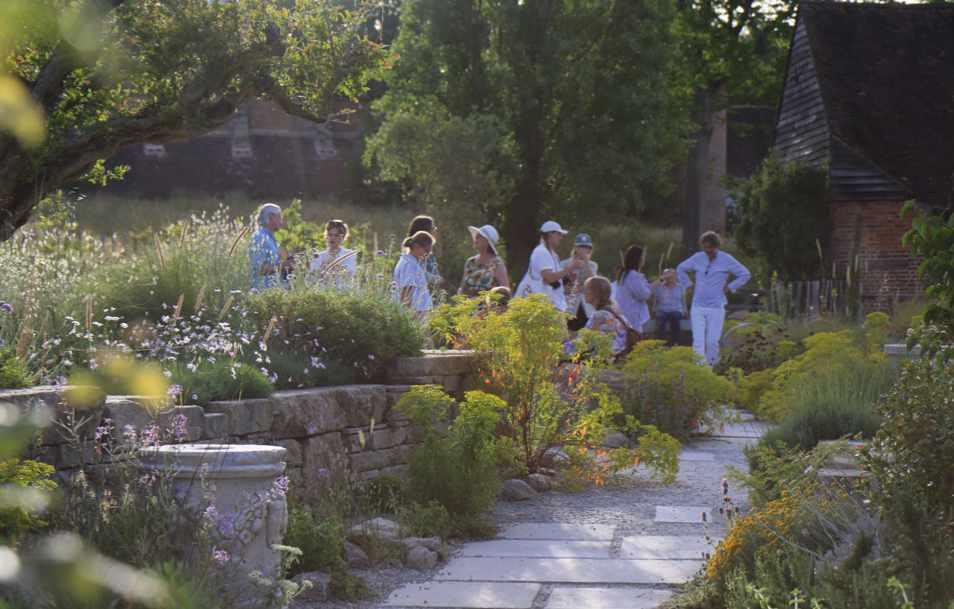
Our membership scheme gives access to exclusive live and web-based events, discounts on webinars and recordings and access to an extensive online library of garden programming in video and podcast format.
Some of what we do is free! Each week we produce a recording which is placed on YouTube for free viewing, before archiving for members – who now have access to over two hundred hours of compelling conversations and inspirational interviews.
In September we have a two-day conference at Chatsworth entitled: Growth and change - managing a dynamic landscape into the future
Live events this summer include the following tutors: Annie Guilfoyle; Carolien Barkman; Jo McKerr; Marina Christopher; Luc Engelhard; Claire Greenslade; Dan Pearson; Troy Scott-Smith; John Little; Richard Scott; Tom Stuart-Smith; James Hitchmough; Michael Walker; Katy Merrington; Nigel Dunnett; John Grimshaw; Lizzie Bamforth; Steve Porter; Jimi Blake; Andy Sturgeon; Marco Scano; Sarah Eberle
All dates and information are correct at time of going to press.
Please check our website for all up to date information and events or contact us by email: gardenmasterclass.org | gardenmasterclass@gmail.com
BY
SUPPORTED
GA R DENS

when you subscribe
Save
to the digital edition




A must-have read for passionate gardeners, Gardens Illustrated magazine provides a unique insight into the world’s most beautiful gardens, expert advice and planting ideas. ENJOY OUR PREMIUM APP EXPERIENCE NOW buysubscriptions.com/ gardensillustrated
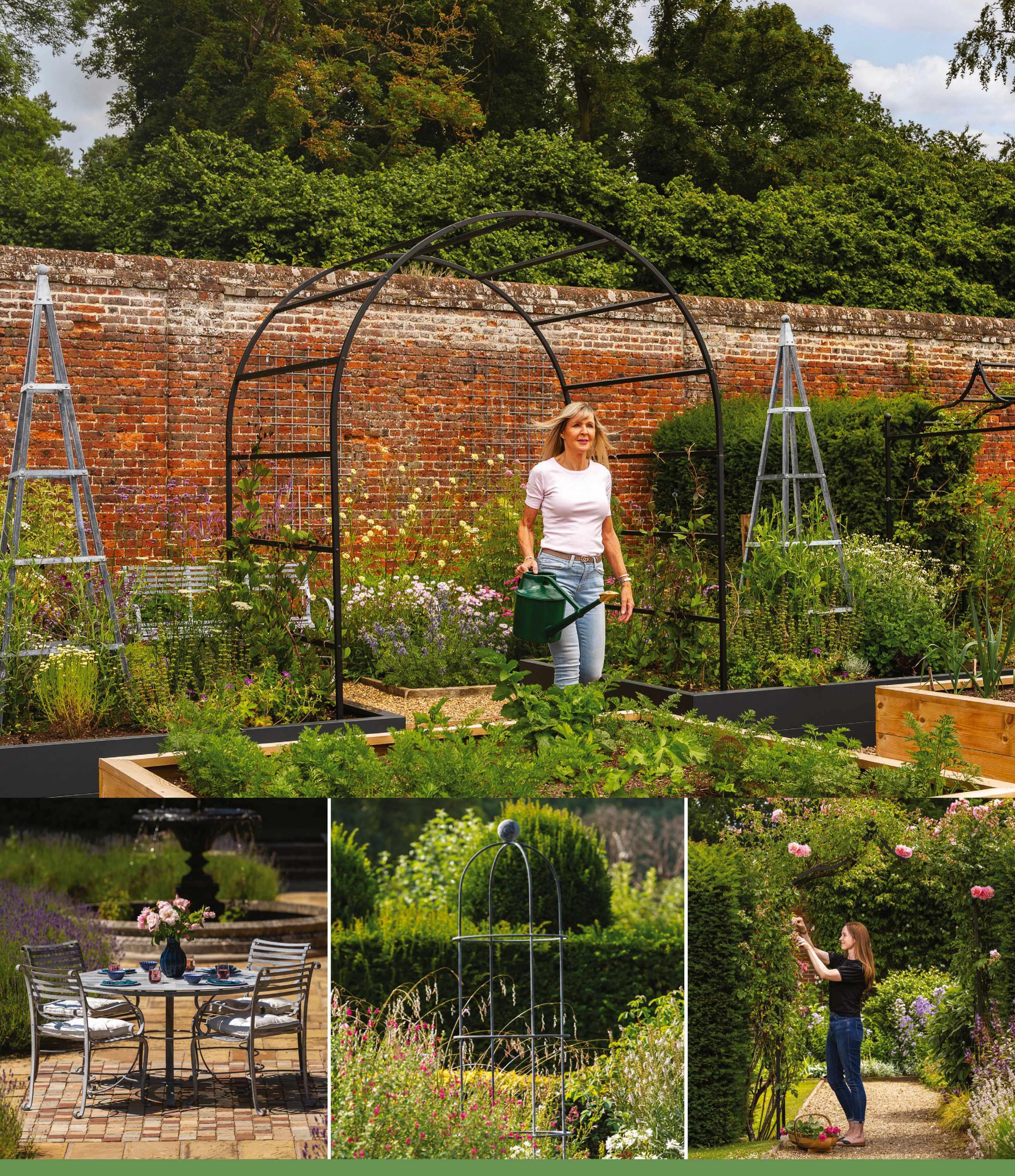

0333 400 1500 (local rate) www.harrodhorticultural.com 10% OFF QUOTE: 23ADGL5 BESPOKE DESIGN SERVICES AVAILABLE • Traditional Steel Furniture • Arches • Pergolas • Obelisks • Planters • Trellises & Supports • Fruit Cages • Raised Beds • PLUS MORE SCAN HERE
KITTED OUT




For beautiful topiary and trimmed, healthy hedges
COMPILED BY NIKI GOSS

JUNE 2023 gardensillustrated.com 25
1. Box Tree Shear, £69.99, wolfgarten-tools.co.uk 2. Henchman Professional Tripod Ladder, 3 adjustable legs, 3m, £489, 0808 506 4830, henchman.co.uk
DIG IN SHOPPING 3 4 6 5 7 1 8 2
3. Safety Glasses – Gardening Goggle Glasses, £12.99, 01258 489161, titan-pro.co.uk 4. Stihl Leather Work Gloves, small, £19.99, amazon.co.uk 5. Topbuxus XenTari Biological Box Moth Control, £19.95, amazon.co.uk 6. Summer Gardening Visor, £29, 020 3617 1166, genus.gs 7. Cobra H5024V 24v Cordless Hedgetrimmer, 50cm blade, £89.99, 0115 964 5915, cobragarden.co.uk 8. Kent & Stowe Topiary Frame Pyramid, H 31cm x W 19cm x D 19cm, £9.99, amazon.co.uk



 1. Château Planters, powder-coated steel and accoya wood, from £1,500, 01423 400100, ornamenti.co.uk
1. Château Planters, powder-coated steel and accoya wood, from £1,500, 01423 400100, ornamenti.co.uk
26 gardensillustrated.com JUNE 2023 DIG IN SHOPPING 2 3 4 5 6 7 1
2. Moffat Workwear Dungarees, dark olive, £140, finisterre.com 3. Pruning Sheet, £24, 01747 445059, niwaki.com 4. Tool Maintenance Oil, camellia and coconut oil, 100ml, £12.50, 01553 775758, norfolknaturalliving.com 5. Stalon Boots, nubuck leather and cork, mocha, £160, 020 7862 1725, birkenstock.com 6. Topiary Shears, short, £179, 01747 445059, niwaki.com 7. Empathy RHS Liquid After Plant Evergreen Feed & Biostimulant, 1 litre, £8.49, 01344 578000, crocus.co.uk
FSA 60 R GRASS TRIMMER. CORDLESS POWER. BY STIHL.
Long working times, plenty of power and easy to use. Whether it‘s mowing, sawing, trimming or clearing, the STIHL AK System has the flexibility to take on any challenge - all thanks to an interchangeable battery that can be used with any tool in the range.
Find out more at shop.stihl.co.uk or your local STIHL Approved Dealer.
 Cordless POWER. BY STIHL.
ONE BATTERY. MANY TOOLS.
Cordless POWER. BY STIHL.
ONE BATTERY. MANY TOOLS.
ƒ
EREMURUS X ISABELLINUS ‘CLEOPATRA’
In early summer, these tangerine spires make wonderful bold statements in our borders as they rise through the fresh, wispy foliage of Stipa tenuissima and self-seeded, white-flowered milk thistle Galactites tomentosa ‘Alba’. Eryngium x oliverianum or E. x zabelii would make a good perennial alternative to the latter, while adding Verbena bonariensis to the mix can add colour throughout summer. Foxtail lilies, or desert candles as they’re also known, need excellent drainage to thrive, but most struggle in our Gravel Garden. This one is the exception.
Height and spread 1.2m x 30cm.
Origin Garden, E olgae x E stenophyllus cross (parent species from Central Asia).
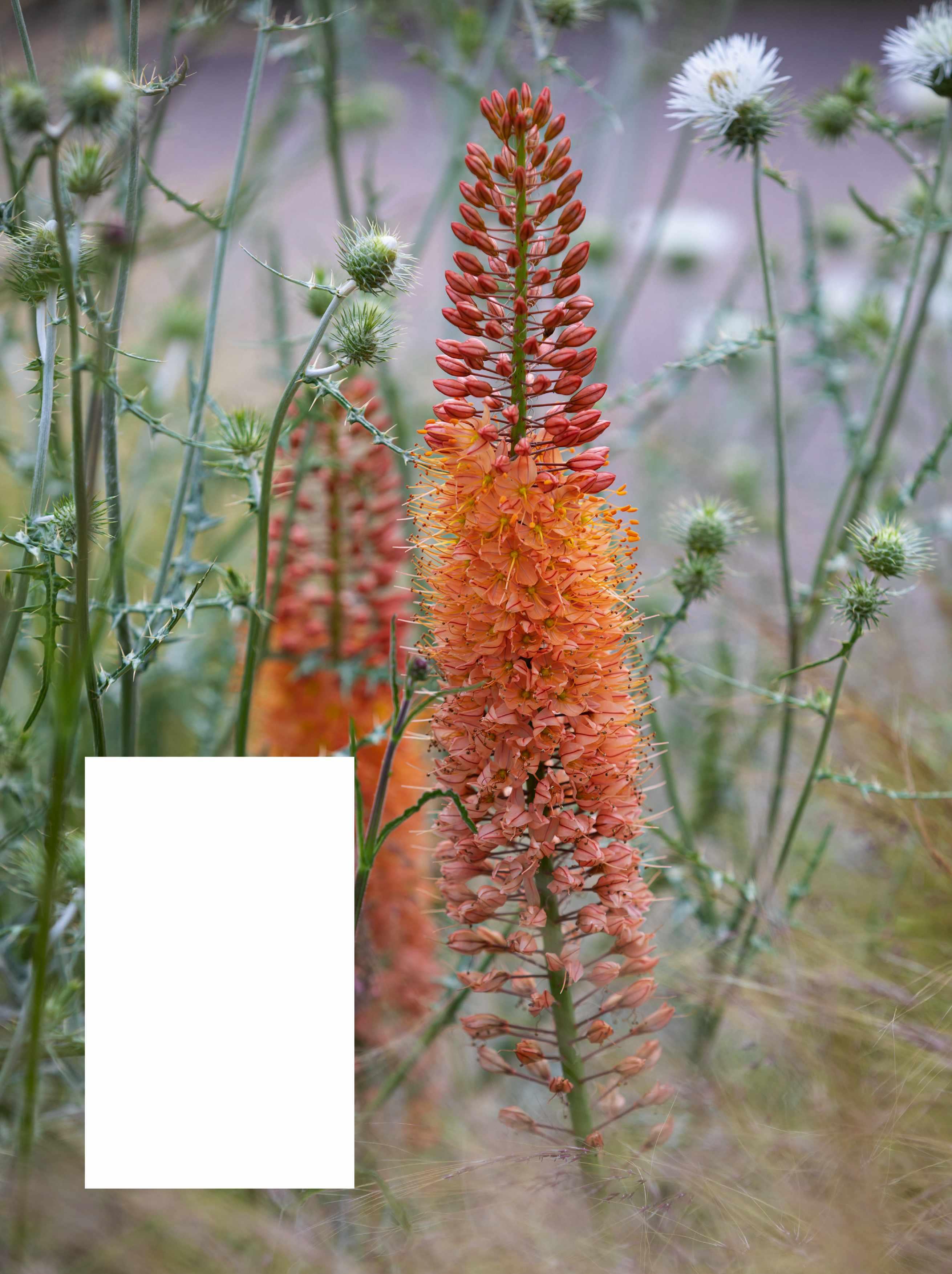
Conditions Well-drained soil; full sun.
Hardiness RHS H6, USDA 5a-8b†
Season of interest June.
June plants
PHOTOGRAPHS RICHARD BLOOM

OENOTHERA ‘LEMON SUNSET’
This lovely evening primrose starts out soft lemon-yellow, before turning a light peachy-red as the saucer-shaped blooms mature. A favourite here at Beth Chatto’s, forming upright clumps with somewhat lanky stems. This short-lived perennial is easy to grow, even in poor, sandy soil, and useful for filling empty gaps. The easiest way to encourage a continuous flush of flowers is to deadhead at regular intervals. Simply grab a handful of stems (we often do this just as the last buds opens) and trim the stalks, roughly by half, down to the first leaves. Self-seeds freely.
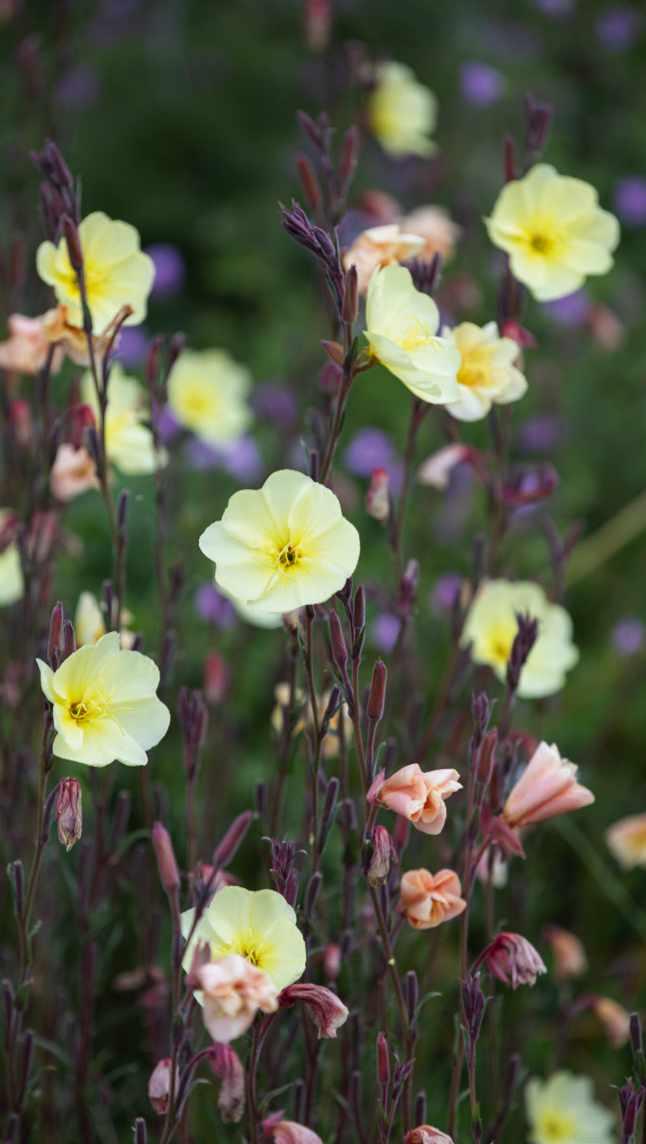
Height and spread 1m x 20cm.
Origin Garden (species Argentina, Chile).
Conditions Well-drained soil; full sun. Hardiness RHS H4, USDA 5a-9b.
Season of interest June – August.
PRIMULA BULLEYANA
This classic candelabra primula was named after Arthur K Bulley, the British cotton trader and plantsman who sent George Forrest on his first plant-hunting expedition to Yunnan, China in 1904. As I stop and admire the whorls of rich-orange flowers, so readily available these days, I send a thought of gratitude to the man who set off on a long, perilous journey, filled with disasters, only narrowly escaping with his life. Very effective near water, surrounded by lush foliage plants, but will also suit the edge of a woodland as long as there’s adequate moisture. AGM*.

Height and spread 50cm x 45cm.
Origin China.
Conditions Moist and humus-rich soil; partial shade or full sun if the soil is moist.
Hardiness RHS H7, USDA 5a-8b.
Season of interest May – July.
LILIUM ‘CLAUDE SHRIDE’

Martagon lilies are tougher than their demure appearance suggests but will take some patience; they resent disturbance, sulking when they’re moved, and often fail to bloom in their first season or so. However, their exquisite blooms, with distinctly swept-back petals and prominent ginger anthers, add a touch of elegance to the border, making it well worth the wait. While dappled shade suits paler colours, I find that dark mahogany-bloomed hybrids such as this need to be placed with their heads in the sun, to bring out their brooding hues.
Height and spread 1-1.5m x 30cm.
Origin Garden, L martagon x L hansonii cross (parent species Korea and Eurasia).
Conditions Moist but well-drained soil; full sun to partial shade.
Hardiness RHS H6, USDA 3a-8b. Season of interest June.
DIG IN PLANTSPERSON’S FAVOURITES
*Holds
an Award of Garden Merit from the Royal Horticultural Society. † Hardiness ratings given where available.
In early summer, head gardener Åsa Gregers-Warg is spoilt for choice with a fabulous mix of richly coloured and delicate flowers, fabulous foliage and silky tactile grasses
JUNE 2023 gardensillustrated.com 29
Åsa Gregers-Warg is head gardener at Beth Chatto’s Plants & Gardens in Essex bethchatto.co.uk
PERSICARIA MICROCEPHALA ‘RED DRAGON’

A superb foliage plant with sumptuous, lance-shaped, deep-burgundy leaves, adorned with a silvery, chevron marking in early summer. Small, rounded clusters of relatively insignificant-looking, white flowers appear in late summer. The intensity of the foliage colour changes as the season progresses, with the leaves taking on green tones as they mature. Unlike most other persicarias, it is clump forming, with an upright, gently arching habit. To prevent it from becoming too gangly, pinch out the young shoots when they’re around 25cm tall. AGM.
Height and spread 1-1.5m x 50cm-1m. Origin Garden (species China).
Conditions Moist but well-drained soil; full sun to partial shade.
Hardiness RHS H4, USDA 6a-8b.
Season of interest Spring – autumn.
PIMPINELLA MAJOR ‘ROSEA’
I’ve got a soft spot for umbellifers and find them incredibly versatile. Ammi majus, Orlaya grandiflora and Bupleurum falcatum are ideal for creating a relaxed, informal feel, while statuesque Angelica archangelica, Ferula gigantea and Dorema ammoniacum give height and drama to the border. This enchanting cow parsley relative will happily mingle with other plants and looks great repeated in drifts throughout the border. It’s a reliable early summer performer that suits naturalistic and more formal gardens alike. Strong sunlight will bleach the sugary-pink colour quicker, so we plant in part shade.

Height and spread 1-1.5m x 50cm.
Origin Garden (Europe).
Conditions Most soils; full sun to partial shade.
Hardiness RHS H7, USDA 5a-8b.
Season of interest Early summer.
Places to visit
Åsa’s recommendations for places to see seasonal plants at their best
Be sure to check opening times. Some garden visits may need to be pre-booked.
I must confess I hadn’t heard of Hannah Peschar Sculpture Garden until fairly recently. Tucked away in a woodland valley at the foot of Leith Hill, Surrey, this hidden gem (it’s easy to miss the entrance sign) beautifully explores the synergy between art and nature. The garden, which can be described as a controlled wilderness guided by
a gentle hand, was designed and planted by the founder’s husband, renowned landscape designer Anthony Paul. The combination of lush planting, with an emphasis on texture and form, and water, provides a tranquil setting for the carefully curated exhibition of contemporary art. It struck me how the balance between the two has found
LEUZEA CENTAUROIDES
Something of a Marmite plant, but I find its knobbly buds, covered in thin, papery scales, beautiful. It makes a bold statement in the border with its attractive, silver-grey, cut foliage, curious-looking buds and thistle-like flowers. Visitors often mistake it for a small artichoke. I first knew it as Centaurea pulchra ‘Major’, but it has had several name changes over the years, so you may also know it as Stemmacantha centauroides or Rhaponticum centauroides. Cut back after flowering to encourage a fresh flush of foliage. Best in full sun and drought tolerant once established.
Height and spread 1.2m x 50cm.
Origin France and Spain.
Conditions Moderately fertile, well-drained soil; full sun.
Hardiness RHS H5.
Season of interest June – July.
that sweet spot where neither the sculptures nor plants dominate or fight for attention. Instead, much care has gone into placing the pieces where they complement and enhance one another. An inspiring and unique place. Open between April and October. Tickets must be pre-booked. Hannah Peschar Sculpture Garden, Black and White
Cottage, Standon Lane, Ockley, Dorking, Surrey RH5 5QU. Tel 01306 627269, hannahpeschar sculpture.com
If you’ll excuse a little self-promotion, June is a one of the best months to visit us here at Beth Chatto’s Plants & Gardens, with all the plants giving their best. This year, however, June is something of a poignant month for us as we
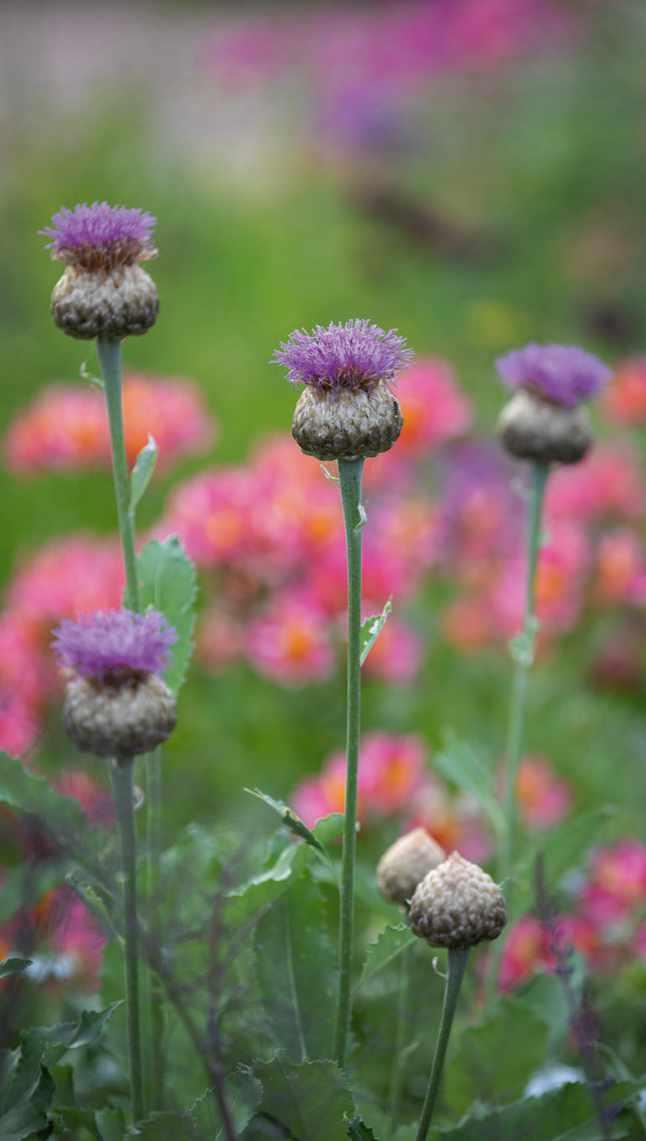
STIPA BARBATA
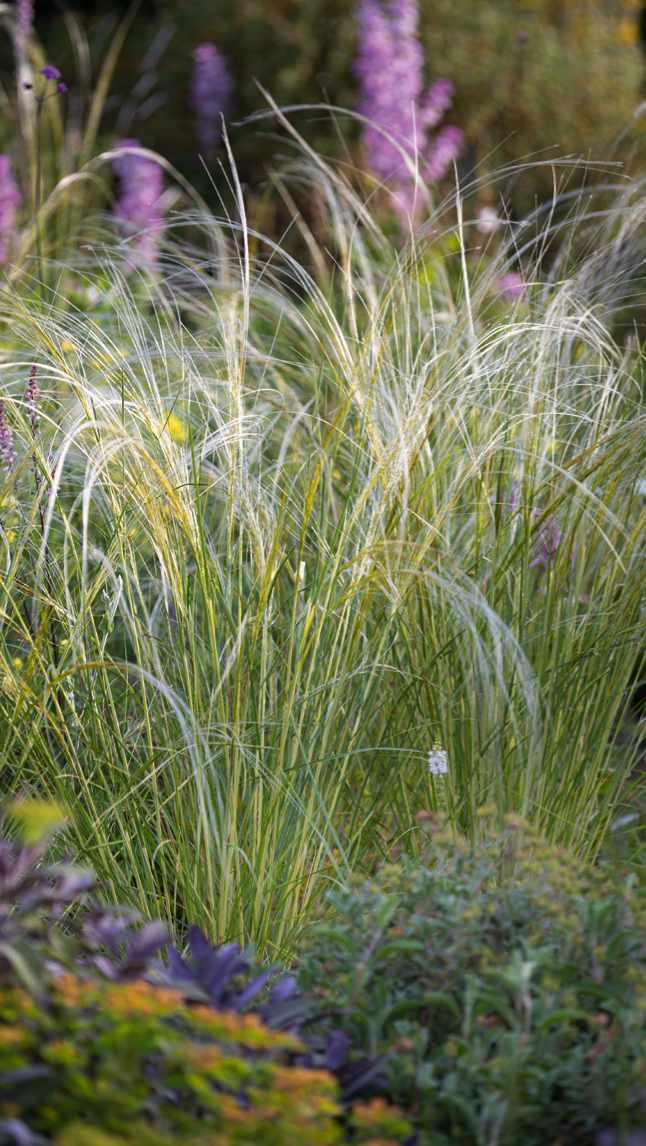
An exceptionally beautiful grass, providing a fleeting yet spectacular display during a few weeks in midsummer. The long, silky awns gracefully toss and turn in the lightest breeze, and look particularly magical in the evening when backlit by soft, golden sunlight. Each awn holds a single, sharp-tipped seed. When ripe, the wind carries the seed away and you’ll find it drilling itself into the ground, like a corkscrew, where it lands. When not in bloom, there’s not much to the plant, so make sure to add something else nearby that will give you late-summer interest.
Height and spread 60-90cm x 30cm.
Origin Southern Europe, northern Africa, and temperate western Asia.
Conditions Well-drained soil; full sun.
Hardiness RHS H4, USDA 7a-10b.
Season of interest June – July.
SOLANUM LAXUM ‘CRÈCHE DU PAPE’
One of my favourite climbers. A vigorous scrambler, with almost-black, twining stems and a profusion of icy-blue flowers with yellow stamens, borne in open clusters. In Sweden, I could only dream of planting such an exotic climber, but in this part of Essex, winters tend to be mild. Even so, a hard frost will occasionally cause the semi-evergreen leaves to drop. Regrows quickly from the base if it freezes to the ground. Best grown on a south- or west-facing wall, or a pergola where it is sheltered from cold, drying winds.

Height and spread 2.5-4m x 2.5-4m. Origin Garden (species Brazil, Argentina, Ecuador, Paraguay and Uruguay).
Conditions Humus-rich, well-drained soil; full sun, sheltered site.
Hardiness RHS H4, USDA 9a-11.
Season of interest June – September.
VERONICASTRUM SIBIRICUM F. GLABRATUM

A little like Veronica longifolia ‘Blauriesin’, but on steroids, adding instant impact to the border. Thick tapers of intensely violetblue flowers, with gently curved tips, are held on sturdy stems above whorls of handsome, lance-shaped, mid-green leaves. In summer the nectar-rich flowers buzz with life, attracting bees and other pollinating insects. A relatively new addition to our gardens, where it has proved robust. The attractive seedheads last well into autumn and winter, providing a strong vertical aspect and long season of interest.
Height and spread 1.5-2m x 70cm.
Origin Japan and Sakhalin Island, Russia. Conditions Humus-rich soil; full sun to partial shade.
Hardiness RHS H7, USDA 3a-8b.
Season of interest June.
mark what would have been Beth’s 100th birthday on 27 June. Beth was at the forefront of ecological and sustainable gardening. She was also a natural educator and enjoyed sharing her knowledge, so it’s fitting that in this, her centenary year, we are making the video recordings of last September’s Beth Chatto Symposium, Rewilding the Mind, available to everyone
free of charge. You can find all the videos on our website, along with details of the events we have planned to celebrate her life throughout her centenary year. There’s no symposium this year, but we’re delighted to announce that our friend and patron, the fabulous plantswoman
Carol Klein, is delivering the annual lecture in support of the Beth Chatto Education Trust on 21 September at the
University of Essex. Beth Chatto’s Plants & Gardens, Clacton Road, Elmstead Market, Colchester, Essex CO7 7DB. Tel 01210 822007, bethchatto.co.uk
Carol was someone Beth much admired. When she was no longer able to attend the Chelsea Flower Show, Beth was always keen to hear all about the displays of her two favourite nurseries –Carol Klein’s and Jekka
McVicar’s. Jekka, the official Queen of Herbs, has an encyclopedic knowledge of growing and using herbs, and this month she hosts Jekka’s HerbFest 2023, a fabulous three-day event (30 June – 2 July) with expert talks, workshops, cookery demonstrations and guided tours. Jekka’s is a family business, like our own, with the same sustainable and environmentally friendly
approach to growing, and her HerbFest offers a rare opportunity to visit the farm, with more than 400 culinary and medicinal herbs. Jekka’s Herb Farm, Rose Cottage, Shellards Lane, Alveston, Bristol BS35 3SY. Tel 01454 418878, jekka.com
For a chance to win tickets to Jekka’s HerbFest, head to gardens illustrated.com/jekka
DIG IN PLANTSPERSON’S FAVOURITES JUNE 2023 gardensillustrated.com 31
GI
CLAIM A FREE PRODUCT
Claim FREE: 1x BL1850B or 2x BL1850B or 1x DMP180Z or 1x MR002GZ01 with Selected LXT Garden Machines



Claim FREE: 1x BL4025 or 1x MP001GZ or 1x MR002GZ01 with Selected LXT Garden Machines
18V LXT: DCU180PT2, DCU180PTX4, DCU180PTX3, DLM330RT, DUB184RT, DUB186RT, DUC254RT, DUC307RTX2, DUH523RT, DUH502RT, DUH601RT, DUH604SRT, DUH751RT, DUH754SRT, DUM111RTX, DUM604RTX, DUN461WRT, DUN500WRTE, DUN600LRTE, DUR181RT, DUR189RT, DUR190LRT8, DUR190URT8, DUR191LRT8, DUR191URT8, DUR192LRT, DUR194RTX2, DUX18RT. 18Vx2 LXT: DDG460T2X7, DLM382CT2, DLM382PG2, DLM432CT2, DLM432PG2, DLM460PT4, DLM460PG2, DLM462PT4, DLM462PG2, DLM480CT2, DLM481CT2, DLM530PT4, DLM530PG2, DLM532PT4, DLM532PG2, DLM533PT4, DLM533PG2, DLM538CT2, DLM539CT2, DUA301PG2, DUA301PT2, DUB362PG2, DUB362PT2, DUB363PG2V, DUB363PT2V, DUC256PG2, DUC256PT2, DUC306PG2, DUC306PT2, DUC353PG2, DUC353PT2, DUC305PG2, DUC305PT2, DUC355PG2, DUC355PT2, DUC405PG2, DUC405PT2, DUR368APG2, DUR368APT2, DUR368LPG2, DUR368LPT2,
Claim online @ makitauk.com/redemption
Claims can be registered on-line from 1st February 2023 and must be registered within 28 days of purchase for qualifying models. Qualifying models must be purchased by 30th June 2023 to qualify and registered within 28 days.
DUR369APG2, DUR369APT2, DUR369LPG2, DUR369LPT2, DUX60PG2, DUX60PT2. 40V XGT: DG001GD202, LM001GT204, LM002GT204, UA004GD203, UB001GD202, UC002GD202, UC003GD202, UC011GT201, UC014GT201, UC015GT201, UC016GT201, UH004GD201, UH005GD201, UH006GD201, UH007GD201, UH013GD202, UH014GD202, UR002GD202, UR003GD202, UR006GD202, UR008GD202, UR012GT203, UX01GD202.
DMP180Z 18V LXT Inflater Body Only BL1850B 18V LXT 5.0Ah Battery BL4025 40V XGT 2.5Ah Battery MP001GZ XGT 40V XGT Inflator Body Only
MR002GZ01 Bluetooth Radio Body Only
ADDED INTEREST?
Columnist Ken Thompson urges caution over so-called miracle garden products; they’re not always all they’re cracked up to be
ILLUSTRATION JILL CALDER

There is seemingly no end to miracle additives on the market, all offering gardeners the appealing promise that they will make your plants bigger or healthier – or possibly even both. Often there is little, if any, way of knowing whether or not they work –the claims made by these products may simply not have been adequately tested, and sometimes it’s hard to tell what’s in them. There are at least three that should make you pause for thought before parting with your hard-earned cash: rockdust, biochar and mycorrhizal fungi.
Rockdust
Apparently there’s almost nothing this finely ground volcanic rock can’t do, including producing bigger yields, healthier crops, better flavour and improved resistance to pests, disease and drought. Fortunately, there have been two big, well-designed scientific studies of the effects of rockdust, one in Scotland and the other in Sweden, and both found exactly the same: nothing. No effect on yield, plant nutrient content or soil chemistry.
These studies also show why they found nothing. As the Scottish analysis puts it, ‘a high degree of rock weathering was required to release small
JUNE 2023 gardensillustrated.com 33
DIG IN WISE WORDS
quantities of trace elements from rockdust samples’. In short, it’s not easy to get anything out of rockdust, and even when you do it’s mostly sodium, with small amounts of calcium and even smaller amounts of other constituents. So the most rockdust might sometimes do is raise soil pH a little, although in the Scottish study it didn’t.
None of this is terribly surprising when you think about it. After all, soil is mostly rock already, so adding a bit more was never likely to make much difference. But looking on the bright side, rock is pretty inert stuff, so if you still feel like using it, it’s very unlikely to do any harm.
Biochar
What about biochar? Biochar (which is basically charcoal) is more complicated than rockdust, because it can be made from almost any kind of organic material, and the result is as variable as the material you started with. Not only that, but there are countless claims relating to its beneficial qualities, and its effects on, say, soil microbes or heavy metals are huge research fields on their own. So, to keep things simple, let’s focus on its effects on plant growth; first, because that’s probably what gardeners are most interested in, and second, because those marketing biochar to gardeners clearly see better plant growth as its main selling point. There’s also been a great deal of research on the subject.
First, the good news. Across all studies, biochar increases crop yield a little, on average. But closer examination reveals that all the studies reporting improved yield are in the tropics. In temperate climates, it doesn’t do anything. Not only that, even in the tropics the effect of biochar is very variable.
Tropical soils are typically both acidic and low in nutrients, and biochar can potentially fix these problems, as long as the biochar itself is both nutrientrich and alkaline, which is sometimes the case. In other words, biochar can sometimes have a beneficial liming and fertilising effect, in soils that need lime or fertiliser (although it would be simpler and cheaper just to add lime or fertiliser). But low-nutrient biochar (made from wood, for example) doesn’t do anything, and acid biochar is positively harmful.
There’s also some evidence that biochar might help to retain water on coarse, free-draining soils that would otherwise be at risk of suffering from drought. But this is just one of the symptoms of a lack of organic matter, and garden soils are usually adequate in this respect already. In any case, you would probably do more good by just adding the original organic matter as a mulch, rather than wasting time and energy turning it into biochar.
Mycorrhizae
We’re on safer ground with mycorrhizae, a symbiotic association between the roots of plants and beneficial fungi, if only because around 85 per cent of all plants are normally mycorrhizal. Mycorrhizae effectively extend the plant’s root system and are very important for the uptake of nutrients, especially phosphorus. Which raises the interesting question: if mycorrhizae are good for plants, surely it must be a good idea to buy some more?
Well, maybe, but maybe not. Mycorrhizae are everywhere, so most garden soils will already contain a diverse collection, either as the active fungus or as dormant spores, which means most plants will quickly recruit the mycorrhizae they need. On top of that, there are at least 300 different species of mycorrhizae, yet the typical commercial product contains only a few, and sometimes only one. And should you ever bother to check, plants arriving direct from the nursery often turn out to be mycorrhizal before you even plant them.
So maybe it’s not surprising that when Which? Gardening tested mycorrhizae recently, using several different brands at different sites, it found that sometimes they worked, but often they didn’t. The consumer rights organisation concluded that mycorrhizae can’t be guaranteed to add much to what’s in the soil already, and you might be better off just trying to improve your soil fertility by adding plenty of compost.

I’ll leave the last word on the subject to tree expert Peter Thomas: if you want to make sure a new plant gets the mycorrhizae it needs, ‘it is far better to take a small amount of soil from beneath a nearby successful tree to act as an inoculant’. This is more likely to have the appropriate local fungi and is, of course, free. ■
• Dr Ken Thompson is a plant ecologist and myth buster, who is known for his scientific and practical approach to gardening. He is author of books on invasive species, biodiversity, wildlife gardening, weeds and compost making.
34 gardensillustrated.com JUNE 2023
DIG IN WISE WORDS
Mycorrhizae can’t be guaranteed to add much to what’s in the soil already, and you might be better off just trying to improve your soil fertility by adding plenty of compost

01243 684 158 lazysusan.co.uk Maintenance Free Garden Furniture Designed to last a lifetime Excellent
THE FINEST CUT OF ALL
ROLLING WITH THE TIMES
SINCE 1921
Create those all important lawn stripes with ATCO’s range of petrol Liner roller mowers.
Powered by reliable, easy-to-start STIGA and Honda engines that deliver precision cutting every time. With a choice of cutting widths, large collectors and innovative cutting blades the grass is definitely greener on your side of the fence!
Choose ATCO for The Finest Cut of All.

View the full range on our website.
back your mower!
Simply register your new purchase at atco.co.uk for a chance to WIN BACK the cost of your lawnmower! (T&C’s apply)


WIN
ATCO.CO.UK
CECILY WITHALL
Kew’s first female climbing arborist since the 1980s, Cecily is part of a team that maintains the botanical garden’s impressive collection of 12,000 trees

Earliest memory of trees Sitting on my dad’s shoulders as a little girl, walking through our local woods in East Lothian, Scotland. Beech, pine, birch and maple were common in the coastal woodlands and we often collected bark, leaves and needles for the collages and Christmas wreaths that we would make on the kitchen table with my mum.
Career journey I began my studies in Scotland at the Royal Botanic Garden Edinburgh, with a diploma in Horticulture with Plantsmanship. It was my grounding within the industry. I then did work experience with Kew’s tree unit and climbed with the team for the first time in 2018. I was hooked. I was offered a two-year apprenticeship within the team and began my training to become a climbing arborist. In 2021, I became a full-time climbing arborist for Kew.
Favourite landscape Benmore Botanic Gardens in Argyllshire, Scotland. Avenues of giant redwoods line the way to mountain slopes clothed in Chilean and Chinese species. While the weather is often ‘dreich’, the glow of a ruby-leaved acer in the mist will stay with you for a lifetime. Biggest challenge facing gardeners today Land-based industries such as horticulture and arboriculture are often perceived as being poorly remunerated, and many people are put off by this. I believe that a job outdoors offers more mental and physical wealth than any other vocation and we should be advocating for this.
In what direction do you see horticulture heading?
Women have been, and continue to be, hugely successful within horticulture, and this has inspired many others to grow and learn within the industry. Arboriculture is still predominantly a male-led industry, although this is slowly changing, along with the associated stigma that it’s all just a testosterone-fuelled chainsaw frenzy. I’d like to raise awareness of it as an accessible profession for women and ensure that schoolchildren learn that it’s available to them as a career. It’s my dream job, but it took a while to realise it existed, and I want to change this for future generations.
How do you remind yourself what needs doing next?
All of the trees at Kew are mapped by their GPS location and stored on an app used by the tree unit. Each tree has a stored history (collection date, past pruning works and so on) alongside a maintenance schedule. Tasks mainly consist of dead wooding; we climb the tree to give it an aerial inspection, looking at overall health and removing any dead or diseased material.
Contact c.withall@kew.org
For information on visiting the Royal Botanic Gardens, Kew, go to kew.org
PORTRAIT JASON INGRAM
JUNE 2023 gardensillustrated.com 37 PEOPLE GARDENING TALENT
I believe that a job outdoors offers more mental and physical wealth than any other vocation and we should be advocating for this


IN BRIEF
What Private garden and nursery of Peter Korn and Julia Andersson. Where Sweden.
Size Three-and-a-half acres. Soil Sand beds over alkaline soil. Climate Cold and windy winters with mild summers and light to moderate rainfall.
Hardiness zone USDA 7a.
Plantsman Peter Korn’s garden, near the southern Swedish city of Malmö, is a fantastical meadow grown exclusively on sand. Here, feathers of Stipa pulcherrima contrast with the vivid blues of Eryngium x zabelii ‘Big Blue’ and E bourgatii, against the acid-yellow of an unidentified Euphorbia. Along the front of the beds, fading spikes of Salvia dumetorum complement the deep-purple heads of Allium ‘Miami’.

40 gardensillustrated.com JUNE 2023
True grit
Swedish plantsman Peter Korn is a pioneer of growing in sand, and his glorious new garden near Malmö is testament to its success
WORDS JONNY BRUCE PHOTOGRAPHS CLAIRE TAKACS
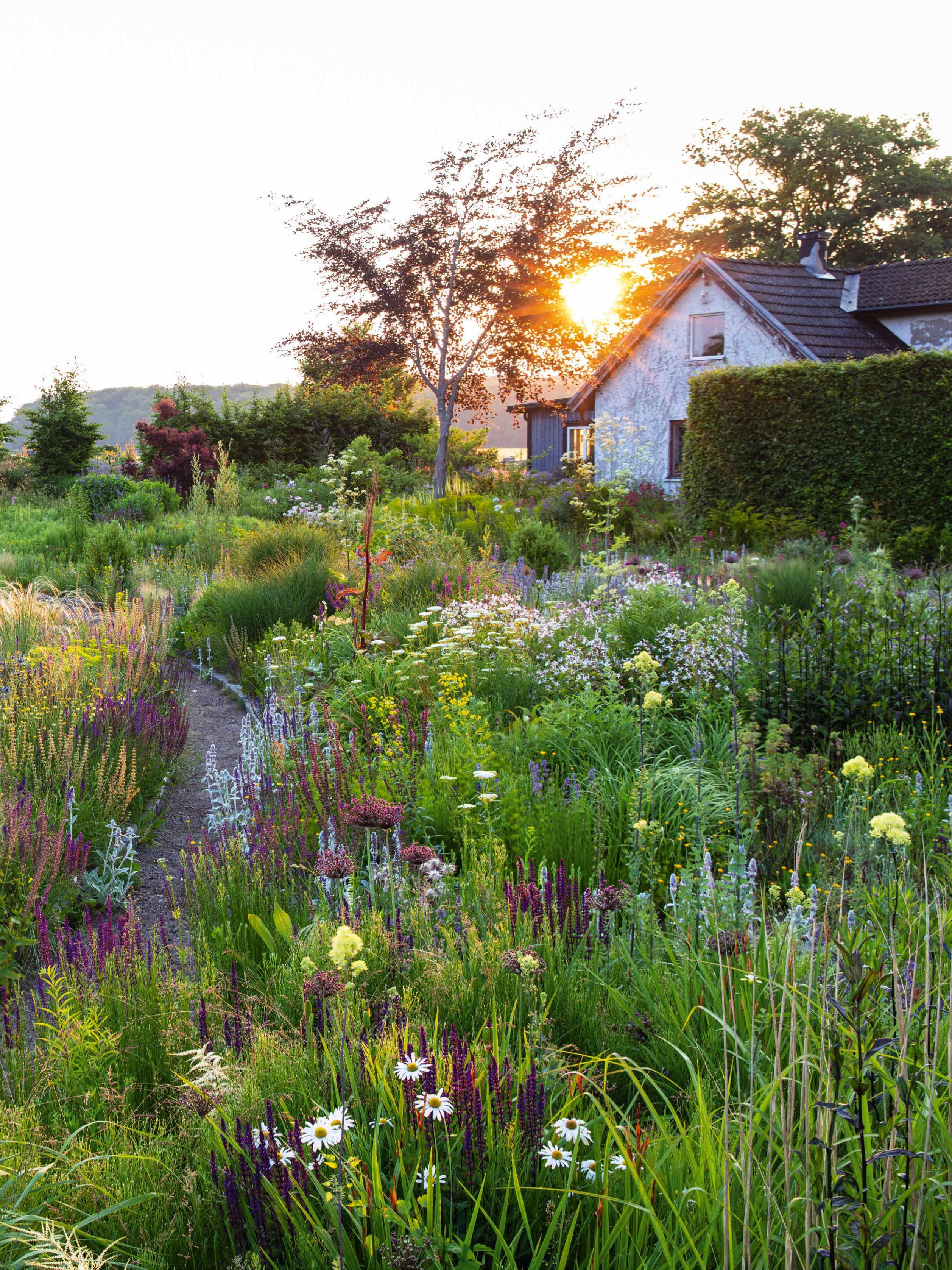
GARDEN INTERNATIONAL
Eight years ago, Peter Korn and Julia Andersson moved to their current house in southern Sweden, where they have created not only a beautiful home but also a nursery, Klinta Trädgård, that provides plants for their numerous public planting projects. These commissions, as with much of their home garden, are planted in pure sand, and Peter has become well known as a pioneer of this approach, which offers a range of benefits such as less watering, staking and weeding. “Think of a hot sandy beach,” says Peter. “The surface can be so hot that you can’t walk on it, but dig in your toes and a few centimetres down it is always cool and moist.”

Plants access this limited moisture by producing larger root networks and although there is an abundance of mycorrhizae in sand, the relative lack of available nutrients means that plants don’t grow as lushly – hence less need for staking. Helianthus salicifolius, for example, gets so tall on regular soil that it inevitably flops, whereas in sand it remains erect at a more manageable two metres high. This slower – but harder growth – means short-lived plants often persist for years, and in many cases plants literally develop ‘a thicker skin’ meaning they are less susceptible to pests such as aphids and in turn the diseases that are spread through these pests.
However, plants first grown in conventional potting compost often struggle to establish in sand. As Peter and Julia’s number of public commissions increased, they needed more sand-grown plants,
for white-flowering Erodium guttatum to thrive. The couple encourages self-seeding annuals, such as the bright-pink Silene armeria, to find their place alongside cultivated perennials such as Delphinium ‘Morgentau’.
42 gardensillustrated.com JUNE 2023 GARDEN INTERNATIONAL
Stonework sculpted by Peter and Julia provides cracks and crevices

which wouldn’t suffer this ‘transplant shock’. Moving to Klinta offered the opportunity to expand the nursery and for garden and nursery to work together symbiotically, with the various borders acting as a source of propagation material for the nursery, and the nursery returning a steady stream of plants. As Peter explains, “the nursery allows the garden to exist”.
While Peter and Julia work closely together, each has their own area of garden here. Julia’s garden is somewhat shadier, and the soil naturally more moist; while Peter’s is more exposed and composed exclusively of sand beds. Sweden may be notorious for its long, dark winters, but Peter revels in the heat of summer. “The hotter the better,” says Peter. He claims he would happily dig boulders and cart barrows of sand in 30ºC heat, and he believes the plants also benefit, being more resilient to the harsh Swedish winter after a summer baking.

In June, the garden is enchanting, animated by the feathers of various stipas, mainly S pulcherrima, which sway above densely planted borders. The effect is one of a fantastical meadow, naturalistic in its atmosphere, but one where all kinds of wild and cultivated plants intermingle. Deep-purple Allium ‘Miami’ pushes up alongside soft-yellow Thalictrum flavum subsp. glaucum, while bright metallic-blue Eryngium x zabelii ‘Big Blue’ creates a pleasing counterpoint to an as-yet-unidentified Euphorbia species from Kazakhstan. It was sent to Peter by his brother, a botanist who collected extensively in Asia over a ten-year period. In that time, Peter received more than 7,000 seed packets from him. Many of the resulting plants still populate the garden today.
Colour has always been important to Peter, particularly for public plantings, where he happily uses the “biggest and brightest” flowers he can. On a recent trip to California, Peter and Julia witnessed incredible superblooms, and the pair now feel inspired to be even bolder with their
To continue turn to page 48
44 gardensillustrated.com JUNE 2023
Almost all of the sand beds are mounded. This creates microclimates in which Peter can site plants with specific growing requirements. Many species were collected by his brother in Asia, while the yellow achillea on the left is a diminutive Balkan species, probably Achillea coarctata, given to Peter by the renowned French nurseryman Olivier Filippi.

GARDEN INTERNATIONAL
Much of the garden is planted in pure sand, and Peter is well known as a pioneer of this approach, which offers benefits such as less watering, staking and weeding
Above The delicate interplay of perennials within a matrix of grasses, predominantly varieties of Stipa, is clear to see, with the light-blue spires of Delphinium ‘Morgentau’ standing out against the trunk of a magnificent beech tree. Peter and Julia have no concerns about mixing cultivated and wild plants, creating an accentuated naturalism generous in its diversity and busy with life.

Below On this steep-banked sand bed, pale candelabras of Echium italicum and white umbels of Athamanta vestita pop up throughout the planting with Eryngium alpinum and spires of Verbascum. These spires provide vertical contrast to the orange buttons of Cota tinctoria subsp. sancti-johannis, while the pale-mauve of Salvia hypargeia complements the deep blue of Lallemantia canescens

46 gardensillustrated.com JUNE 2023
Above A generous swathe of metallic blue Eryngium x zabelii ‘Big Blue’ runs through the planting under the eccentric limbs of an old apple tree. Self-seeded Valeriana officinalis and Echium vulgare insinuate themselves between the perennials, including a large group of Achillea filipendulina, their flat, yellow heads contrasting with the white globes of Allium stipitatum ‘Mount Everest’.

Below A haze of Stipa gigantea hovers above acid-yellow Euphorbia. In the foreground, the seedheads of Stipa pulcherrima are cut through by stiff purple spikes of Salvia nemorosa ‘Caradonna’ and the slightly longer and looser stems of Salvia dumetorum. At the very front of the border, the papery, blue flowerheads of Catananche caerulea hold their own against the dark-pink of Dianthus cruentus

GARDEN INTERNATIONAL
use of colour, especially with annuals. These short-lived plants, some of which persist through self-seeding, provide bright interest while the slower perennial species are establishing. A reliable self-seeder is the vivid Silene armeria, which has migrated away from the competition of overhanging leaves. In the garden, this pink combines well with the silver foliage of Stachys byzantina, above which tower powder-blue spires of Delphinium ‘Morgentau’.
A great attraction of sand is that it is relatively low maintenance. When the weather is hot, the surface layer of dry sand helps prevent weed germination. The stable moist atmosphere beneath, following a thorough watering-in, means Peter never irrigates, even in the hottest of summers. Many spreading perennials are kept in check, and taller plants rarely require staking. However, low maintenance does not mean no maintenance. To prevent the build up of soil, the roots of all soil-grown plants are washed off thoroughly before planting out, and in late winter the garden plants are cut down and every scrap of organic matter is raked and blown from the beds. The couple are helped in this by two full-time workers, Jonathan and Emily, plus one part-timer, Elfriede, and numerous students.
Both Peter and Julia are natural educators. Julia teaches at the local university but they are both hands-on with the students at Klinta. An increasingly important aspect of their work is green
walls, and roof gardens, to try to encourage biodiversity in urban areas. To this end, they have a large number of experimental beds in the nursery where they trial different substrates and planting combinations. Choosing species that are naturally adapted to arid climates, combined with the in-built toughness of sand-grown plants, allows for diverse communities, which provide visual interest but also, crucially, habitat and forage for wildlife. It is the love of biodiversity, more than anything, that drives this gardening pair.
Peter remembers a time when he had to stop every hour to scrape insects off the windshield and headlights when driving at night. “Today you can drive for a thousand miles and not have to stop once,” he says. At Klinta, Peter and Julia encourage every type of plant and are working with entomologists and ecologists to record the diversity in the garden. In 2017, the couple initiated the Urban Growth Conference to promote ecologically driven design and they have recently purchased a nearby farm to create new habitats and to provide accommodation for more students. In the face of a rapidly changing climate and biodiversity crisis, Peter and Julia are wonderful examples of the positive contribution gardeners can make. ■
USEFUL INFORMATION
Find out more about Peter and Julia’s work at klintatradgard.se
The cool palette of silver and purple from Stachys byzantina, Salvia dumetorum and the pale plumes of Stipa are lifted by the yellows of Euphorbia, Anthemis and Verbascum, while shots of intense colour are provided by Dianthus cruentus over a base note of blue from Eryngium x zabelii ‘Big Blue’ and Catananche caerulea
Facing page Corten-steel raised beds reveal the surprising depth (40cm) of Peter’s various experiments in rooftop gardening. Each bed uses a different substrate mix and formation of structures to provide crevice habitats or deeper pockets of substrate for a tailored assortment of species. These beds need to be lightweight, so he uses a varying ratio of Leca clay balls, pumice, lava, sand and biochar.

48 gardensillustrated.com JUNE 2023 GARDEN INTERNATIONAL

In the face of a rapidly changing climate and biodiversity crisis, Peter and Julia are wonderful examples of the positive contribution gardeners can make
Geum ‘Hilltop Beacon’
An extremely tall cultivar. Its bronze buds burst to reveal orange and copper flowers that are carried over a clump of evergreen leaves. This is a strong plant that bulks up well and that will thrive in both sun and shade. Height and spread: 80cm x 50cm.
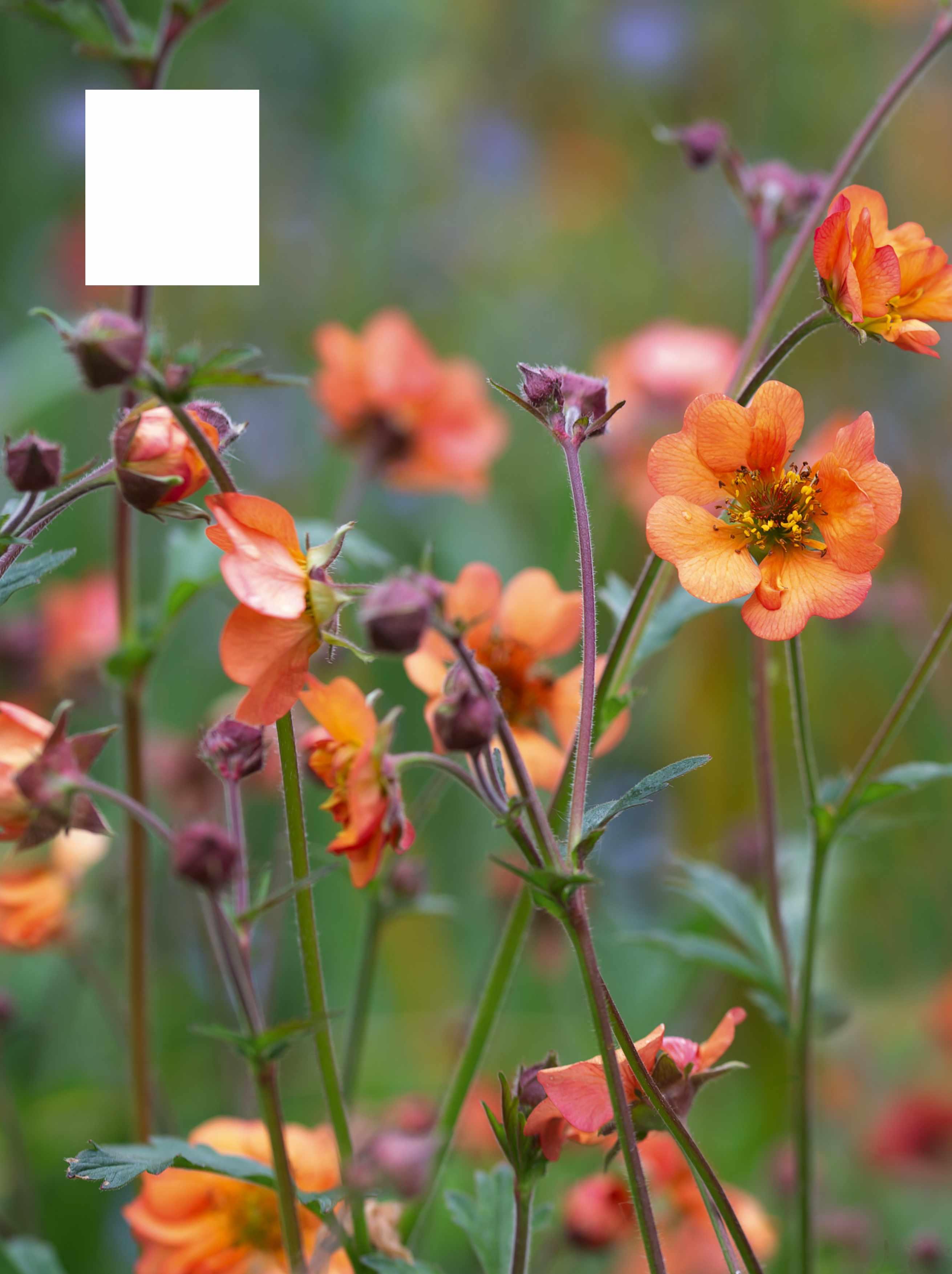 AGM*. RHS H7, USDA 5a-7b†
AGM*. RHS H7, USDA 5a-7b†
GEUM
Offering flowers from late spring into summer, this varied genus of hardy perennials is deservedly growing in popularity
WORDS NAOMI SLADE PHOTOGRAPHS DIANNA JAZWINSKI
What A genus of around 54 species in the Rosaceae family. Geums are hardy evergreen perennials with showy, brightly coloured flowers, and are commonly known as avens.
Origins Native to temperate regions of all continents (apart from Australia and Antarctica), geums are particularly found in a swathe across the Northern Hemisphere, with hotspots in the Balkans and Chile. Many garden forms are cultivated hybrids.
Season Mid-spring to summer with the key months being March to June.
Size Ranging from 15cm to over 80cm high. Plants are either clumping or spreading.
Conditions In general, geums need fertile, moisture-retentive soil. In cultivation, those derived from G rivale require shade, while cultivars of G quellyon (previously G chiloense) can adapt to sun or semi-shade.
Hardiness Geums are generally hardy throughout the UK with an RHS rating of H7, and suitable for gardens in USDA zones 3a to 7b.
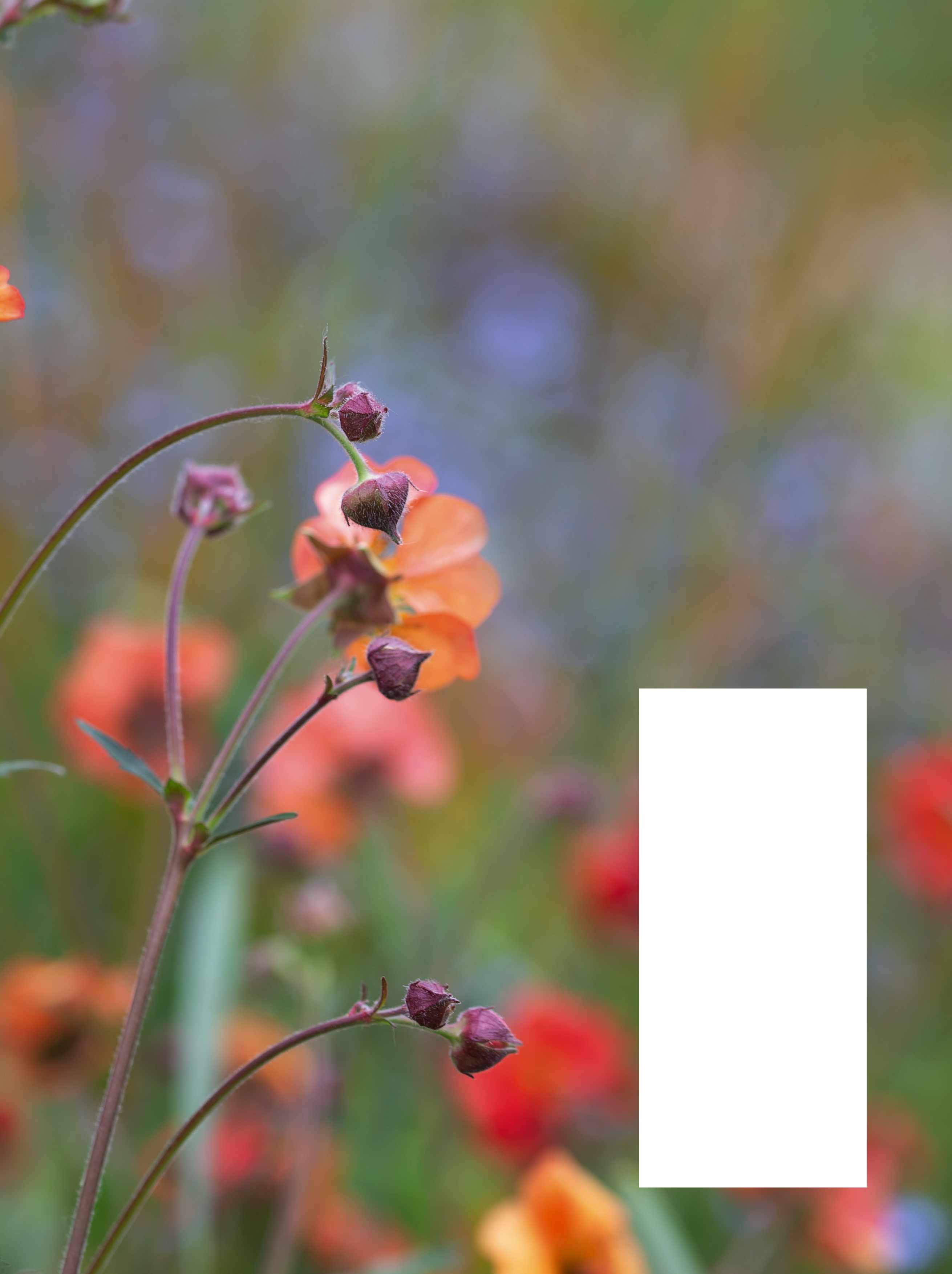
*Holds an Award of Garden Merit from the Royal Horticultural Society.
†Hardiness ratings given where available.
JUNE 2023 gardensillustrated.com 51
PLANT PROFILE GEUM
Geum ‘Tales of Hex’
A low-growing and easy-tocare-for plant that spreads by rhizomes and makes good groundcover. With frilly, paleyellow flowers on upright stems, it enjoys partial shade and moist conditions, and will even tolerate deep shade.
 25cm x 45cm. AGM. RHS H7, USDA 3a-7b.
25cm x 45cm. AGM. RHS H7, USDA 3a-7b.
Bred by National Collection holder Sue Martin, this is a strong, vigorous and spreading plant. The nodding double flowers are orange on the outside of the petals and more yellow in the middle. 45cm x 60cm. RHS H7,
Hard-working and handsome, plants from the genus Geum are perfect for their season. Coming into bloom in spring, just as the tree canopy starts to close and earlier plants retreat, geums carry on flowering until all the joys of summer are in full spate. They are hardy, evergreen and resistant to pests and diseases. The edible leaves and clove-scented roots have been used for brewing, baking and in medicinal tinctures to combat chills and catarrh – and even protect against plague. Nowadays, however, it is as a garden subject that Geum is best known and grown.
“I first got into Geum when I bought one that was wrongly named, and visited the National Collection holder to have it identified,” says Sue Martin, who now holds the UK’s only National Collection of Geum. She was soon hooked, and when she retired she started amassing Geum in earnest, eventually inheriting the National Collection she had earlier consulted. “They are such lovely plants, and so diverse,” she says.
To learn more about her new passion, Sue went to the Herbarium at the Royal Botanic Gardens, Kew, to study preserved specimens and their origins. With a map that was soon covered in location markers, she discovered that there was a mass of Geum across the top of the globe, between the Arctic Circle and the Tropic of Cancer.
“In the British Isles, there are two native species. In the south there is
A new cultivar from the Censation Series, this low-growing, rhizomatous Geum is happy in sun and in part-shade, where it produces large, attractively ruffled, pink-peach flowers from early April until the end of May. 40cm x 50cm. RHS H7, USDA 3a-7b.

Geum urbanum or wood avens, which grows in shaded copses, and in the north we have larger G rivale or water avens, which is found in damp and shady locations,” she says. “There is a cluster in the Balkans, mainly alpines such as G coccineum, and another one in South America, including G. quellyon, which are the ancestors of the big commercial cultivars.”
In cultivation, Geum generally falls into one of three loose types. The cultivars of G. quellyon form upright clumps with large, brightly coloured blooms. These include stellar performers such as G. ‘Totally Tangerine’ and new G. Scarlet Tempest (= ‘Macgeu001’) from the Tempest Series. A number of compact alpine forms, such as G coccineum ‘Cooky’, are also common in garden centres, thanks to their bold, brick-red flowers. The third type is made up of spreading, rhizomatous plants derived from G rivale. Characterised by drooping flowers with a contrasting calyx, these bloom earlier than cultivars from other species and they also need more moisture.
As part of her collection, Sue grows as many varieties as possible, and she likes to experiment to see how they perform in different locations in her Kent garden. “Geum is cold tolerant but plants are much less happy in heat, so recent weather conditions have thrown up some challenges,” she says. “The G quellyon cultivars flower better with some sun, and they coped with last year’s hot summer much better than the others, without wilting or scorching.
Geum ‘Apricot Pearl’
Geum ‘Dawn’
USDA 3a-7b.
To continue turn to page 57 JUNE 2023 gardensillustrated.com 53 PLANT PROFILE GEUM
G. quellyon cultivars flower better with some sun, and coped with last year’s hot summer better than others
Geum
Introduced at the
Chelsea Flower Show in 2010, it has since become a modern classic with fiery orange flowers that are produced prolifically over a very long period. Enjoys a sunny spot but will tolerate part-shade. 70-90cm x
 ‘Totally Tangerine’
RHS
45-50cm. AGM. RHS H7.
‘Totally Tangerine’
RHS
45-50cm. AGM. RHS H7.
Bred in 1938 by George Arends in Germany, this old, clumping cultivar is one of the richest tomatoreds available. It is frilly and very floriferous but it does not bulk up quickly, so is slow to propagate. 40-60cm x 50cm. RHS H7.
How to grow Geum

• Plant geums in late summer and autumn, or in early spring, when the ground is not dry or frozen. Geums are hardy and will bounce back even after a cold winter.
• Soil should be fertile, well-drained and moisture-retentive. As a group, these plants dislike drought, so improve soil as necessary with plenty of organic material, which should be lightly dug in or spread as a mulch.
• Site the plants according to the preferences of their parent species. The large cultivars of G quellyon will do well in sun or part shade, but they will not generally flower well in deep shade. The alpine forms, such as G coccineum, will struggle in heat and drought, so some shade and a cool location is essential; cultivars of G. rivale prefer shade or deep shade, and moisture underfoot.
A compact, sterile hybrid, it is one of the Tempest Series bred by Elizabeth MacGregor. The ruffled, semi-double, dark-red flowers are produced on sturdy clumps in summer. 40-45cm x 40-45cm. RHS H7.
• Propagate plants by division in autumn and spring to conserve the named variety; geums do not tend to come true from seed. Different varieties mature at different rates, so rather than adhering strictly to the idea of dividing every three to four years, keep an eye on the plant and divide it for maintenance purposes when it starts to look tired. This will create lots of fresh new plants and prolong the longevity of the clone. If more plants are required, plants can be divided as soon as they are sufficiently large and established.
• Methods of division vary according to the species. When clumping G quellyon cultivars get woody and begin to deteriorate, lift the plant and immerse the root ball in a bucket of water, so it can be gently pulled apart. Cultivars of G. rivale can be divided when there are lots of conspicuous rhizomes spreading across the surface of the soil.
• In clumping cultivars of G quellyon, cutting out the flowering stems at the base when spent can stimulate a further flush of bloom. There is no need to cut back the plant itself, however, as the evergreen leaves are an attractive feature in their own right. The low-growing G. rivale types, meanwhile, develop attractive seedheads and Sue prefers to leave these on the plant.
• In good, nutritious soil, Geum is a fairly low-maintenance plant, but if you feel plants need a bit of a boost, you can apply a liquid fertiliser containing seaweed, as necessary.
• Geums are relatively pest-free but vine weevil is often a problem, especially for plants in pots. Sue treats hers with nematodes every spring, once the soil temperature has reached 5ºC, and again in early autumn.
Geum ‘Rubin’
MANY THANKS TO SUE MARTIN IN WHOSE GARDEN THESE IMAGES WERE TAKEN.
Geum Fiery Tempest (= ‘Macgeu005’)
JUNE 2023 gardensillustrated.com 55 PLANT PROFILE GEUM
Geum ‘Prinses Juliana’
Introduced by Alan Bloom in 1940, this is a healthy plant with vivid-orange flowers. It clumps up and performs well in the garden but it does not flower as long and profusely as ‘Totally Tangerine’. 60cm x 45cm. AGM. RHS H7.
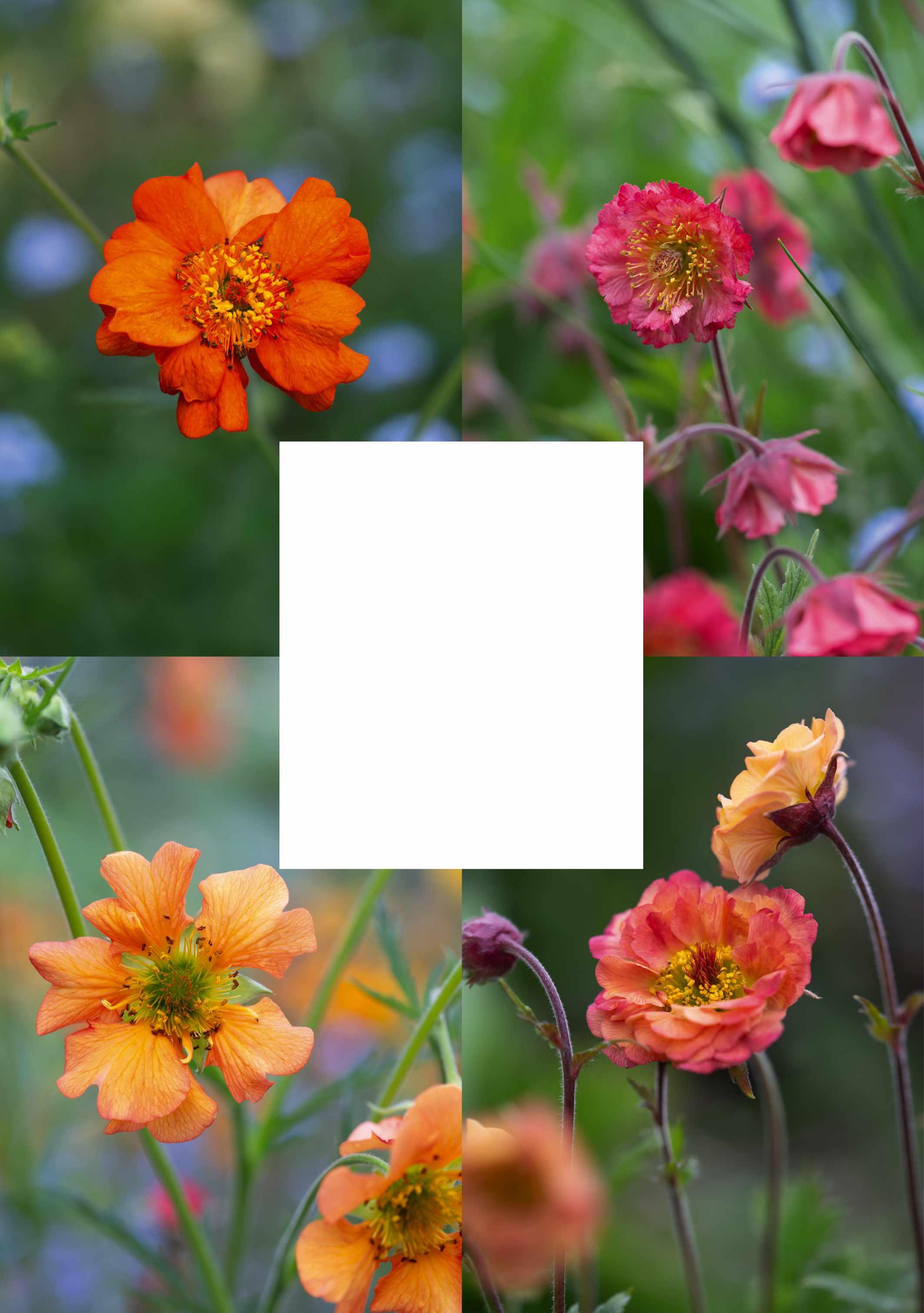
Geum ‘Dusk’
A tall seedling selection by Sue Martin, which flowers prolifically. Thought to have G.‘Hilltop Beacon’ as a parent, the elegant, single blooms are pale orange, and it increases well to form large clumps. 80cm x 50cm. RHS H7.
Geum ‘Bell Bank’
Lost to cultivation for some years, it was rediscovered in the 1980s. The semi-double flowers are bronze-pink and are produced on spreading plants, over a long period. Up to 45cm x 40cm. AGM. RHS H7, USDA 3a-7b.
Geum ‘Mai Tai’
A popular rhizomatous cultivar from the Cocktails Series with big double flowers. Does best in semishade with well-drained soil, but it is not particularly long-lived in Sue’s garden. 35-45cm x 30-40cm. RHS H7, USDA 3a-7b.
A low-growing, rhizomatous plant, with single, pink flowers that hover between dark peach and coral in hue. In an average year, these are produced from the beginning of April until the end of May. 40cm x 45cm.
In comparison, the alpine types really suffered and I had to shade them at one point, while the cultivars of G rivale definitely prefer shade or semi-shade.”
In addition to assessing the plants for performance and reliability, Sue also rates her geums on their aesthetic qualities and how well they combine with other perennials and self-seeding annuals.
“In a sunny spot, where you want a bright colour to liven things up, you might choose G. ‘Red Wings’ or G. ‘Totally Tangerine’, which flower for ages,” she says. “These look nice with Salvia nemorosa ‘Caradonna’, camassias and Dutch irises. In a shady location, a spring show of epimediums, pulmonarias and bulbs could be followed by G. ‘Bell Bank’, G. ‘Apricot Pearl’ or G. ‘Smokey Peach’. There are also cultivars that do well in shade, semi-shade and sun, for example G. ‘Hilltop Beacon’, which is very tall for a geum, and would look nice in a mixed border in front of shrubs.”
For Sue, her collection is an ongoing process of discovery, evolution and acquisition and she aims to ensure that it is as comprehensive as possible. Some cultivars such as G. ‘Rubin’ and G. ‘Bell Bank’ are tried and tested, and she is optimistic that the newer Tempest Series, bred in Scotland by Elizabeth MacGregor, will be tough. Experience has led her to be more cautious about recommending many of the Cocktails Series developed in the USA, however, as while the flowers are flashy, the plants don’t tend
Dainty, understated white flowers are held above a rosette of lobed foliage. Bred originally from Geum rivale, it spreads gradually via rhizomes and will tolerate a moderately sunny position. 30cm x 50cm. AGM. RHS H7, USDA 3a-7b.
to last. Some G coccineum cultivars have, likewise, proven themselves a triumph of style over long-term substance.
“Geums are amazing,” says Sue. “Each of the flowers is unique; some are double and others are frilled. But I’m very fond of the simple single ones. When you look at them carefully, the colour is not a solid block but several different shades. They are really versatile plants – not just in the garden. According to Gerard’s Herball of 1597, ‘a decoction of avens in wine will prevent rawness of the stomach and cure the bites of venomous beasts’. If you fall out of a high place it will apparently fix that as well – it seems geums really can do anything.” ■
Naomi Slade is an author and gardener.
Where to see and buy
• Geum – The National Collection Brickwall Nursery, 1 Brickwall Cottages, Frittenden, Kent TN17 2DH. Tel 01580 852425, geumcollection.co.uk. Open by arrangement.
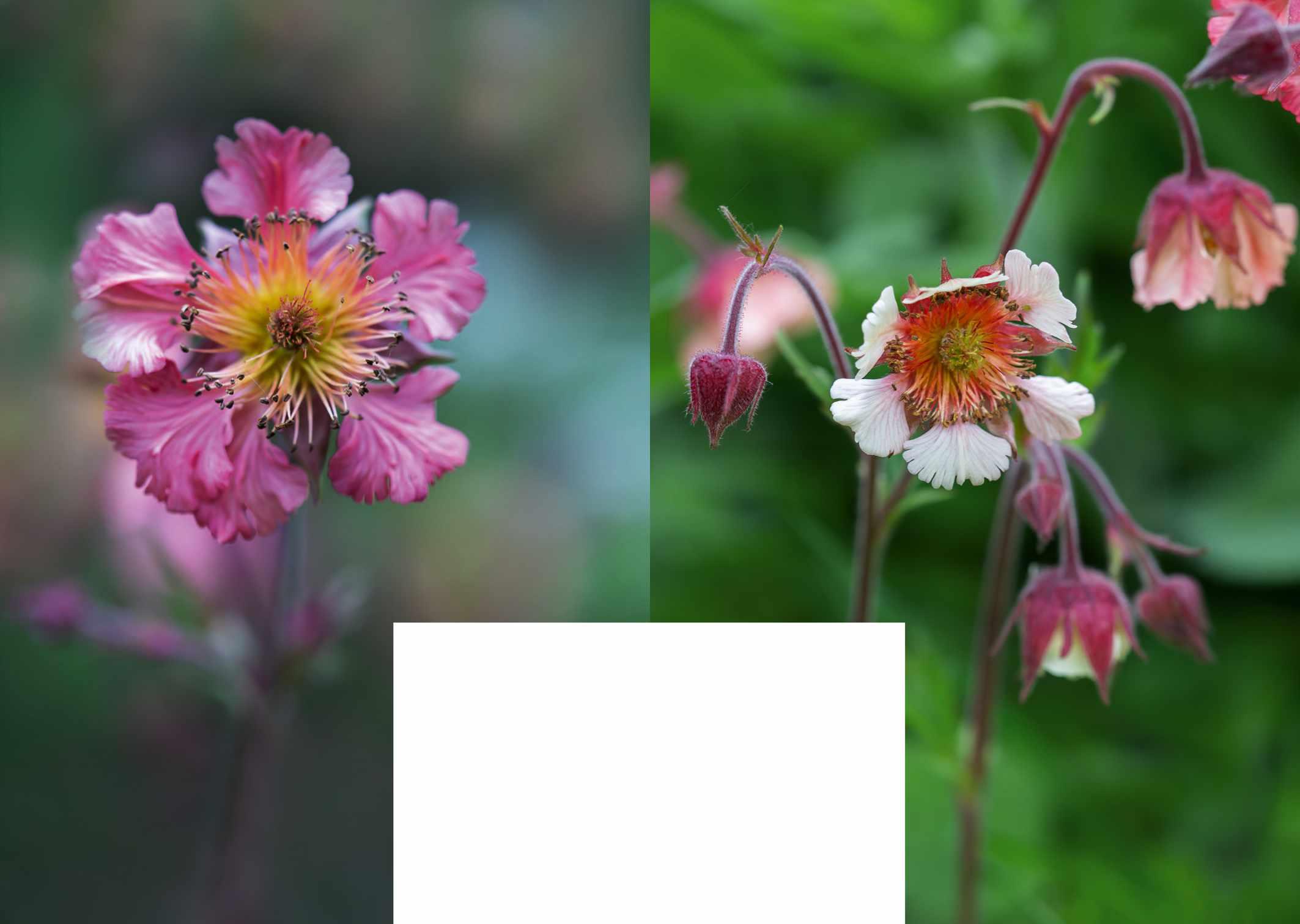
• Hardy’s Cottage Garden Plants Priory Lane Nursery, Freefolk Priors, Whitchurch, Hampshire RG28 7FA. Tel 01256 896533, hardysplants.co.uk
• Norwell Nurseries Woodhouse Road, Newark, Nottinghamshire NG23 6JX. Tel 01636 636337, norwellnurseries.co.uk
Geum ‘Sweet Angel Dar’
RHS H7, USDA 3a-7b.
Geum ‘Cotton Candy’
JUNE 2023 gardensillustrated.com 57 PLANT PROFILE GEUM
When you look carefully, you see the colour is not a solid block but several different shades
IN BRIEF
What Private family garden. Where Buckinghamshire.
Size A one-acre walled garden, within a larger space of approximately ten acres in total. Soil Neutral to alkaline loam. Climate Temperate. Hardiness zone USDA 8.
In the borders overlooking the central lawn, an intricate combination of white-flowered plants, including the nodding pendulous flowers of Sanguisorba tenuifolia var. alba, Hylotelephium spectabile ‘Stardust’, Malope trifida ‘Alba’ and Eryngium giganteum contrasts with the sculptural forms of box-headed hornbeams and the weathered brick of the old kitchen garden walls.
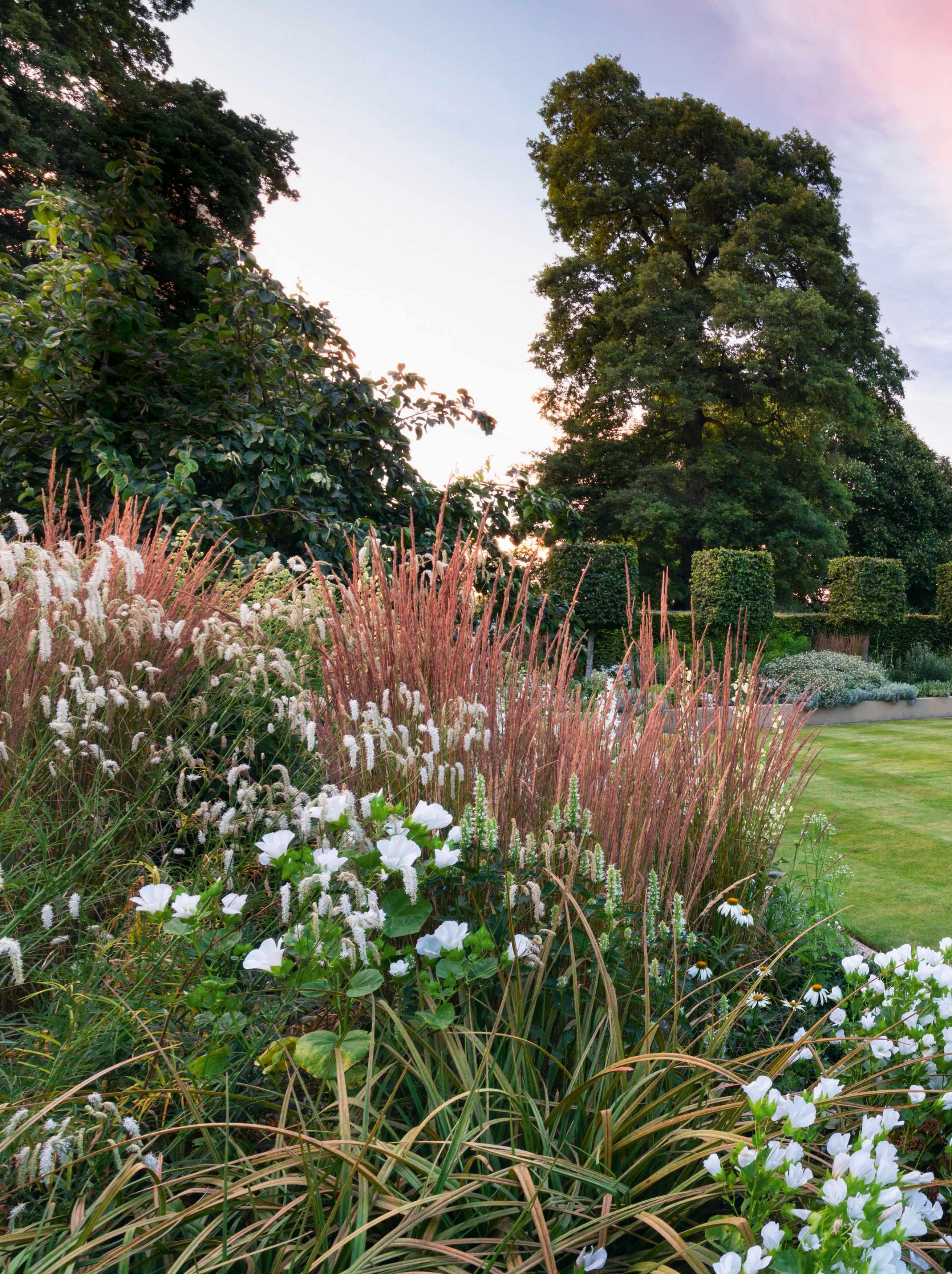
58 gardensillustrated.com JUNE 2023
Pale and interesting
A sense of tranquillity is the guiding principle in this beautifully realised white garden, with an elegant, pared-back planting palette

GARDEN COUNTRY
WORDS JODIE JONES PHOTOGRAPHS RICHARD BLOOM
Chrissie Rucker OBE loves the sense of calm that living with white can bring, and has built a multi-millionpound business – The White Company – on her belief that plenty of other people feel the same, so it’s no surprise to discover that she applies the same pared-back aesthetic to her garden making. For 15 years she has lived in a lovely 17th-century house with her husband Nick Wheeler OBE (founder of menswear brand Charles Tyrwhitt) and their four children, and the ten acres of gardens that enclose their family home are as picture-perfect as a White Company catalogue.
A meandering gravel drive leads through sweeping parkland to the front door, framed by a long-flowering succession of fragrant, white roses – R. William and Catherine (= ‘Ausrapper’), R. Claire Austin (= ‘Ausprior’) and R. Tranquillity (= ‘Ausnoble’) – among others. The Grade I-listed building is wrapped on all sides by softly elegant garden areas, including deep lavender beds and a traditional parterre, but it is the one-acre walled garden that is closest to Chrissie’s heart.
Approached via a new covered entrance set into the old brick walls, it is as captivating as any storybook secret garden. “This is one of my
favourite places and I love nothing more than to wander through it, seeing what has changed, and cutting seasonal flowers, herbs and greenery,” says Chrissie. “We might read or work here quietly, but it’s also a place that loves to be filled with friends and family for long lunches and fun evenings. And at sunset, the warm, low light coming through the trees feels particularly magical.”
It hasn’t always been this way, however. “When we moved here, the walled garden was almost derelict. We wanted to bring it back to life, and make it work for today and for our family. Many years ago, when it was a working kitchen garden, I suspect it may have fed the whole village.”
Working with landscape architect Robert Myers, Chrissie and Nick developed a plan to divide the space in two – half for produce and half devoted to the family – with a new hornbeam hedge running across the width of the garden. On one side, the old espaliered pear and apple trees were revived and the ground divided by low box hedges into a succession of vegetable and cutflower beds, which supply almost all the family’s needs. Overlooking this orderly arrangement is a magnificent Alitex greenhouse, where their talented head gardener Phil Kusmishko and his team propagate new plants and grow masses of tomatoes and other tender crops. “Nick and I
To continue turn to page 64
Above Looking down from an old water tower in one corner, the vast scale and intelligent organisation of this garden are clear to see. Dominant elements in the planting include the box-headed hornbeams, ‘Mount Fuji’ phlox and upright Acanthus mollis ‘Rue Ledan’.

Above right The central path of herringbone clay pavers is fringed by deep beds where old apple trees are underplanted with generous cushions of perennials, most notably repeated clouds of fluffy Pennisetum villosum, anchored by clipped balls of Buxus sempervirens ‘Variegata’.
Right At the base of the old water tower, and in dramatic contrast with the open heart of the garden, is a textural combination of Dryopteris affinis, Hakonechloa macra and Geranium macrorrhizum ‘White-Ness’, which appreciate the dappled shade in this quiet corner, backed by masses of the reliable Hydrangea arborescens ‘Annabelle.
60 gardensillustrated.com JUNE 2023
GARDEN COUNTRY

The planting is designed to keep the garden flowering with different white blooms for as long as possible
How to create a white garden

There is a sense of purity and calm in a white garden that is a perfect antidote to the frenzied pace of modern life. Creating a successful example of the genre, however, can be surprisingly taxing. There are thousands of subtly different shades of white, and they don’t all go together. Anything with a pinkish tone can be difficult to work with, whereas whites with a hint of cream, yellow or green are generally more forgiving.
The green of leafy plants is an essential element in a white garden, where it will provide a long-lasting foil for all the more ephemeral flowers. Structure is also important – both the structure that comes from a strongly designed layout and the plant-based structure of hedges, topiary and trees. Plan for a range of textures and forms: mounds, maybe of hydrangeas; spires including foxgloves and delphiniums; and ephemerals such as Cephalaria gigantea. While many white-flowered plants are happy in the sun, white gardens are very effective in shady areas. Good choices include cow parsley and white hydrangeas. Create a sense of rhythm and continuity by repeating key plants. This could be a classic choice, such as roses, or grasses for a contemporary touch. Grey and silver leaves work brilliantly in a white garden, from a weeping silver pear (Pyrus salicifolia ‘Pendula’) to the metallic sheen of Astelia chathamica
GARDEN COUNTRY 62 gardensillustrated.com JUNE 2023
Top 8 white garden plants

1 Phlox paniculata ‘Mount Fuji’ Robust perennial with elegant heads of fragrant flowers in late summer. Height and spread: 80cm x 30cm. RHS H7, USDA 3a-8b†
2 Veronica parviflora var. angustifolia Vigorous, mound-forming hebe offering year-round structure as well as midsummer flowers. 1.5m x 1.5m. RHS H5.
3 Malope trifida ‘Alba’ Lovely annual for the cutting garden, but also good in a border, and easily raised from seed. 90cm x 50cm. RHS H4.
4 Salvia x jamensis ‘Trebah’ Compact ornamental sage covered in fragrant, gently pink-tinged white flowers from June to October. 50cm x 45cm. RHS H4.
5 Verbena hastata ‘Alba’ Upright perennial covered in spikes of white flowers from May to October. 1m x 50cm. RHS H5.
6 Pennisetum villosum From July to September, this tender, mound-forming grass is a tactile haze of fluffy flowerheads. 50cm x 40cm. AGM*. RHS H3.
7 Delphinium ajacis ‘White King’ Long-flowering larkspur that looks good in the garden and lasts a long time in a vase. 1m x 50cm. RHS H6.
8 Sanguisorba tenuifolia var. alba Good perennial for rich soil, with ferny foliage and catkin-like flowers that look particularly lovely with the sun behind them. 1.2m x 50cm. RHS H7.
*Holds an Award of Garden Merit from the Royal Horticultural Society. †Hardiness ratings given where available.
1 2 4 5 6 7 8 3
both grew up in the country and our parents were passionate about their kitchen gardens and about eating seasonally, so we have tried to carry this on,” says Chrissie.
On the other side of the central hedge, the ornamental garden provides nourishment of a different kind, with a serene pool house, garden tables and an enveloping pair of huge rattan sofas overlooking a sunken lawn and deep ornamental borders in a calming palette of white and green. “I wanted to extend through to the garden that sense of peace I get from living with white in my home, so Phil designed the planting to keep the garden flowering with different white blooms for as long as possible throughout the year.”
In late spring and early summer, the garden is filled with a combination of fresh, green foliage and Allium stipitatum ‘Mount Everest’, white hesperis, tulips and Wisteria floribunda ‘Alba’.
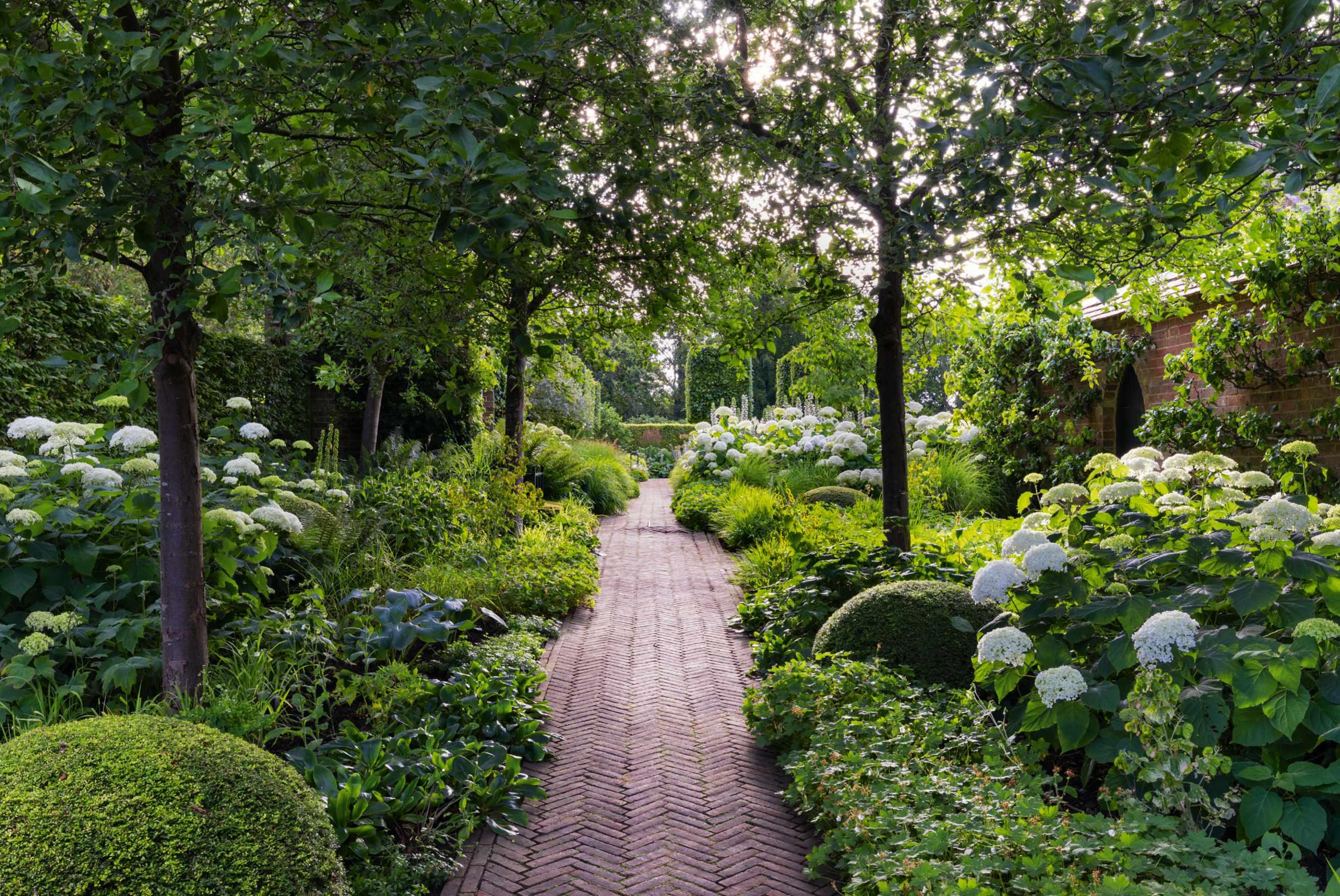
As the summer progresses, blowsy mounds of Hydrangea arborescens ‘Annabelle’ and contrasting spikes of white acanthus take centre stage, offset by a selection of ornamental grasses.
The palette is controlled, but this is no exercise in Sissinghurst stylism. “Our main influences for this garden were naturalistic, looking to designers such as Piet Oudolf, Tom Stuart-Smith and Dan Pearson,” says Chrissie. This has resulted in plant combinations with an unusually interesting range
and depth, which exploit the tonal possibilities that come, for example, from the gun-metal shades of Calamagrostis x acutiflora ‘Karl Foerster’ in flower, or the subtly bronzed cone at the heart of the purest white-petalled Echinacea purpurea ‘White Swan’.
Against this richly worked tapestry, the green architecture acts as both a foil and an anchor. The central hedge provides a solid backdrop against which white foxgloves and lupins, cosmos and dahlias shine out. A stunning pair of multistemmed Prunus serrula link the sleek poolhouse with the surrounding garden, and a grid of box-headed hornbeams, underplanted with hakonechloa and Anemone x hybrida ‘Honorine Jobert’, provide a structural framework at the heart of this expansive area.
Throughout the walled garden, Phil’s painterly eye for planting combinations is evident, as is his understanding of the need to balance mass and void to produce a satisfying whole. Walking away from the wide lawns and back to the garden door down a path fringed by lush borders, and shaded by a succession of overhanging Malus hupehensis, is an object lesson in how many shades of green you need to make a truly satisfying white garden.
“This garden is constantly evolving,” says Chrissie. “But it always has the most wonderful sense of calm continuity.” ■
Above Approaching the walled garden via its new covered entrance, you first pass through a lush, enclosed area where neat domes of Lonicera ligustrina var. yunnanensis, carpets of Geranium macrorrhizum ‘White-Ness’ and clumps of Hydrangea arborescens ‘Annabelle’ are shielded by the arching branches of crab apples Malus hupehensis
Above right The pair of cloud-pruned Buxus sempervirens flanking the entrance to the White Garden were overgrown plants from the wider estate that Phil expertly clipped into these elegantly sculptural forms.
Right The productive half of the walled garden is also highly ornamental. As well as fruit and veg, the box-edged beds are filled with cutting-garden essentials such as Bupleurum rotundifolium ‘Griffithii’, Zinnia elegans ‘Benary’s Giant White’ and Ammi majus. A pair of clipped lemon verbenas, Aloysia citrodora, frame the greenhouse doors.
GARDEN COUNTRY 64 gardensillustrated.com JUNE 2023

A painterly eye for planting combinations is evident, as is an understanding of the need to balance mass and void
PAOLO PEJRONE
Hailed, often, as Italy’s greatest landscape architect and garden designer, Paolo Pejrone somehow remains just behind the curtain on the world stage of archi-gardener stars. Pejrone (pronounced pay-RO-neh) might not be a household name outside his own country, but he has created hundreds of gardens across the world, from France to Greece, and England to Saudi Arabia, around villas and castles, hotels and universities, banks, factories, and in piazzas and parks – there’s a good chance you have been in one of his gardens, and not even realised it.
His clients and connections are countless and formidable, from the Agnelli family and Valentino to princes, presidents and Popes. If, beyond Italy’s borders, Paolo is lesser-known than some of these international jetsetters, at home he stands alone as a cultural institution in his own right. “I’ve been found on a lot of school desks lately,” he says, with a chuckle.
His own first gardening experiences were small steps taken as a four-yearold, growing up near Turin. “I have a memory of a hot, sunny day in the large vegetable garden at Valsalice, and a small patch of land carefully assigned to me by Giovanni, the gardener,” he explains. “The soil was heavy clay, dry, cracked, and my job was important, biblical even: to quench its thirst. I remember the heavy watering can and the instructions – that the important thing was to be generous, but gentle.”
He went on to study architecture before moving to London in 1969, where he studied and worked with the great designer Russell Page. In the 1970s, he moved to Rio de Janeiro to work as an intern for Roberto Burle Marx. “They were undoubtedly my greatest mentors,” he says.
These formative years helped to crystallise his design ethos, which has changed little in the intervening decades. “Keep the plan bold and simple,” he suggests. “Plants for great gardens are often counted by the thousands.” The labyrinth of the Masino Castle, for example, which was re-created faithfully to mid 18th-century plans, is the second largest in Italy and includes more than 2,000 hornbeams. An allée on the same property is flanked by 7,000 bridalwreaths (Spiraea x vanhouttei).
Although he turns 82 this year, Paolo is not slowing down. His latest book, entitled I dubbi del giardiniere: Storie di slow gardening (Doubts of a Gardener: Stories in Slow Gardening), was published recently, and follows success with best-selling titles including In the Garden You’re Never Alone and A Real Gardener Never Gives Up, which sold over 100,000 copies. Arguably the finest Pejrone title of all is Chronicles from a Garden, about his own private home and garden
Bramafam, which is situated high above the small town of Revello in Piedmont. Bramafam is literally his magic mountain, with terraced olive groves and ancient bastion – a perch overlooking the fertile plains of the Po River Valley, with a sunken vegetable garden, mountain stream, bamboo grove, laboratory, library, studio and ‘nest’. As gardeners age, it is inevitable that they think about designing gardens that will outlive them, and Paolo considers the future of not only his own garden or those he has designed, but the planet we all share. He reflects – sometimes with humour, other times with irony, but always with eloquence – on the futility of creating artificial environments that can only be maintained through constant watering, manicuring and heavy-handed use of chemicals. As a lover of Nature and her timing, he dislikes instant gardens and awkward architectural or botanical incongruities that get foisted upon the landscape. “We have to remember that a messy garden is still a beautiful garden,” he says, “and straight lines are best when they give way to exuberance.”
Paolo is incredulous when he sees show gardens that are not in shows, but in backyards, and admits to clenching his teeth when looking out over an extensive green lawn in Sardinia. “A summer lawn in Italy should be the colour of a golden schnitzel.” The battle against nature and a changing climate is one that he personally refuses to fight, and his mantra is clear: con, non contra (with, not against). “Let’s remember that plants are not our enemies, and trees are not poles,” he says. “Gardens grow, and must be planned for accordingly.”
The designer’s curiosity and passion for plants and people have taken him from California to Monaco and Morocco, but his next project is closer to home, for the Radicepura Garden Festival in Sicily. This biennial event, which is open now and until December, is located between an ever-smoking Mount Etna and the blue Ionian Sea, and features an intriguing line-up of international designers, architects, artists, writers and gardeners. Another of his recent works, the Royal Gardens of Venice, opened in 2019, just a few steps from St Mark’s Square. When you’re tired of the crowds in the piazza, there’s a quiet bench closer than you might think, in the shade of an antique pergola of cast iron. Sit for just a few minutes to enjoy the fine form of a large leaf of Tetrapanax papyrifer and the exuberant border of white hydrangeas and blue agapanthus blooms. This garden is just one of nearly a thousand subtly signed ‘Paolo Pejrone’. ■
USEFUL INFORMATION
Radicepura Garden Festival takes place near Catania in Sicily until 3 December. For more information visit radicepurafestival.com/en
A MESSY GARDEN IS STILL BEAUTIFUL, AND STRAIGHT LINES ARE BEST WHEN THEY GIVE WAY TO EXUBERANCE
The legendary Italian designer, who thinks of himself primarily as a gardener, on the importance of keeping gardens bold and simple, and working with nature in adapting to climate change
66 gardensillustrated.com JUNE 2023 PEOPLE WHO’S WHO
WORDS CLARK LAWRENCE PORTRAIT RICHARD BLOOM

Wild dreams
WORDS BENJAMIN POPE PHOTOGRAPHS CLIVE NICHOLS
IN BRIEF
What Private ornamental garden. Where East Sussex.
Size Eight acres.
Soil Variable but mainly heavy clay loam.
Climate Temperate maritime with dry summers.
Hardiness zone USDA 8.
Informal and naturalistic planting spills from the borders and creates a tapestry of textures and shapes.
Small, repeated clumps of Stipa tenuissima, Stachys byzantina and others unify the planting schemes without dominating to give a ‘wild’ feel to the garden.

68 gardensillustrated com JUNE 2023 8 r ns lus ated co
The mix of varied growing conditions in this ebulliently planted garden in East Sussex helped to forge an ecological vision and approach to gardening that benefits wildlife

GARDEN COUNTRY
Sloping northwest, this garden sits atop a gentle hill in the Sussex High Weald, with its boundaries merging into ancient oak woodland, working and derelict coppice, farmland and rolling fields. The owners bought the property in 2012 and fell in love with the garden, location and the opportunities it offered, loving the mix of habitats in the surrounding land, which makes it incredibly rich in wildlife, and is so important for biodiversity. This focus on ecology, along with a deep-rooted love of plants, is what drives the garden forward. It is an ethos and vision shared by head gardener Chris Brown, who has been working closely with the family to develop the garden since August 2020.
The fact it is on top of a hill presents another consideration. “The garden varies greatly in its growing conditions,” explains Chris. “The soil is predominantly a rich clay loam that sits above a sloping sandstone bedrock, meaning that water can behave in an unpredictable way.” Historically, this has been managed with land drains that now further complicate the hydrology of the site, creating some areas that are free-draining, while others retain moisture or sit saturated for much of the year. For Chris and the owners, this is not a problem but an opportunity to grow different plant species and create diverse habitats. Seasonal water-filled gullies that run through meadow grass contain moisture-loving species of darmera, iris and farfugium, while the hottest and driest areas around the terrace hold sun-loving, part-tender species such as Aloe striatula and Dasylirion serratifolium
This eclectic mix of habitat and growing conditions is mirrored by the house’s architecture; a collection of old extensions sits comfortably around the original 15th-century barn, held together

at the front with a Georgian façade and to the rear with modern minimalism. The house, along with a 17th-century threshing barn and cluster of old stables, divides the surrounding garden into different spaces, where terraces and dry-stone walls tackle level changes and enhance the sunny, dry conditions.
Here, Chris and the owners have developed a series of gardens, framed by formal hedges and beautiful brick herringbone paths. The borders are filled with an energetic mix of perennials, annuals and bulbs to extend the season, planted in a contemporary, naturalistic style with ornamental grasses, such as Helictotrichon sempervirens, Hordeum jubatum and Stipa tenuissima. It feels wild and free, and Chris puts this down to the dynamic nature of hardy annuals. “We try to garden on both a macro and micro scale,” he says, “encouraging self-seeding species to establish in the walls and path edges. This enables some plants to choose where they grow and allows the garden to have its own trajectory.” Hardy annuals are also propagated, being sown in late summer and planted out in autumn so that “they have time to establish before winter and cope better with summer drought the following year”.
In the white garden, bold stands of silvery cardoons add drama and structure amid clouds of Visnaga daucoides, Lychnis coronaria ‘Alba’ and Oenothera sinuosa. On the other side of the barn, the colours change to pinks, blues and purples, with Agastache ‘Blackadder’, dwarf buddlejas and Verbena bonariensis contrasting beautifully with Diascia personata, Malva trimestris and Lychnis ‘Hill Grounds’. A winning combination of Dipsacus fullonum with Echinops ritro and the forementioned verbena is a display that is great for bees and butterflies, with seedheads still looking good even after the flowers fade. This creativity and willingness to embrace
To continue turn to page 74
70 gardensillustrated.com JUNE 2023
GARDEN COUNTRY
Looking west along the main border in the white garden, silver cardoons make a bold statement amid spires of verbascum and clouds of lychnis. A generous wisteria arch ties the old barn to the planting, differentiating one space from another.
Above The dry borders sit above an old wall and enjoy the sunny, free-draining site. Here, Chris has planted xerophytic species, such as dasylirion and euphorbia, along with other dry-loving plants such as Berkheya purpurea and prostrate rosemary.
This image Looking towards the rear terrace, kniphofia continues the display with its dazzling pokers, among an explosion of colourful perennials. Silver Onopordum acanthium branches out in dramatic fashion, echoing the foliage colour of the verbascums and salvias.

The garden varies greatly in its growing conditions. This is not a problem but an opportunity to create diverse habitats
Gardens, framed by formal hedges and brick herringbone paths, are planted in a contemporary, naturalistic style
A soft jumble of agastache, buddleja and verbena decorates the barn wall and potting studio, while Echinacea pallida ‘Hula Dancer’ spins among Dianthus carthusianorum and Malva trimestris, providing continued colour along with food for bees and butterflies.

72 gardensillustrated.com JUNE 2023
GARDEN COUNTRY
8 key plants
1 Buddleja davidii ‘Lonplum’ A useful, low-growing cultivar with rich, purplish-red flowers all summer that are attractive to butterflies. Height and spread: 2m x 1.5m. RHS H5, USDA 5a-9b†
2 Delphinium ajacis ‘Misty Lavender’ A beautiful hardy annual with delicate, lax spires of smoky, lilac flowers from late spring to summer. 80cm x 50cm. RHS H6.
3 Agastache ‘Blackadder’ An upright hardy perennial with tight, blackish-blue spikes of flowers throughout summer and loved by bees. 1m x 50cm. RHS H4, USDA 6a-9b.
4 Verbascum chaixii ‘Album’ A floriferous perennial producing tall spires of soft-white flowers from a low rosette of leaves from mid- to late summer. 1m x 50cm. RHS H6, USDA 5a-8b.

5 Nigella papillosa ‘African Bride’ A half-hardy annual with a branching, delicate habit, holding masses of white flowers with a dark central boss that develop attractive seedpods. 60cm x 50cm. RHS H3.
6 Dierama pulcherrimum An evergreen perennial with thin, strappy leaves, and small, pink flowers that elegantly hang from arching stems during summer. 1.5m x 50cm. RHS H4.
7 Malva trimestris A floriferous annual with large, pink, trumpet-like flowers on bushy stems throughout summer. 80cm x 50cm. RHS H4, USDA 2a-11.
8 Clarkia unguiculata A vigorous and easy annual with loose, upright stems that hold numerous, purplish-rose flowers throughout summer. 1m x 50cm. RHS H6.
*Holds an Award of Garden Merit from the Royal Horticultural Society. †Hardiness ratings given where available.
1 2 4 5 6 7 8 3
The sun’s rays hit the surface of the natural swimming pond, painting the surrounding meadow with soft gold

74 gardensillustrated.com JUNE 2023
serendipity extends to container schemes. Generous collections of pots are filled with home-grown annuals including calendulas, poppies and anything spare from the borders. The result is an enchanting riot of carefree colour. “The combinations change every year,” says Chris, “but continuity of colour, nectar and pollen production remain a priority.”
As with all other parts of the garden, Chris sees the lawns as an opportunity to create habitat for wildlife, and so plants into the grass and maintains different mowing regimes for different areas. Paths are regularly mown for access and give a tended impression, and while some areas are left to grow all season as meadow, others are cut every four or five weeks. “After no-mow May, we intermittently cut the grass to deadhead
flowering plants in the lawn. This encourages them to flower again, which is great for wildlife”.
It is also great for a gardener stealing a moment of calm. At first light, the sun’s rays hit the still surface of the natural swimming pond, atmospherically illuminating swirls of rising mist, while painting the surrounding meadow with soft gold. It’s a moment of peaceful harmony, where careful human intervention has enriched the surrounding environment, providing a safe swimming space for people to enjoy, and home for numerous aquatic species. It’s the perfect creative fusion of plants, practicality and nature. ■
USEFUL INFORMATION


Follow Chris on Instagram @thesussexplanthunter
As the garden drifts away from the house, quiet spaces can be found. Here, a meadow wraps around a natural swimming pond, providing the perfect spot to relax and be close to nature, with views of the surrounding countryside from the deck and the shepherd’s hut.

GARDEN COUNTRY ARDEN COUNT
G d h t enou to ea


Many of this year’s RHS Chelsea show gardens featured ‘edimentals’ – plants that are both edible and ornamental, beautiful and tasty. We asked three expert growers to recommend their favourite edimentals
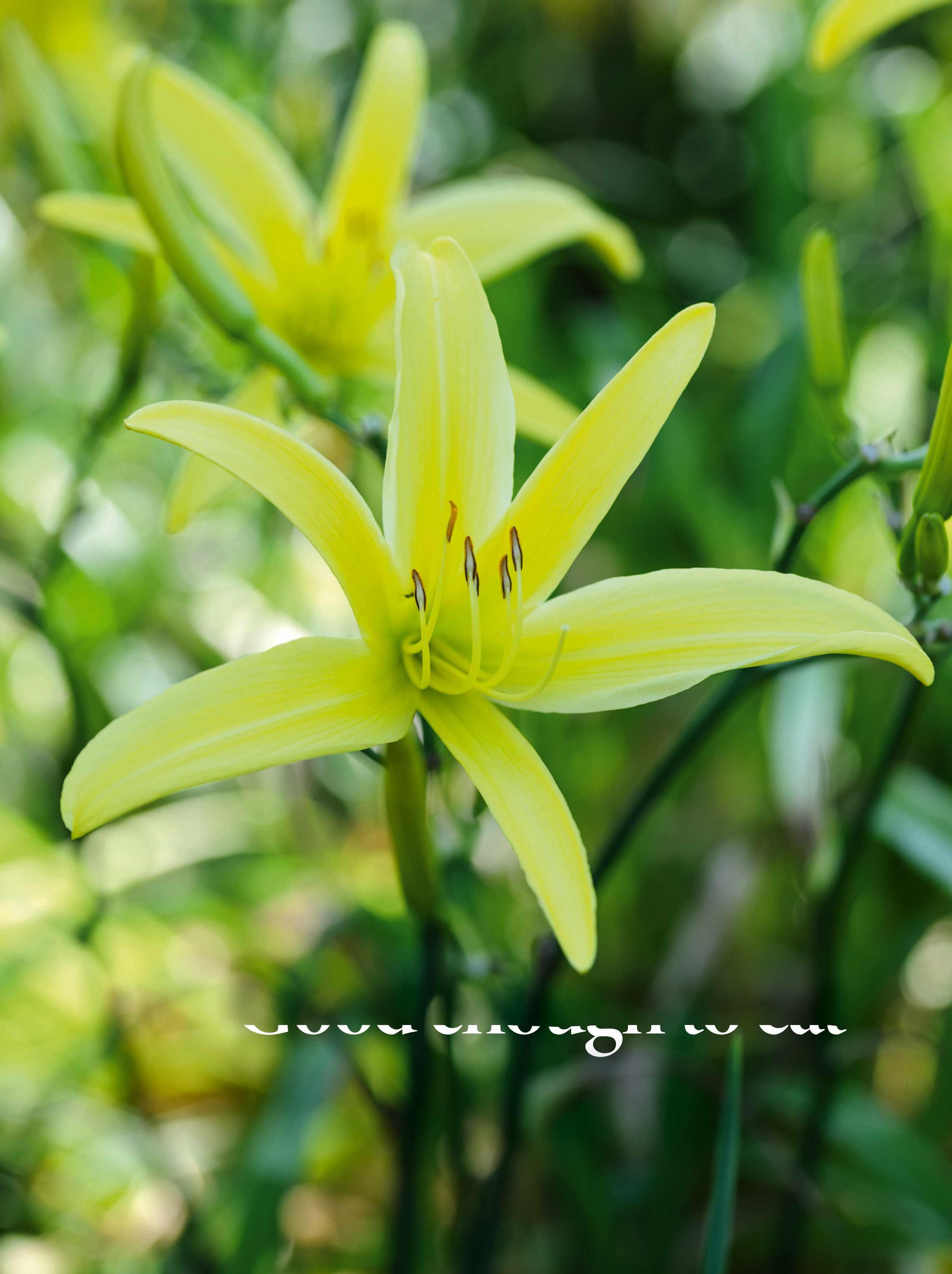
76 1 PLANTING IDEAS gardensillustrated.com JUNE 2023
ALISON JENKINS
Alison runs Damson Farm, near Bath, where she regularly holds workshops on edible growing. alisonjenkins.co.uk

Gathering and eating leaves, flowers and fruit brings an element of intimacy to your relationship with the garden, especially if those plants are beautiful as well as edible.

1 Hemerocallis Daylily petals have a crunch that adds a great dimension to salads. I use the lemon-scented H citrina, to edge some of the beds in my edible garden. Height x spread: 90cm-1.2m. RHS H6, USDA 3a-9b†
2 Tulbaghia violacea A South African native, with dainty, pink, agapanthus-like flowers. Both flowers and leaves are edible, with a delicate garlic taste. Works well in containers as it flowers all summer into autumn. May need some winter mulch protection. 55cm x 25cm. AGM*. RHS H3.
3 Salvia microphylla ‘Cerro Potosí’ Drought tolerant, so good for containers. It combines well with purple basil. The lipstick-pink flowers look great in a salad with orange marigold petals. 90cm x 90cm. RHS H4.
4 Dahlias Although the tubers are edible I can never bring myself to dig them up so I have only eaten the petals. They make a really colourful addition to salads and the texture has a bit of bite to it too. I tend to use D. ‘Mexican Star’ as it’s so prolific, and the deep-red petals add a bit of drama. 30cm1.8m x 30cm-1m. RHS H3, USDA 7a-10b.
5 Raphanus raphinastrum Rat’s tail radish is grown for its pods rather than the roots. The pods are good raw, tossed in a stir fry or pickled. They are crisp and crunchy with a bit of peppery heat. The flowers are similar to night-scented stock, white with bleeding purple edges, and last into late autumn. 1.5m x 1m.
6 Brassica oleracea ‘Dazzling Blue’ A really attractive kale with startling pink mid ribs to the blue-green leaves. It is more cold hardy than other cavolo nero types and seems less palatable to slugs too. As well as steaming or roasting, you can eat it raw as baby salad leaves for extra nutrition. 60cm x 75cm.
7 Rubus phoenicolasius The Japanese wineberry’s sweet red berries have a shiny, sticky surface that make them seem as if they have been dipped in honey. I like to train it against a wall in swirls to make a feature in winter of the bare stems, which are bright red. Vigorous and easy. 2m x 2m.
2 3 4 5 7 6 1, 2, 3 & 4 JASON INGRAM, 5 DAVE BEVAN / GAP PHOTOS, 6 MAAYKE DE RIDDER, 7 IMAGEBROKER / ALAMY STOCK PHOTO
ÉVA NÉMETH
*Holds an Award of Garden Merit from the Royal Horticultural Society. † Hardiness ratings given where available.
SID HILL

Sid Hill is an ecological garden designer whose gardens focus on rewilding landscapes and creating edible ecosystems. sidhillecogardens.com
The potential to play with edimental plants is endless, allowing us to experiment with planting combinations and new recipes.
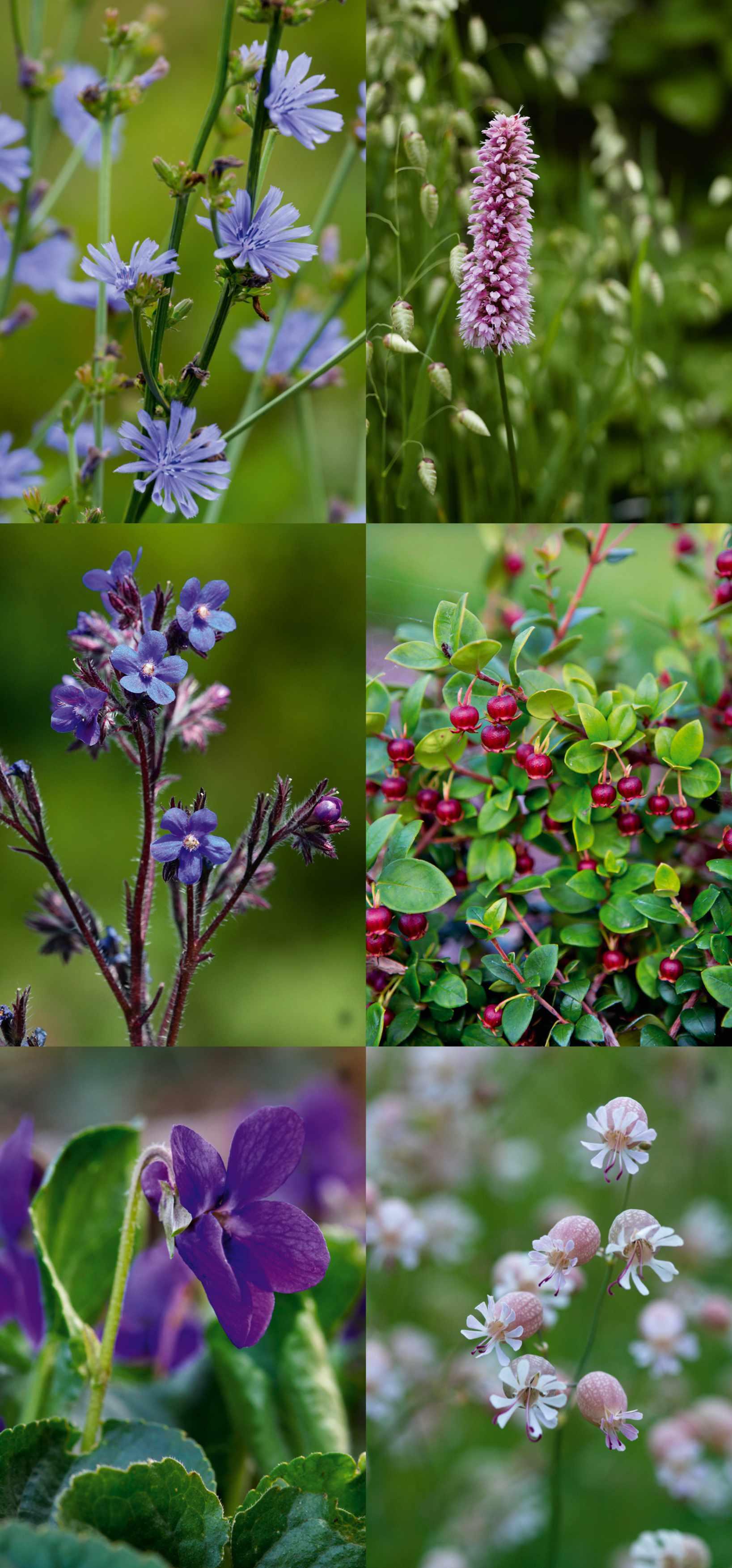
1 Cichorium intybus Chicory is a really beautiful herb with blue flowers on tall, rising stalks. The leaves can be cooked as a green vegetable or young leaves used in salads. It does have a slightly bitter taste but this is because it is packed with healthy nutrients. 1.2m x 60cm. RHS H5, USDA 3a-8b.
2 Bistorta officinalis Common bistort has a long history of use as a green vegetable here in the UK and is common as an ornamental plant in our gardens. A tough and adaptable plant that multiplies rapidly and offers a harvest in the hungry gap of spring. The leaves can be cooked or eaten in salads. 90cm x 90cm. RHS H7, USDA 3a-7b.
3 Anchusa azurea Italian bugloss may not be an obvious choice for the kitchen, but its leaves are a great vegetable when sautéed and the flowers are a beautiful garnish. With its blue flowers and spiny leaves, this plant is an excellent choice for a dry edimental garden. 1.2m x 60cm. RHS H5, USDA 3a-8b.
4 Ugni molinae The Chilean guava is an evergreen shrub that can grow in a wide range of conditions, though it prefers an acid soil. In midsummer, it produces lovely, scented flowers, followed by tasty berries in autumn. I’ve been dreaming about training it as an edible, low, evergreen alternative to box hedging. 1.5m x 1m.
5 Viola odorata Sweet violet is a great groundcover for the edimental garden, hugging the ground with its small leaves and purple flowers. It can cope well with shade. The leaves are a great addition to salads. 20cm x 30cm. RHS H6.
6 Silene vulgaris Bladder campion has a helpful habit of growing in gaps, helping knit plantings together while offering delicate bell-shaped flowers and an edible leaf that tastes much like pea shoots, and is best added to salads. 45cm x 45cm. USDA 4a-7b.
7 Helianthus tuberosus ‘Dwarf Sunray’ This dwarf Jerusalem artichoke is a real gem for the edimental border. You can plant, forget about it and then harvest the nutritious tubers. Remember to leave some in the ground for future harvests. 1m x 1.5m.
1 2 3 4 5 6
1 AILIME / GETTY IMAGES, 2 RAY KELLER / GETTY IMAGES, 3 MAURITIUS IMAGES GMBH / ALAMY STOCK PHOTO, 4 DORLING KINDERSLEY LTD / ALAMY STOCK PHOTO, 5 ARTERRA PICTURE LIBRARY / ALAMY STOCK PHOTO, 6 IAN WEST / ALAMY STOCK PHOTO, 7 STEFFEN HAUSER / BOTANIKFOTO / ALAMY STOCK PHOTO

PLANTING IDEAS JUNE 2023 gardensillustrated.com 79 7
WHERE TO BUY
Recommended suppliers
• Chiltern Seeds Tel 01491 824675, chilternseeds.co.uk

• Jekka’s Herb Farm Tel 01454 418878, jekkas.com
• Frank P Matthews Tel 01584 810214, frankpmatthews.com
• Plant World Seeds Tel 01803 872939, plant-world-seeds.com
• Real Seeds Tel 01239 821107, realseeds.co.uk
• Sarah Raven Tel 0345 092 0283, sarahraven.com
• Seeds of Italy seedsofitaly.com
• Vital Seeds vitalseeds.co.uk
1
PLANTING IDEAS 80 gardensillustrated.com JUNE 2023
takes no responsibility or liability for the identification of plants as edible. Please research carefully before attempting to ingest flowers, leaves or any other part of ornamental plants.
Gardens Illustrated
LIBBY RUSSELL

Libby is a garden designer who with Emma Mazzullo runs the design studio Mazzullo + Russell. mazzullorussell landscapedesign.com
Any garden can have a wonderful mix of ornamental and edible plants, or those that are both.

1 Trained fruit Espalier and pleached apples, crab apples, goblet pears, cordon currants and fan gooseberries provide both improved yields and huge interest throughout the year. Even when the soil is bare, they give structure and interest.
2 Borago officinalis ‘Alba’ Easy to grow from seed and a pretty filler. Bees love it and it does self-seed. I use its flowers to decorate all sorts of desserts and, of course, to add to a summer Pimm’s. 75cm x 50cm. RHS H5.
3 Allium schoenoprasum I often use chives to line a garden path. They are just as pretty as their grander, ornamental allium cousins, with small, pink flowerheads that last at least a month. Delicious in salads, soups and as decoration too. 40cm x 30cm.
4 Tragopogon porrifolius Salsify is one of the most delicious vegetables I know, tasting like a cross between an artichoke heart and a parsnip. Depending on sowing time, harvest in winter but, if you can bear to leave it, it will produce the most beautiful airy stems of long-lasting mauve flowers and often self-seeds. 1m x 40cm.
5 Tropaeolum majus ‘Black Velvet’ The grey-green leaves and contrasting deep-red flowers of this nasturtium, which in some lights appear almost black, look wonderful tumbling through courgette foliage or over a wall – bringing drama to the kitchen garden. You can add the leaves to salads for a bitter taste or use the flowers to decorate anything from a pudding to a cold soup. 30cm x 45cm.
6 Beta vulgaris ‘Red Ruby’ Beautiful with ruby red stalks that hold up well into winter. It is delicious picked young as a salad or later stir fried with garlic. 45cm x 25cm.
7 Salvia officinalis Used for herbal remedies and cooking for millennia, sage is so pretty with its soft grey leaves and large blue flowers. It is usually the hardiest of the salvias and easy from cuttings. 75cm x 1m.
Read more about edimentals in our feature on page 108, and at gardensillustrated.com/edimentals
2 3 4 5 7 6
1 ANDREW MONTGOMERY, 2 MAKSIMS GRIGORJEVS / GETTY IMAGES, 3 AMOMENTINTIME / ALAMY STOCK PHOTO, 4 NATURE PICTURE LIBRARY / ALAMY STOCK PHOTO, 5 THRILLERFILLERSPILLER / ALAMY STOCK PHOTO 6 PATRIKSTEDRAK / GETTY IMAGES, 7 B CHRISTOPHER / ALAMY STOCK PHOTO ÉVA NÉMETH GI
Mixed blessings
In a quiet corner of Essex, designer Stefano Marinaz has replaced a lawn and parking space with a naturalistic garden of mixed planting that offers interest all year
WORDS MATTHEW BIGGS PHOTOGRAPHS ALISTER THORPE

IN BRIEF Name Church Barn. What A naturalistic, lowmaintenance garden in full sun. Where Essex. Size 700 square metres. Soil Clay. Climate Warm, temperate, low rainfall, dry in summer. Hardiness zone USDA 8b.
When landscape architect Stefano Marinaz first arrived at this barn conversion next to an ancient village church, he found an extensive lawn and patio, and disproportionately large parking space that was completely out of context with the site. Luckily, the owners weren’t wedded to the lawn and were happy to embrace Stefano’s ideas for the area. “My portfolio appealed to them but they couldn’t imagine my gardens in their space,” says Stefano. “It wasn’t until I visited to explain our vision that their new garden was born.”
Rather than look to the imposing 18th-century barn for inspiration, Stefano took his cue from the surrounding countryside. “The idea was to create a structure using woody plants and hedges, and add grasses and perennials for texture and colour,” he explains. His design is based around interconnecting informal paths that help to divide the garden and lead to three organically shaped open areas – one for sunbathing, another focused around a firepit and the third, a sunny spot where the owners enjoy their morning coffee.
To keep hard landscaping to a minimum, as well as to maximise planting space and unify the garden, Stefano used the light gravel that had covered the parking space. The terrace by the barn was enclosed with rusted-metal estate fencing, increasing the space

Above left A carefully curated mix of woody plants interspersed with naturalistic grasses and perennials helps to ground the striking black barn conversion in its surroundings. Stefano has added new trees including the multi-stemmed Koelreuteria paniculata, to the right, along with a framework of Prunus lusitanica hedging.
Above The former car-parking area has been transformed into a stylish courtyard filled with pots from Atelier Vierkant holding plants including Stipa tenuissima, with its constantly moving stems trailing Geranium Rozanne (= ‘Gerwat’); and stiff-stemmed Limonium platyphyllum. The area is bordered by bespoke rust-coloured, mild steel estate fencing that takes its inspiration from the horizontal feather-edge cladding of the barn.
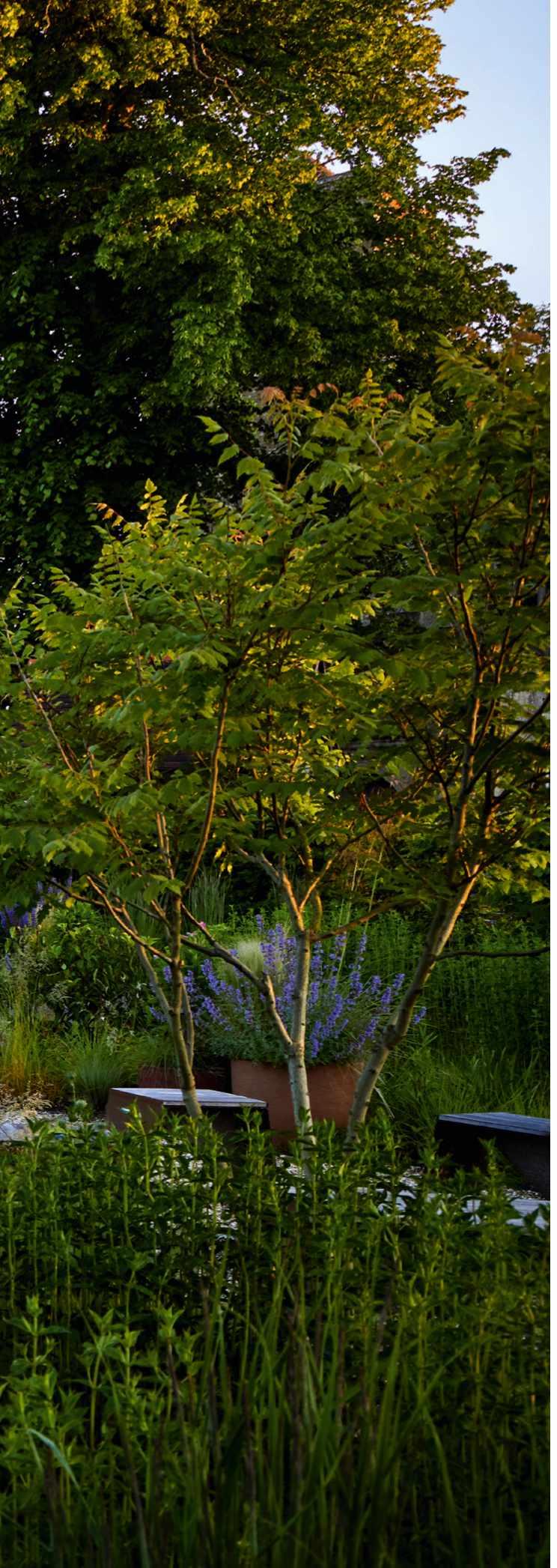
JUNE 2023 gardensillustrated.com 83 GARDEN COUNTRY
Above Stefano’s design is based around a series of interconnecting gravel paths that gently meander through a matrix of grasses and perennials, including Phlomis russeliana and Salvia x sylvestris ‘Dear Anja’. This is supplemented throughout the year with annuals, such as Nigella damascena, and a range of bulbs that flower at different times of the year, including Allium angulosum ‘Summer Beauty’. Structure and long-season interest is provided by Prunus lusitanica hedges and multi-stem trees including Cercis siliquastrum Koelreuteria paniculata Magnolia x loebneri ‘Merrill’ and Amelanchier x lamarckii

available for entertaining. A new front courtyard created a sense of arrival. Finally, a tall brick wall was demolished, linking the new courtyard and existing terrace.
“I wanted to create a low-maintenance garden to maximise biodiversity and sustainability,” says Stefano. “It is easier to celebrate plant diversity in smaller spaces by using informal plantings, so plants, especially grasses, can express themselves through their shape, form and colour.” This has resulted in a design that is delightfully understated and full of contrasting textures. Sesleria autumnalis and Sporobolus heterolepis create the matrix covering half of the ground, infilled with five different kinds of grasses, 30 forms of perennials and 16 different types of bulbs.
Spring is ushered in with drifts of snowdrops, yellow Eranthis hyemalis, blue Iris reticulata, and the chequerboard purple of Fritillaria meleagris, with a wealth of alliums, including Allium hollandicum ‘Purple Sensation’ and white Allium stipitatum ‘Mount Everest’ to follow. Drought-tolerant herbaceous plants, among them Salvia x sylvestris ‘Dear Anja’ with its spikes of blue and purple, and the slender, magentaflowered wands of Dianthus carthusianorum, emerge through the matrix of grasses. In summer, the grasses begin to flower. Sporobolus heterolepis becomes coriander scented in late July, while upright Calamagrostis x acutiflora ‘Karl Foerster’ acts a feathery backcloth and screen. Stipa ichu and a Prunus lusitanica hedge are planted in lines running parallel

to the barn, with the wispy plumes of the grass a softer reflection of the hedge. Echinops bannaticus adds spheres of silvery blue and Eryngium yuccifolium spectacular spiny architecture, while gorgeous Hylotelephium ‘José Aubergine’ blooms in dark maroon. Having contributed blue flowers in spring, the stems of Amsonia hubrichtii turn golden yellow in autumn and Schizachyrium scoparium ‘Ha Ha Tonka’, with its feathery edges and tones of grey, green and red, captures the low light. Inflated seedpods of Nigella damascena and brown candelabra seedheads of Phlomis russeliana remain through the winter, complementing the grasses, which turn beige, bronze and brown.
Several multi-stem trees, including Amelanchier x lamarckii, Magnolia x loebneri ‘Merrill’, Cercis siliquastrum and Koelreuteria paniculata help to anchor the planting and give the garden and courtyard structure. Stefano especially loves the Koelreuteria paniculata.“It offers so much,” he says, “yellow flowers, unique pink-tinted, inflated seedpods and yellow autumn colour. And they are extremely drought resistant, which is important in this area of low rainfall. I also use Rosa rugosa. It is robust, produces large, red hips, providing food for wildlife, has good autumn colour and looks like a wild rose.”
Maintenance in the garden is kept to a minimum. Two gardeners visit for just four days a year, reducing the disturbance for the owners and their neighbour. “Perennials and grasses are cut back in late February or early March, shredded, and then recycled
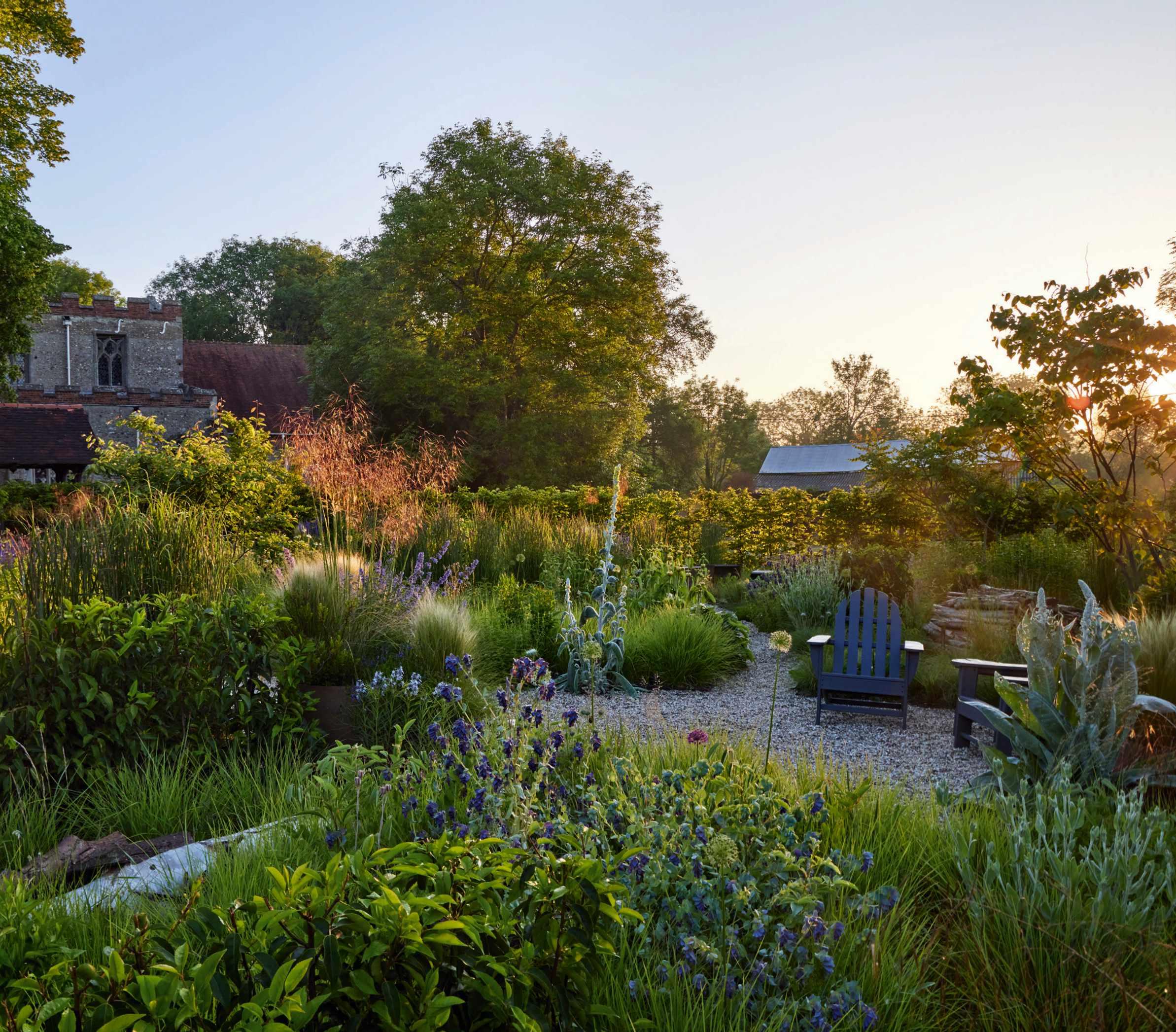
‘Karl
dark-purple Cerinthe
‘Purpurascens’
the delicate, star-shaped, pale-blue flowers of Amsonia hubrichtii, while the emerging silvery spikes of Verbascum bombyciferum will add bright-yellow tones later in summer. Within the planting, piles of logs create habitats for insects. Beyond the garden stands the old village church and churchyard, which features ancient lime trees that Stefano has ‘borrowed’ for the garden’s outlook.
JUNE 2023 gardensillustrated.com 85 GARDEN COUNTRY
Above Two gravel paths merge at a secluded seating area cocooned by tall grasses, including Stipa gigantea and Calamagrostis x acutiflora
Foerster’. In early summer, colour comes from
major
and
Above Trees such as the Judas tree, Cercis siliquastrum, which has leguminous, cerise flowers that hang directly from the stems in spring and bright-yellow foliage in autumn, act as anchors that unite the different spaces. Beneath each one, Stefano has used a variety of textures from herbaceous plants, such as salvias and Pycnanthemum muticum, in a matrix of Sesleria autumnalis and Sporobolus heterolepis
straight back on to the borders as a mulch.” They visit again in May to weed bare areas, which gradually reduce in size as the plants begin to spread. Then in July or August the Prunus lusitanica hedging is trimmed and the irrigation checked.
Although the base layer of grasses remains much the same, other plantings are more dynamic. “Self-seeding perennials and grasses are allowed to fill gaps to prevent spaces being colonised by weeds,” says Stefano. “Vigorous Pycnanthemum muticum, with its spreading rhizomes, and Phlomis russeliana are edited annually to prevent them from dominating and maintain a balance. My aim was to create plant communities within the matrix of Sesleria autumnalis and Sporobolus heterolepis so the garden is a harmonious composition, providing beauty through the seasons, whether viewed from indoors or out.” Beautiful it certainly is, and offers far more interest than an expanse of lawn ever could. ■
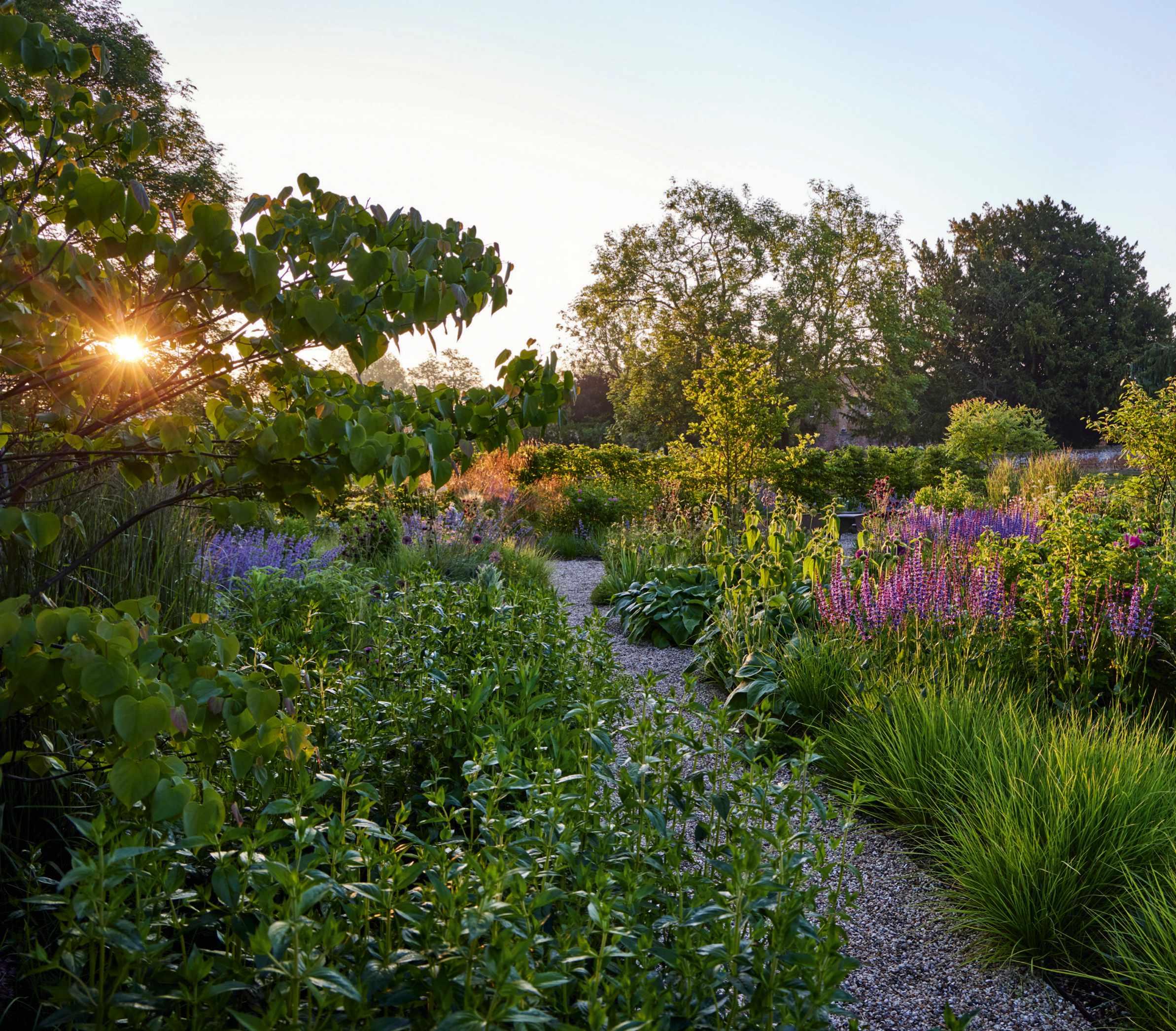
USEFUL INFORMATION
Find out more about Stefano’s work at stefanomarinaz.com
Join Stefano for a tour of Church Barn on 10 June, 10am-12.30pm, price £25. Stefano will also be leading two further tours on 13 September and 18 November. Follow Stefano on Instagram (@stefano.marinaz) or see his website for further details.
Creating plant communities
Stefano has ensured a long season of interest by using a wide range of different plant groups –bulbs, annuals, grasses, perennials, shrubs and trees – that work together as a community. For this to be successful, it’s important to choose plants that have similar growth rates and habits so there is balance within the plant community.“Combining plants with different seasonal growth is also useful,” says Stefano,“as this allows plants to flower and go dormant while others start showing new growth. And by doing this they hide the foliage of the plants going dormant.”
The key to success is ensuring around 30-40 per cent of the plants used are grasses, as this will help blend the mix of perennials and bulbs in a naturalistic way. This grass matrix should comprise clump-forming grasses that are ideally no taller than around 30-50cm, to avoid overwhelming the tall perennials. Grasses and perennials with narrow leaves are useful, so emerging plants don’t get shaded out. Plant the perennials in groups of 10-12 minimum, and in long, weavy layouts rather than blocks. Self-seeders such as nigella, honesty and California poppies will help fill any gaps in newly planted schemes, rather than leaving them open to weeds.
In this garden, Stefano has used the low-growing, clump-forming grass Sesleria autumnalis, with a mix of annuals and perennials including Nigella damascena, Gillenia trifoliata, Amsonia hubrichtii, Nepeta racemosa ‘Walker’s Low’ and Salvia x sylvestris ‘Dear Anya’.
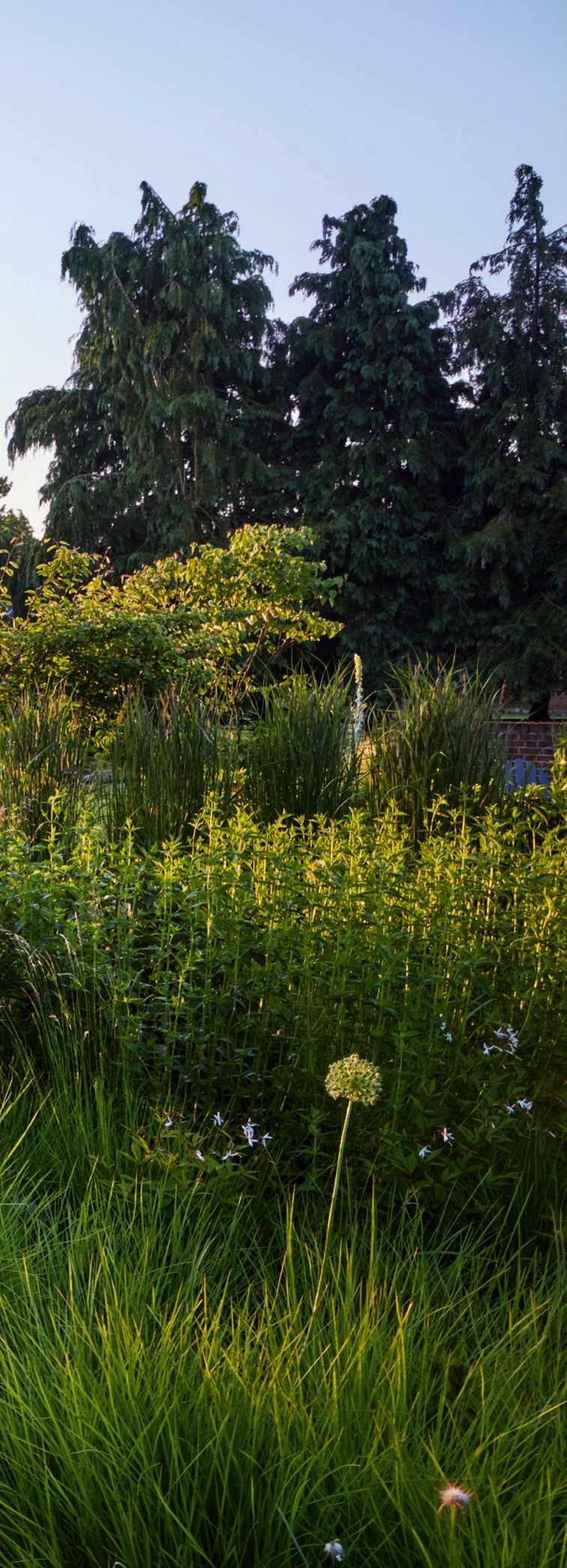
Above Stefano designed the bespoke furniture for this firepit area close to the barn, which is surrounded by shades of green and subtle hues of blue in the form of Salvia x sylvestris ‘Dear Anya’, growing in pots, and Nepeta racemosa
‘Walker’s Low’ mingling with the paler shades of Nigella damascena and Gillenia trifoliata. Close to the black-painted barn is a pop of pink from Rosa rugosa while white Rosa Claire Austin (=‘Ausprior’) is beginning to climb the black wall.

JUNE 2023 gardensillustrated.com 87 GARDEN COUNTRY
Nature first
Around
WORDS ANNIE GATTI PHOTOGRAPHS
IN BRIEF
Name Dowdeswell Court.
What The organically certified parkland and gardens of a Grade II-listed house. Where Gloucestershire.
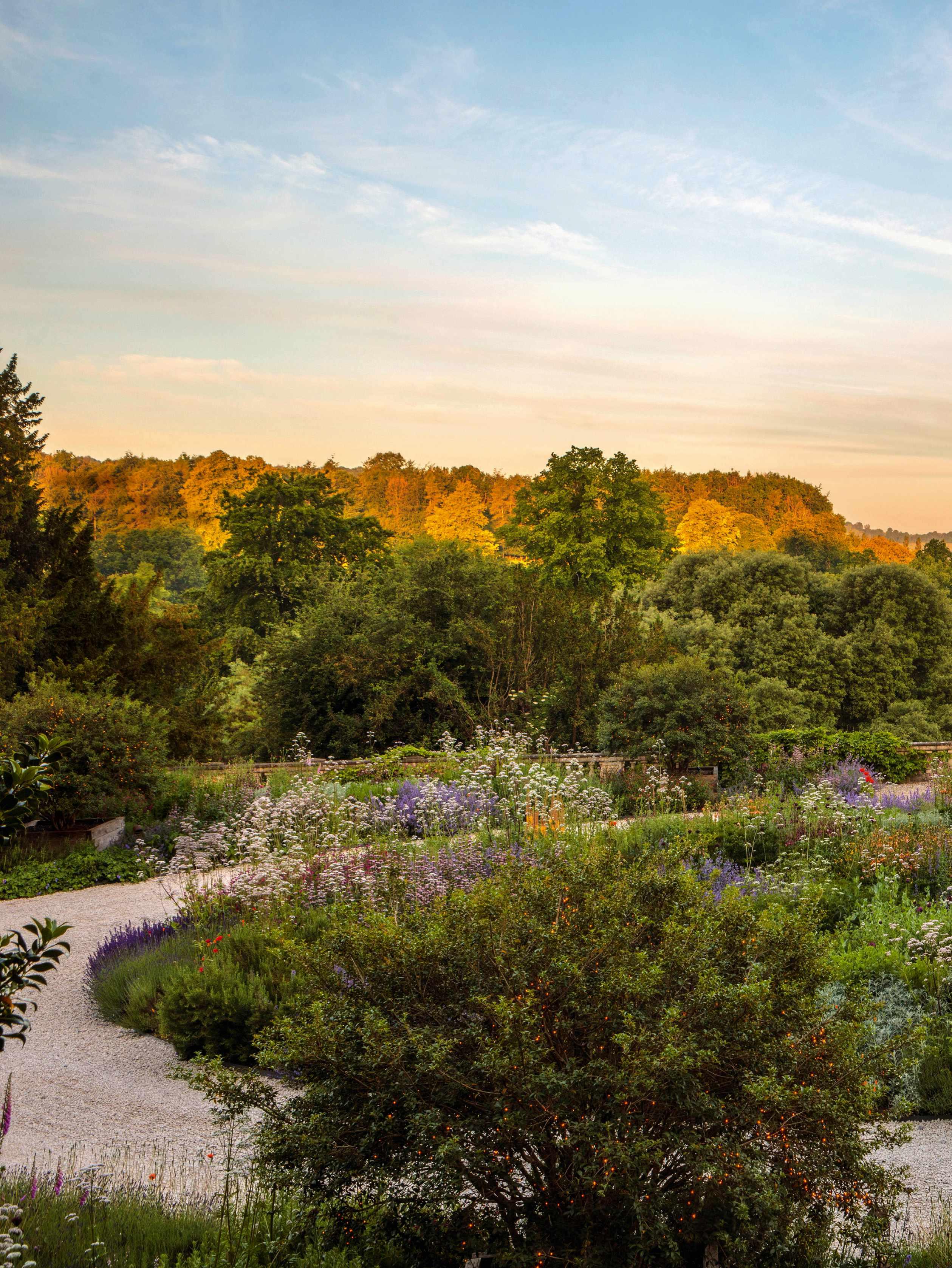
Size About 80 acres.
Soil Neutral soil on a limestone shaft.
Climate Relatively sheltered and the south-facing aspect of most of the planting means frosts are short-lived.
Hardiness zone USDA 9.
Planting in the entrance forecourt has been chosen to provide seasonality as well as food for pollinating insects. In the central bed, rosemary and lavender create a fragrant evergreen base for midsummer salvias, Verbena officinalis, Linaria purpurea and Phlomoides tuberosa ‘Amazone’.
88 gardensillustrated.com JUNE 2023
the Neoclassical home of Jade and Julian Dunkerton, Urquhart & Hunt has designed a garden that works in harmony with a variety of wildlife
CLIVE NICHOLS

GARDEN COUNTRY
Just 15 minutes drive from the fashionable Georgian spa town of Cheltenham is the restored Grade IIlisted house and gardens of Dowdeswell Court, the family home of Julian Dunkerton, co-founder of clothing brand Superdry, and Jade Holland Cooper, founder of British heritage brand Holland Cooper. Hidden from view below the entrance gates, the elegant Bath stone house, built in the Neoclassical style in the 1830s, is cut into the side of a steep hill that drops down to a brook and two lakes. This allows for stunning views across to pastures and woodlands on the other side of the valley.
When Julian invited design duo Lulu Urquhart and Adam Hunt to create new gardens for the 80-acre parkland, all that remained of the original plantings were a collection of specimen trees, including lime, beech, holm oak, chestnut, yew and Western red cedar, the remnants of an Italian pleasure garden and rolling expanses of grass. “We have a fierce passion for sustainability and wanted to preserve and nurture not only the historic plants but also the wildlife,” says Julian. “Key throughout is the organic certification.”
An ecological survey revealed that the grounds were home to five species on the IUCN Red List of Threatened Species – three species of bat, great crested newts and, in the lakes, white-clawed
crayfish – so the masterplan needed to make provisions for all of these, as well as addressing the remaining historical elements, which included a balustrade around the entrance forecourt and an ornamental pool. “We wanted to create something visually pleasing, definitely not formal, but relaxed and contemporary to match our vision for the house,” says Julian.
The designers realised they needed to enlarge the narrow terraces that abutted the house. “It was important to make the proportion of the house meaningful to the garden,” says Lulu, “and to deliver really spacious garden areas that had an elegance to complement the beautiful house.”
Seven years later, the forecourt is transformed into a celebration of naturalistic planting, dancing above a matrix of rosemary and lavender, and connected to the landscape beyond by a line of multi-stem Osmanthus x burkwoodii. “We felt the forecourt needed some constant evergreen forms,” says Adam, “and we like the looseness of Osmanthus and their scented flowers. They nod towards topiary but are not that formal.” A gap in the stone balustrade here opens up a breathtaking view down to one of the two lakes.
Inspired by the Arts and Crafts movement’s use of natural materials, Lulu and Adam chose Cotswold stone for the retaining dry-stone walls throughout the garden and for the generous
To continue turn to page 94
Above An informal gravel path provides a walkway along the historic balustrade, overhung with Wisteria sinensis f. alba in the entrance forecourt. From here, views to the west are framed by two statuesque Thuja plicata

Above right Delphinium ‘Blue Tit’, paired with Lilium ‘Pink Morning’ and Geranium ‘Orion’, create a midsummer hit at the back of the house.
Right The rear terrace leads on to a circular lawn with central lily pool. Topiary bays in pots, and the planting in the quadrant beds surrounding the pool, are developments in the planting by Jade’s mother, Miranda Holland, whose own career as a garden designer spans more than 30 years.
90 gardensillustrated.com JUNE 2023
The entrance is a celebration of naturalistic planting dancing above a matrix of rosemary and lavender
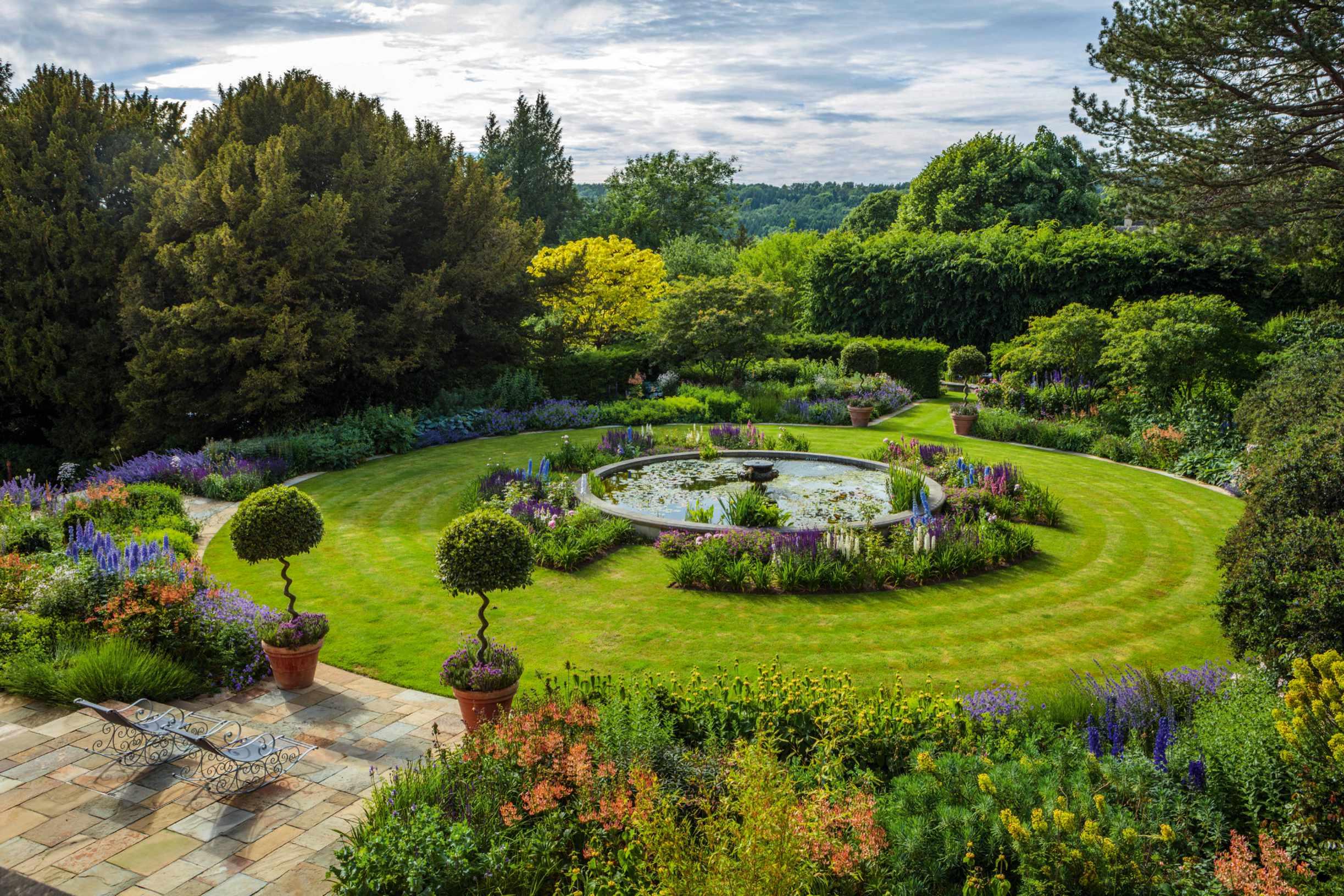
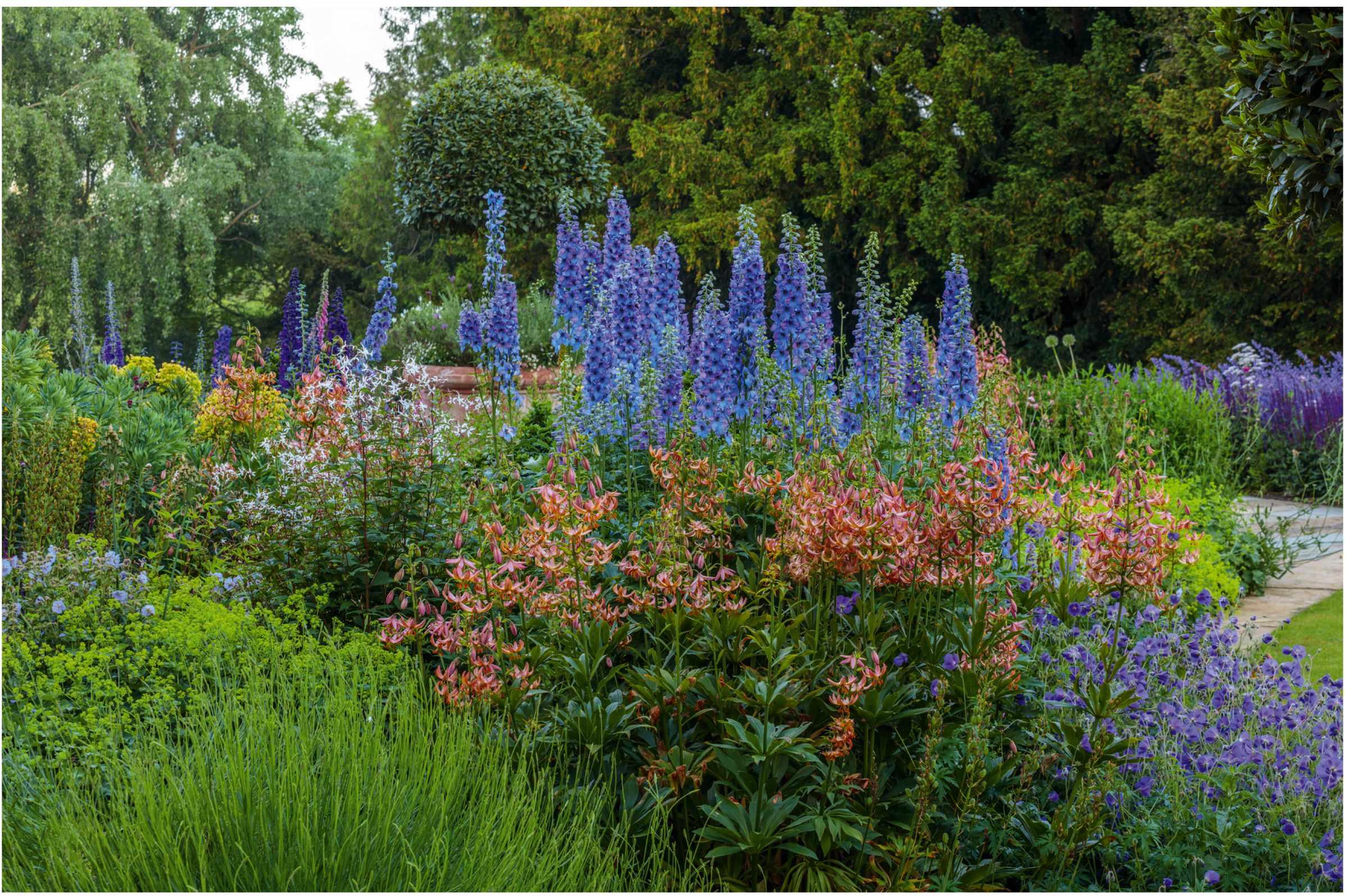
GARDEN COUNTRY
A woodland-edge planting of euphorbias, Libertia grandiflora and martagon lily hybrids L. ‘Terrace City’ and L. ‘Manitoba Morning’, are shot through with pools of Meconopsis betonicifolia in the shadier areas.
Cornus and woodland shrubs create a middle layer leading out from existing yews and conifers to the sheltered swimming pool. Positioned in full sun, this area allows Mediterranean plants, such as cistus and santolina, to thrive.
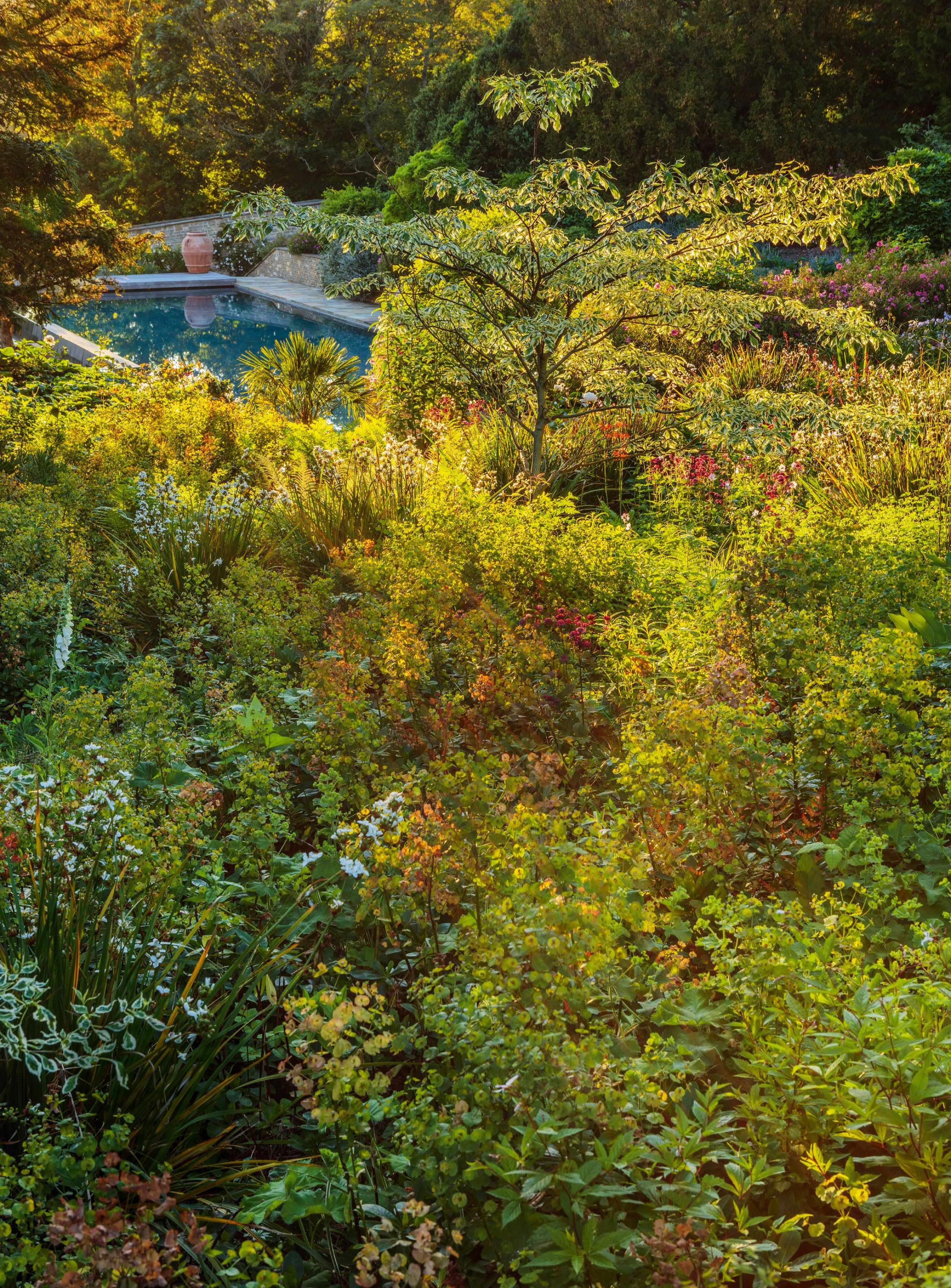
92 gardensillustrated.com JUNE 2023
Working with wildlife
When an ecological survey is done on a large garden, such as Dowdeswell Court, it can reveal a surprising range of inhabitants, some of which may be rare or threatened. This can mean that the owners have to make certain provisions to ensure these creatures are protected on their land.
At Dowdeswell, a vault beneath the main forecourt was discovered to be a main dormitory for bats, so a door has been fitted, with an entrance hole cut into it to allow the bats to come and go undisturbed. Lulu and Adam’s design also created ‘paths’ of vegetation at different heights,
to provide the bats with plenty of accessible insects for their night-time feeding. “A lot of people don’t realise that moths, in particular, are really important pollinators,” says Lulu. “There are a lot of wild plants, like stinging nettles, as well as scented night plants, that they thrive on.”
Lulu and Adam discovered the value of dry-stone walls as habitats for insects and amphibians. “Building the same wall with a cement-mortar mix will not provide a habitat,” says Adam. “Simple decisions like that, no matter what size your garden, can make the difference between habitat and no habitat.”
Steps made from oak sleepers make a rustic trail through a tunnel of mature yew trees, underplanted with ferns, that leads from the swimming pool to the Orangery terrace. Sweet woodruff, a source of nectar for bees and other pollinators, has been allowed to seed in the gravel.

GARDEN COUNTRY
terraces on the south and west sides of the house, which offer different views across the valley. Below the forecourt is a south-facing Orangery, which adjoins a 10m-wide oak pergola, covered in wisteria and framed with two Magnolia grandiflora, creating a Mediterraneanstyle space for entertainment. At the back of the house, another terrace provides an alfresco dining area, which overlooks a circular lawn surrounded by beds that billow with traditional summer flowers, such as delphiniums, lilies and nepetas. The large lily pond at the centre was created to replace a smaller original pool.
New sets of steps, hand cut from Forest of Dean stone, are an elegant solution to navigating the garden’s steep slopes, and form a network of links between the various spaces close to the house. Further down the slope, more rugged steps made from oak sleepers create a route past two ponds created for newts, and planted with a range of lush marginal species where these amphibians can hide.
The diversity of the garden’s spaces, and of their planting, is a particular delight to owner Jade. She has added an avenue of lime trees –gifts from guests at her wedding to Julian in 2018 – which leads to the entrance forecourt. The Orangery terrace and the swimming pool garden, surrounded by olive trees in pots and beds of cistus, santolina and myrtles, both create
a Mediterranean feel that she loves. “When it is sunny it transports you out of the Cotswolds to the Med,” she says. Beyond the swimming pool, further down the slope, is a new orchard that has been established around a few existing apple trees and is underplanted with carpets of spring and early summer organic bulbs. “This has more of a wilderness feel, as does the woodland area behind the lake and at the top of the property,” explains Jade. “I really like how the flower gardens blend into the wilder landscape.”
Since 2018, Jade’s mother, landscape and garden designer Miranda Holland, has taken on management of the garden, which employs four gardeners. They have developed a series of spring walks, planted with thousands of bulbs and hellebores, which create delightful new routes through the grounds. The next project is to transform a sloping walled kitchen garden into a cutting garden. The handsome oakframed glasshouse features not only organically grown vines, pleached peaches and salads for the table but also a sandpit for the couple’s children. “It’s important for me to instil in the children a passion for gardening,” says Jade. “To show them the journey from seed to eating.” ■
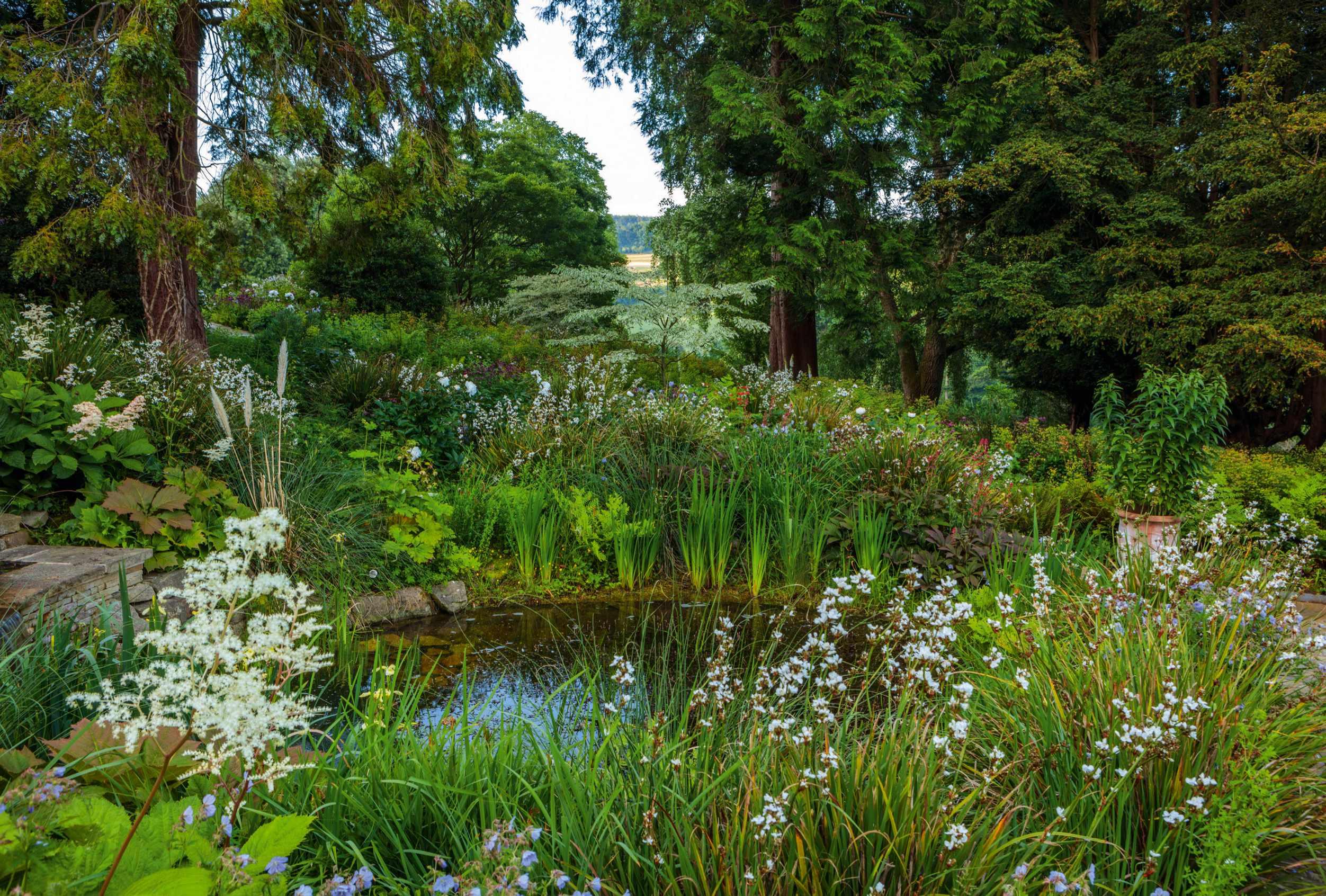
USEFUL INFORMATION
Find out more about Urquhart & Hunt at urquharthunt.com
Above Two small ponds were excavated to accommodate Dowdeswell’s resident newts, which prefer several smaller bodies of water rather than a single large one.
Above right A selection of marginals, including Libertia grandiflora, astilbes, rodgersias (R.‘Bronze Peacock’ and R podophylla) and irises (I chrysographes and I laevigata), provide the newts and other amphibians with plenty of hiding places.
Right The steep slope below the Orangery terrace, planted with myrtles, Rosa glauca Physocarpus and Prunus incisa ‘Kojo-no-mai’, creates a shrubby layer between the terrace and the green sward that drops down to the two lakes, which form the southern boundary of the property.
94 gardensillustrated.com JUNE 2023
We wanted to deliver really spacious garden areas that had an elegance to complement the beautiful house


GARDEN COUNTRY
Gathering attention
As garden designers start to reappraise lilacs, we take a look at the fascinating French history of the once ubiquitous English garden shrub and re-examine some forgotten cultivars
WORDS JOHN HOYLAND PHOTOGRAPHS MARIANNE MAJERUS
1 Syringa vulgaris ‘Cavour’
A particularly floriferous cultivar with short, conical spikes of deep-violet flowers. In cultivation since 1910 but now only found in specialist nurseries. Height and spread: 3m x 2.5m.

RHS H6, USDA 3a- 7b†
At the end of the Second World War, Ivor Novello’s We’ll Gather Lilacs was one of the most popular songs in Britain. Recorded by many performers, the sentimental song held out a promise to weary soldiers of a springtime reunion with loved ones, gathering lilacs and strolling down country lanes. What could be more British? Lilacs were a fixture of most gardens; their perfume was the scent of late spring and generous bouquets of the flowers were commonplace in parlours and sitting rooms.
The likelihood is, though, that those oh-soBritish shrubs were, in fact, French.
From the end of the 19th century until the 1930s, French nurseryman Victor Lemoine and his descendants introduced more than 200 different lilacs, and his plants dominated the European garden market, often sold, simply, as French lilacs. Before Lemoine began his hybridising work on the family, the only lilac available to most gardeners had been the species Syringa vulgaris, which has pale-mauve or, very occasionally, white flowers. But thanks to him, soon these deciduous shrubs, which are robust, floriferous and easy to grow, with flowers that give a heady fragrance, could be grown in a

A striking hybrid with mauve buds that open to reveal sky-blue flowers, the bluest of any lilac. It grows slowly and is difficult to propagate, which means it is rarely available. 3m x 2.5m. AGM*.
colour range from deepest purple through reds, pinks, blues and sparkling whites. Most forms are hung heavy with panicles of single flowers, but dozens of double-flowered forms were also bred by Lemoine.
Victor Lemoine set up his nursery in Nancy, northeast France, in 1849 and began creating stunning garden plants. His hybridising encompassed peonies, potentillas, pelargoniums, delphiniums, crocosmias, philadelphus and dozens more flowering plants. His legacy can still be seen in our gardens. But it was for lilacs that he achieved worldwide renown.
Lemoine had very few species to work with. He crossed Syringa vulgaris from
MANY THANKS TO LE JARDIN BOTANIQUE JEAN-MARIE PELT IN-NANCY, FRANCE, WHERE THESE IMAGES WERE TAKEN.
2 Syringa vulgaris ‘Firmament’
JUNE 2023 gardensillustrated.com 97 PLANTS LILAC
the Balkans with a heavily scented species from China, Syringa oblata. He also had one plant of a natural mutation with double flowers. The hard work of hybridising was carried out by his wife, Marie-Louise, atop a ladder, painstakingly hand-pollinating hundreds of flowers. In 1894, the Royal Horticultural Society honoured him with the Veitch Memorial Medal, the first time it was awarded to a foreigner. The RHS Journal called him ‘the greatest plant breeder the world has ever seen … a transcendent genius’. No mention was made of Mme Lemoine.
After Lemoine’s death in 1911, his son, and, subsequently, his grandson, took over the running of the nursery and continued his
hybridisation programmes until the nursery closed in 1968. The family’s lilac breeding legacy has been preserved in France by the Jardin Botanique Jean-Marie Pelt, where 214 forms of Lemoine’s lilacs are grown. Set in 35 acres of rolling hills on the outskirts of Nancy, the gardens are an ideal setting to compare the wide range of flowers the genus offers. The garden aims to celebrate the work of horticulturists from the region and ensure their plant heritage is preserved for future generations of growers and plant breeders.
Many of the plants that Victor Lemoine and his family introduced are still in cultivation and commercially available. Two of the most widely grown lilacs in Britain
3 Syringa vulgaris
‘Capitaine Baltet’
The flowerheads, which are smaller than most other cultivars, are crammed with purplish-red flowers that have petals overlaid with a blue sheen. 3m x 2m.
4 Syringa vulgaris
‘Étoile de Mai’
A double-flowered form introduced in 1905. The flowers have an outer ring of purplish-red petals, and an inner ring that have near-white reverses, to create a two-tone effect. 3m x 2.5m.
5 Syringa vulgaris ‘Congo’
The bright burgundy-coloured buds open to magenta flowers, which fade to purple as the season progresses. 3m x 2m.
6 Syringa vulgaris ‘Réaumur’
The dark magenta-red buds open to soft-pink flowers. For several decades after its introduction in 1904, this was one of Victor Lemoine’s most popular hybrids. It is still available through specialist lilac nurseries. 3m x 2.5m.
today are Lemoine hybrids: the dark-purple double flowers of Syringa vulgaris ‘Charles Joly’ is an established favourite and Syringa vulgaris ‘Madame Lemoine’, which received its RHS Award of Merit way back in 1891, is probably the most popular white-flowered cultivar available in garden centres.
The popularity of lilacs has waned since their pre-war heyday. The flowering season of April and May is frustratingly brief for modern gardeners, who increasingly want long-flowering plants. Like many shrubs, lilacs don’t sit comfortably in contemporary prairie-style gardens and naturalistic planting schemes centred on grasses and herbaceous perennials, but there are adventurous

98 gardensillustrated.com JUNE 2023
3 4 5 6
The hard work of hybridising was carried out by Lemoine’s wife, Marie-Louise, atop a ladder, painstakingly hand-pollinating hundreds of flowers
 7 Syringa vulgaris ‘De Mirabel’
7 Syringa vulgaris ‘De Mirabel’
LILAC
A floriferous cultivar with an upright habit and flowers with deep-violet petals that become fringed with pink to produce a two-tone effect. 3.5m x 2m.
PLANTS
WHERE TO SEE
• Golden Acre Park
Otley Road, Bramhope, Leeds, West Yorkshire LS16 8BQ. Tel 0113 261 0374, leeds.gov.uk
Holds the National Collection of Syringa
• Withdean Park
36 Peacock Lane, Brighton, East Sussex BN1 8NA. Tel 01273 292929, brighton-hove.gov.uk
Has an important collection of more than 250 lilacs.
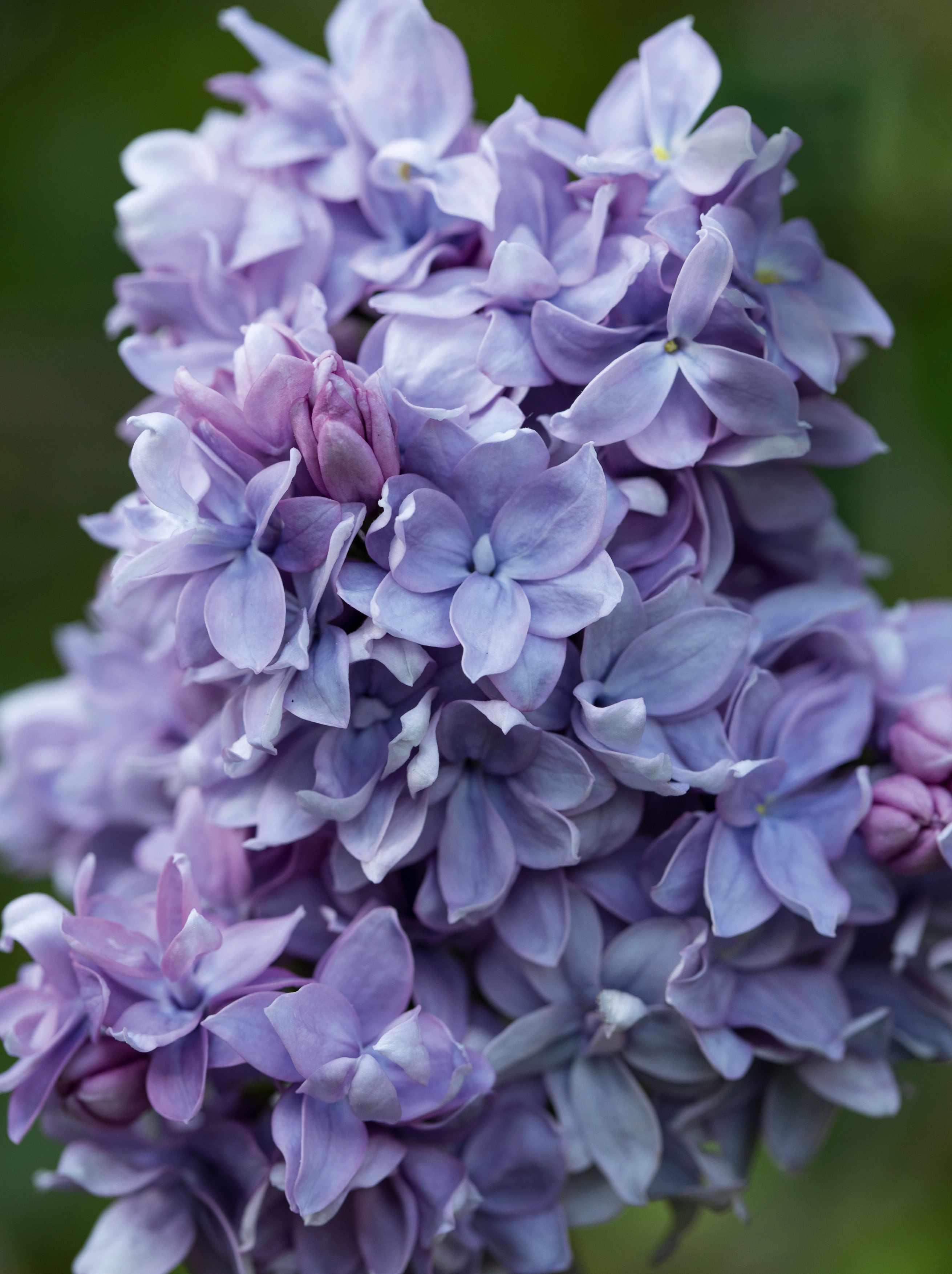
WHERE TO BUY
• Burncoose Nurseries
Gwennap, Redruth, Cornwall TR16 6BJ. Tel 01209 860316, burncoose.co.uk
• The Gobbett Nursery Farlow, Cleobury Mortimer, Kidderminster, Worcestershire DY14 8TD. Tel 01746 718647, thegobbettnursery.co.uk
8 Syringa vulgaris ‘Abel Carrière’
One of the results of Lemoine’s early breeding programme, this cultivar appeared in 1896. The panicles are upright and packed with pale-violet flowers that fade with age. 4m x 3m.
9 Syringa vulgaris ‘Madame Casimir Périer’
Introduced by Lemoine in 1894, and in cultivation ever since, it has creamy buds that open to double white flowers. It has a reputation for being able to withstand extremes of heat and cold. 3m x 2m.
10 Syringa vulgaris ‘Madame
Antoine Buchner’
A vigorous hybrid that left to its own devices will become much taller than most others. The pale-pink double flowers emerge from magenta buds. 5m x 5m. AGM.
11 Syringa vulgaris ‘Belle de Nancy’
Introduced in 1891, this was one of the first group of lilacs with double flowers and subsequently became a parent of many hybrids. The panicles are held upright on strong stems and are formed of mauve-pink flowers. 4m x 3m.
12 Syringa vulgaris ‘Vestale’
The compact trusses are tightly packed with pure-white flowers. Unless regularly pruned, this will grow into a much larger specimen than other cultivars.
6m x 2m. AGM.
*Holds an Award of Garden Merit from the Royal Horticultural Society.
†Most lilacs have a hardiness rating of RHS H6, USDA 3a-7b.
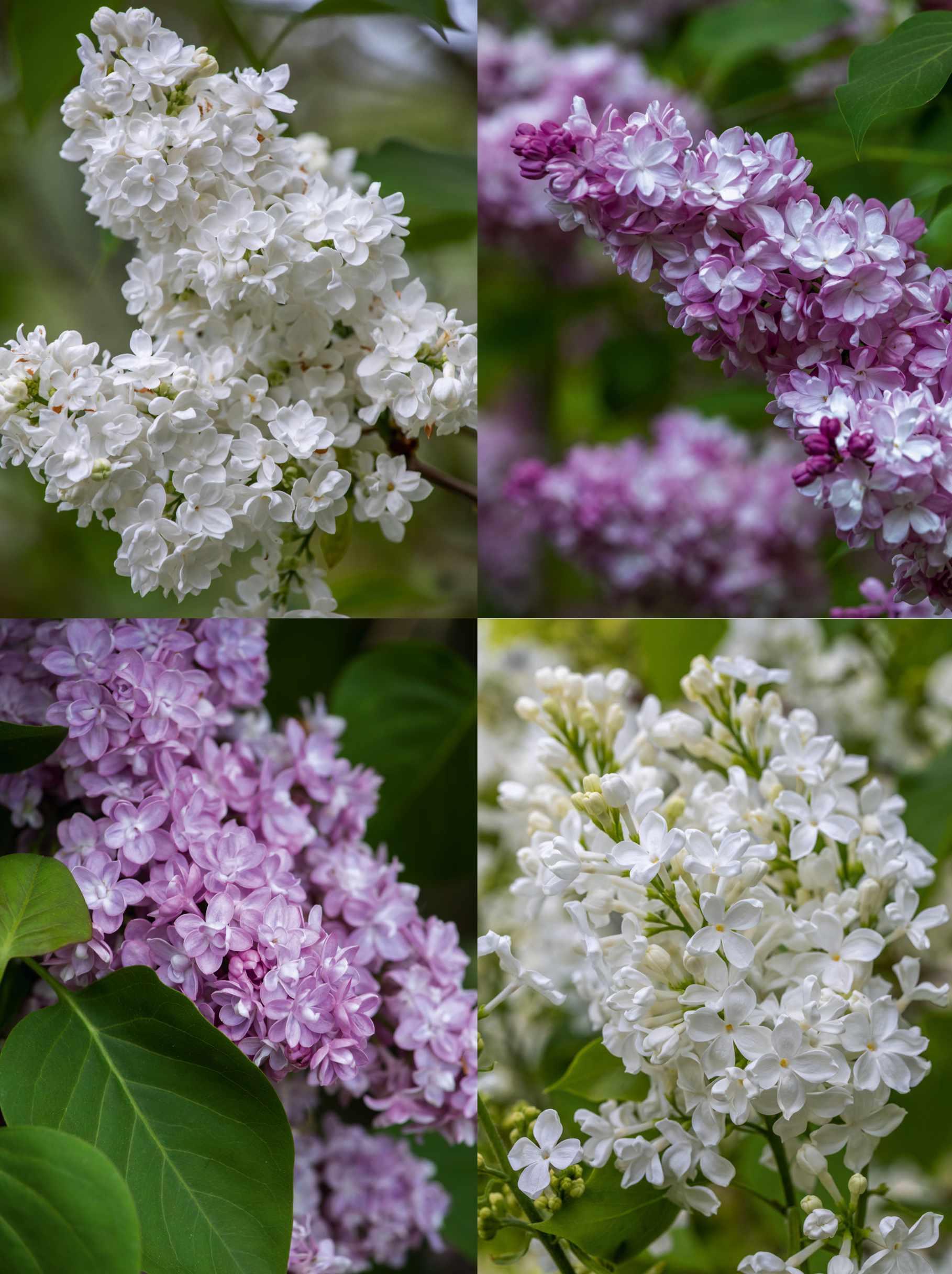
garden designers who are again turning their attention to flowering shrubs, and particularly those that can cope with extremes of cold and heat. Lilacs fit the bill perfectly. And modern-day plant breeders are introducing lilacs that are more compact or with a longer flowering periods. These introductions draw on a wide range of species, but most have a Lemoine hybrid as part of their parentage. ■
USEFUL INFORMATION
Address Jardin Botanique Jean-Marie Pelt, 100 Rue du Jardin-Botanique, 54600 Villerslès-Nancy, France. Tel +33 (0)3 83 41 47 47. Web jardinbotaniquedenancy.eu
Growing lilacs
• Lilacs are extremely hardy and will thrive in even the coldest parts of Britain. Although they prefer soils that are slightly alkaline, lilacs will grow happily on all soils that drain well. They will not tolerate standing for long periods in wet soils.
• The more sunshine a lilac receives the better it will flower, although lilacs will grow and flower well under the dappled shade of large trees in the hotter areas of the south of England.
• Promptly removing the spent flowers will prevent the shrub from expending energy on seed production and thus ensure plenty of blooms during the following spring. To remove the flowers, cut back to a leaf joint.
• Pruning after flowering can keep the shrub to the size and shape you want. Some cultivars will grow to around 4m but regular pruning will keep them much shorter without affecting flower production.
• Most lilacs are grown on their own roots (rather than grafted on to a rootstock), which means they will sucker gently. The suckers are never a major problem and are easy to remove with a sharp spade.
• Lilac flowers do not open much once they’ve been cut so choose blooms in full flower.
Cut lilacs also lose water rapidly, so strip away the leaves to reduce transpiration and soak stems in water before arranging.
9 10 11 12
JUNE 2023 gardensillustrated.com 101 PLANTS LILAC
IN BRIEF
What Small, suburban garden. Where The Netherlands. Size 360 square metres. Soil Heavy, alluvial clay. Climate Temperate maritime. Hardiness zone USDA 8b.
Clumps of Calamagrostis x acutiflora
‘Karl Foerster’ add height and rhythm to this sea of green. Repeat plantings of vibrant purple Salvia nemorosa
‘Caradonna’ are cooled by the pale spires of Sisyrinchium striatum
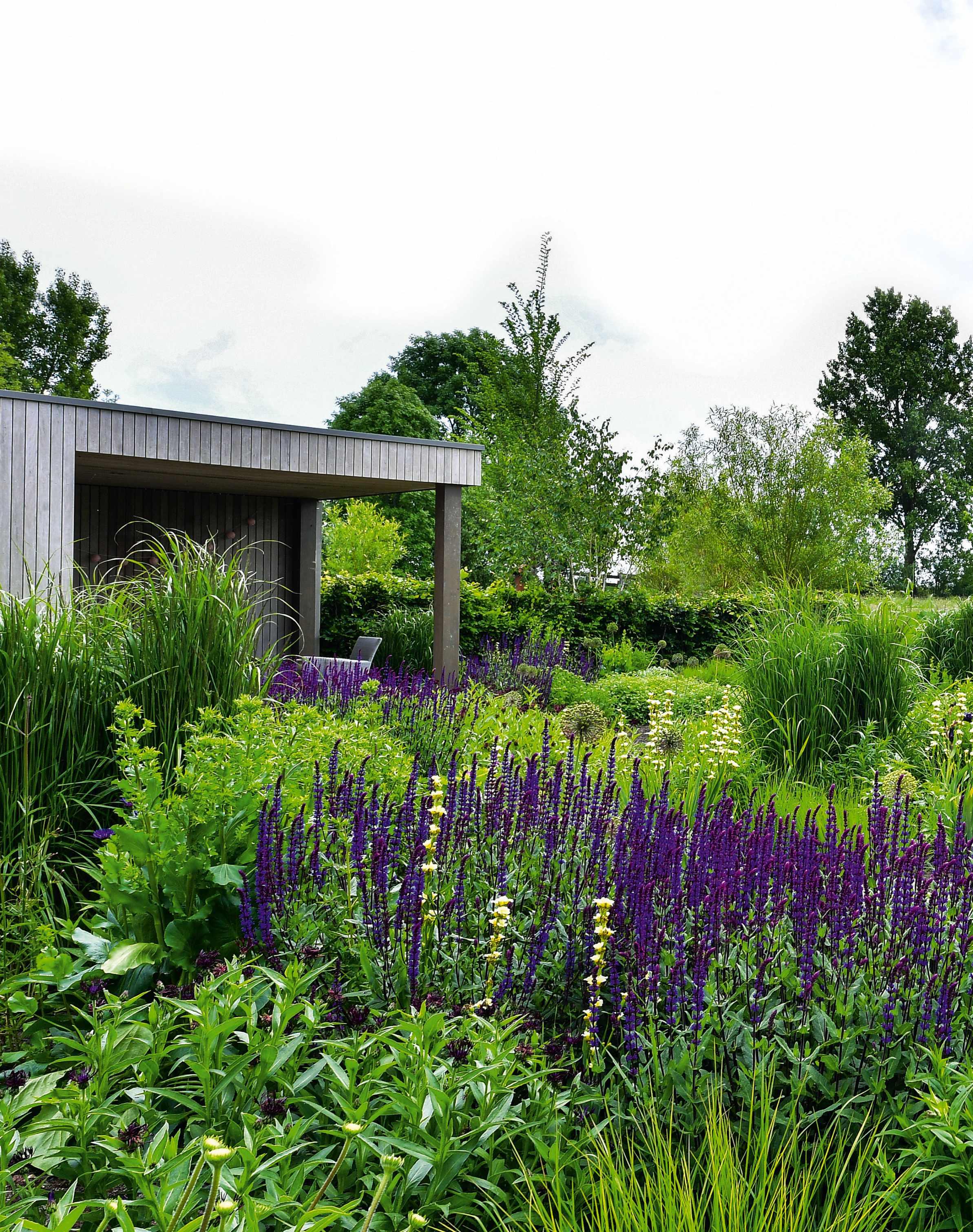
Change of tune
In this small Dutch garden, designer Jelle Koot has used a simple rhythm of repeated plants to create a calming, cohesive scheme
 WORDS ALYS FOWLER PHOTOGRAPHS SIETSKE DE VRIES
WORDS ALYS FOWLER PHOTOGRAPHS SIETSKE DE VRIES
JUNE 2023 gardensillustrated.com 103 GARDEN SMALL
Above Jelle wanted to bring the planting up right to the house so has installed a curved Corten-steel container large enough to grow a multi-stemmed Betula utilis subsp. jacquemontii ‘Doorenbos’. The potted tree also works like a divider, splitting the shaded terrace into two ‘rooms’ and making it a more intimate space.
Left Jelle is growing Trachelospermum jasminoides on the fence to help soften the hard edges of the boundary with the neighbouring house.
Below The lush, verdant planting envelopes the stylish garden shed and verandah and is energised in early summer with playful pops of purple from Iris ‘Dusky Dancer’, Allium hollandicum ‘Purple Sensation’ and Salvia nemorosa ‘Caradonna’.
Some people go to a particular garden designer because they know exactly what they’ll get. That’s not the case with the Dutch landscape designer Jelle Koot, who is curious, keen to experiment and wants his work to evolve. “I like to make each garden a very personal space,” he says. “A personal garden for each client.” This might mean a Mediterranean influence, or a forest garden, or something very modern. “I am not copying and pasting each design on to the next. This also means I get to learn a lot.”
Planting leads all of Jelle’s designs. He starts with trees and from there builds up a palette of plants that is rhythmic, playful and dances you around the garden, so no matter how big or small the space, you can lose yourself in that specific place, and forget, as Jelle puts it, “the rawness of the city, or the proximity of neighbours”.
When he was approached by the owners of a new-build house south of Amsterdam, he knew immediately that it would be important not just to create a sense of privacy, but also to connect the garden to the wider landscape. The house is one of several on an estate built on former farm land, and the garden is bordered by a stream and an old farm meadow with a dyke and a footpath down to a river. It is not a large garden by any means, so its 360 square metres must work hard. “I wanted the old farming landscape to be the focal point,” says Jelle.
He has used willow trees to unite the new garden with the established agricultural landscape in which the house sits. “Willow is part of the wetland beyond, but I used the more bushy, rosemary-leaved willow, Salix rosmarinifolia, in the garden, because it is more interesting and it works as a connecting plant,” he says. Not only does it connect to willows on the farmland beyond, but its leaf colour works well with the wood cladding on the house too. Jelle also added multi-stemmed birch, Betula utilis subsp. jacquemontii ‘Doorenbos’, as a nod to the pioneer plants that echo in the river landscape beyond and to create a

104 gardensillustrated.com JUNE 2023 GARDEN SMALL
provide top notes to the varied shapes and textures offered by the mix
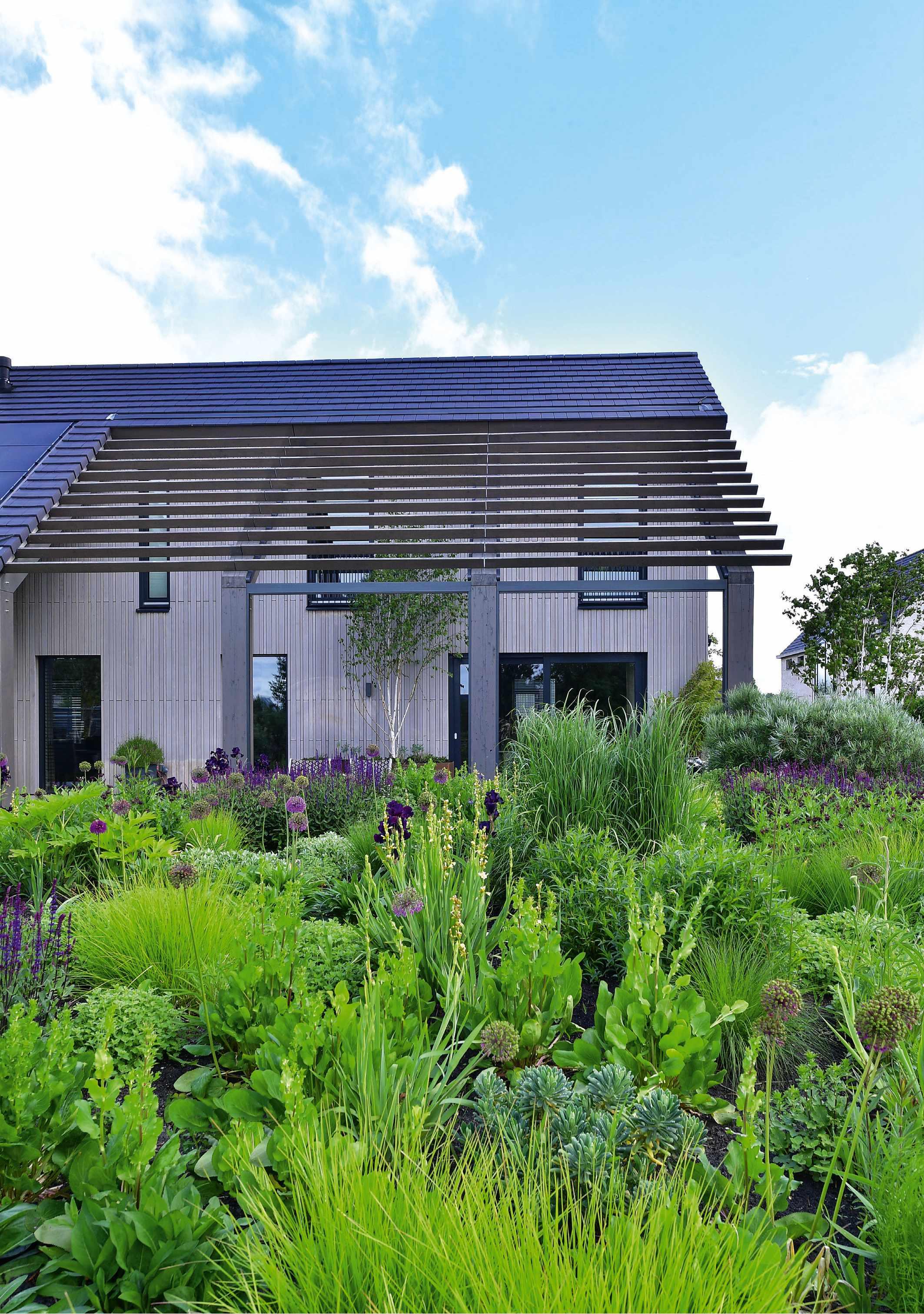 Small pools of purple from Iris ‘Dusky Dancer’, Allium hollandicum ‘Purple Sensation’ and Salvia nemorosa ‘Caradonna’
of green foliage and grasses.
Small pools of purple from Iris ‘Dusky Dancer’, Allium hollandicum ‘Purple Sensation’ and Salvia nemorosa ‘Caradonna’
of green foliage and grasses.
I like to make each garden a very personal space – a personal garden for each client
Rhythm in planting design
Jelle loves to play with rhythm in the garden, whether that’s with colour, texture, leaf shape or repeat use of a focal plant. “It allows you be the story teller,” he says. “It lets you create the pace with balance and peaks, but it also allows you to draw the eye outside of the garden too.”
Bigger groupings of plants can add drama, rather like the beat of a bass drum, while repeating an individual tree, such as the birch cultivar he has used throughout this garden, adds a calmer, quieter note. “In smaller spaces, you might just use a particular shrub,” he says. “An Osmanthus x burkwoodii, perhaps, for fragrance by the front door; then meet it again in the back garden.”
In a small, suburban setting like this, a sense of wildness is unexpected, and Jelle enjoys the freedom naturalistic planting gives, to play with what people see and feel. In this garden, he wanted to create the effect of a green river that flows through the space, punctuated by ripples of textural foliage, from ferns, grasses and Salix rosmarinifolia, or by colour accents such as the purple hues of Centaurea montana ‘Jordy’ and Salvia nemorosa ‘Caradonna’. In late summer, reds and yellows from plants such as Rudbeckia triloba ‘Prairie Glow’ and Achillea ‘Feuerland’ bring more dramatic heat.
A sinuous gravel path runs past repeated plantings of purple flowers and textural foliage, mimicking the stream that flows alongside the garden. The large willow trees in the wetland beyond are echoed in the smaller Salix used in the garden helping to blur the boundaries and making the garden feel much larger.

Left To connect the garden with the stream that borders it, and the wetland meadow beyond, Jelle used a bushy form of willow, Salix rosmarinifolia

Right In the shadier areas, Jelle has kept flowers to a minimum and linked repeated statement foliage plants, such as Polystichum setiferum and Euphorbia characias subsp. wulfenii, with groundcover Lonicera crassifolia ‘Little Honey’. Below The garden features a soothing palette of greens but retains visual interest with different shapes and textures, from the upright form and grassy leaves of Calamagrostis x acutiflora ‘Karl Foerster’ to the huge foliage of the giant butterbur, Petasites japonicus.
structural layer that would guide you through the garden. To emphasise this, he has created meandering gravel paths that lead down to the small stream overlooking the meadow beyond.
For Jelle, one of the biggest challenges on this project was the size of the terrace leading out from the house. Normally he likes to bring the planting right up to the door, but the large terrace offered no option for beds, so instead he brought in pots, including a Corten-steel planter big enough to hold another birch, which helps to connect the terrace to the wider garden. By using the same cultivar throughout the garden, Jelle has created a calm, unified space. The rest of the planting swirls around these trees. “I’ve used a base layer of plants to create green rivers, with ‘islands’ of flowers that reference each other, so that the areas of planting are always in communication with one another.”
Another challenge was the garden’s heavy clay soil, which had been heavily impacted by the house build. To create better drainage, Jelle took off 30-40cm of top soil and mixed it with compost and sand, and then angled the clay layer below this so water would flow down to the stream. Clay, however, is not something Jelle views as a negative. “I know people don’t like it, but once to you learn its ways, it’s so fertile.” Likewise, an area cast in deep shade. “I love shadows in gardens,” he says. “I love the mystery and calmness of a shade garden.” For this section, he added stepping stones, so the owners could easily get to their bins, but kept this part of the garden very cool with almost no flowers, other than Euphorbia characias subsp. wulfenii, and Lonicera crassifolia ‘Little Honey’, used as a groundcover on the suggestion of his uncle, whose nursery Kwekerij De Ent supplied most of the plants. The overall effect is dynamic; a garden that, like the stream it borders, is constantly rippling and flowing with light, with your movement through it, with the changing seasons. ■
USEFUL INFORMATION
Find out more about Jelle’s work at jellekoottuinontwerp.nl
JUNE 2023 gardensillustrated.com 107 GARDEN SMALL
Clockwise from top left On their seven-acre smallholding in rural Northern Ireland, Jo and Erin grow the fresh vegetables and flowers they use in their recipes. Cornflower petals make a wonderful addition to salads and puddings. Adding flowers to dishes is the perfect way to bring fresh flavours to summer lunches.
The petals of violas and garden pansies are ideal as decorations for cakes and biscuits, and the leaves have a mildly floral flavour that is lovely in salads.

Floral flavours
Adding
WORDS ERIN BUNTING AND JO FACER PHOTOGRAPHS SHARON COSGROVE
We are Jo (an organic gardener and teacher) and Erin (a cook, recipe developer and food stylist) and together we run The Edible Flower, a seven-acre organic small holding in Co. Down. We run supper clubs, cooking and growing workshops, volunteer days and a CSA (community-supported agriculture) scheme called Farm & Feast.

Our mission is to grow and cook truly sustainable, delicious food – for the customer, grower, and the planet. To connect ourselves and our community to the soil, the seasons, and our food. And to bring joy and beauty while doing all the above.
We called ourselves The Edible Flower because for us, growing, cooking with and eating edible flowers summed up the ethos of our business. We aren’t experts on every cuisine, but certainly edible flowers are widely used in many cultures around the world. I think as humans we are intrinsically attracted to flowers – they bring beauty and joy and often have special cultural and spiritual significance too. It’s natural that when they are edible, and often very flavourful, we’d want to bring them on to our plates too.
It’s also worth remembering that almost all the plants we eat are flowering plants – everything from wheat and rice to courgettes and tomatoes. Flowers create our food, and we are often eating flowers even when we aren’t thinking about it – cauliflower and broccoli are both flowers.
Why grow edible flowers?
We grow edible flowers primarily because they bring us great joy. They are beautiful in the garden, and beautiful when we use them in food. They bring pollinating insects into our garden in great numbers. We don’t get many calories from edible flowers, but we get some unique flavours and a big helping of happiness; there is something truly magical about growing food from scratch and then eating it.
Many edible flowers have delicious and interesting flavours that you won’t encounter anywhere else. Sometimes that flavour is announced by their smell (think of lavender, roses or camomile), but sometimes it is more surprising. Nasturtiums smell of roses and honey, but are full of peppery punch; magnolia’s sweet, citrus smell belies its strong, spicy, gingery flavour.
Think of using edible flowers for their flavour the way you might use fresh herbs: sprinkle spicy calendula petals over your salad instead of basil; use mild, cooling borage flowers instead of mint; or substitute bright, menthol lavender for rosemary in marinades or when roasting meat or vegetables. As with herbs, spices and other aromatics, you can preserve the flavour of edible
flowers by drying them or by making cordials and syrups, floral sugars and vinegars to use all year round.
We live in rural Northern Ireland. It is not the most hospitable of climates for growing flowers, so if we can grow something, you probably can too. Our edible flowers are seasonal, and we don’t currently grow in polytunnels or under heat lamps, although we will overwinter a few flowers in our greenhouses to extend the season a little. For us, cooking with edible flowers is a way of marking the changing of the seasons, of signifying that this food is from this place at this very moment. The delicate violas and primroses of late winter are joined by calendula, borage and tulips in mid-spring. As we tip towards the summer solstice, the hedgerows are full of elderflower and hawthorn and the garden has jaunty cornflowers, camomile, dill and wispy coriander. Once all danger of late frost has passed, we can look forward to the summer bounty of nasturtiums, marigolds, dahlias, courgette flowers and more.
BUY THE BOOK
This is an edited extract from the book The Edible Flower: A Modern Guide to Growing, Cooking and Eating Edible Flowers by Erin Bunting and Jo Facer, which is published by Laurence King, priced £30.
JUNE 2023 gardensillustrated.com 109 RECIPES EDIBLE FLOWERS
common flowers, such as marigolds, carnations, nasturtiums and dahlias, to your recipes can bring a delicious twist to the simplest of dishes
Turn the page for three delicious recipes from Erin
Jo Facer (left) and Erin Bunting at home in Co. Down with their daughters.
METHOD
1. Put the flour in a large bowl, make a well in the middle and crack in the eggs. Using a fork, gently mix the flour into the eggs, then use your hands to bring the mixture into a dough; it will come together as you knead it.
2. Turn the dough out on to a clean work surface and knead for about 5 minutes, until the dough is smooth and feels silky. If it still seems dry at this point, knead in a few drops of water. Put the dough in an airtight box or wrap it in plastic wrap and leave to rest for at least 30 minutes or up to 2 hours.
3. Cut the dough in half, dust it lightly with flour and roll it through the widest setting on the pasta machine. Fold the rolled dough like a letter, then pass it through the widest setting again. Repeat the fold and roll through one more time.
4. Narrow the setting on the pasta machine by one, and roll the pasta through again.
Recipes
These three recipes from chef Erin Bunting show how using flowers not only brings an element of beauty to the food on our plates, but can offer new and exciting flavours too
Marigold petal pasta
I love the scent of French marigolds, but I’m not a big fan of eating the petals raw, because the citrusy flavour is overwhelmed by bitterness. But I have discovered that once they are encased in pasta and cooked, their herbal flavour with its hint of grapefruit shines through and is a delicious match for a sage butter sauce. I recommend using a pasta machine for this recipe. If you don’t have one, ask around – someone may be willing to lend one. You can roll the pasta by hand, but it’s hard work and you do need even pieces to fold on top of each other.
All sorts of edible flowers and leaves will work for this recipe, including borage, calendula and nasturtium. Just remember to pick off the petals and use small sprigs of leaves; anything too chunky might tear the pasta.
INGREDIENTS
Serves 4 as an appetiser or 2 as a generous main dish
• 200g pasta flour (or use strong white flour), plus extra for dusting
• 2 large eggs
• Petals from 8 French marigold flowers
• Handful of marigold leaves
• 40g butter
• 20 sage leaves
• Salt and freshly ground black pepper
• Semolina for dusting
• Grated Parmesan, to serve
Keep rolling and narrowing the setting until the pasta is one setting thinner than you want it to be. If the sheets become unwieldy, cut them in half. Dust your work surface with flour to stop the pasta from sticking.
5. Cut the pasta in half horizontally using a sharp knife. On one sheet arrange the marigold petals and leaves in a pattern. Then, dusting off any excess flour, place the second sheet on top and press it down gently so that the two sheets are stuck together with the petals and leaves in the middle. If necessary, use a rolling pin to roll over the pasta lightly and stick everything together.
6. Set the pasta machine to one setting wider than the last one you used and roll the double sheet of pasta through again. Cut the pasta into strips 2-3cm wide. Put the cut pasta on a tray dusted liberally with semolina, or hang it over a pole or clean
clothes airer if you are worried about it sticking. Repeat with any remaining pasta sheets, if you cut the pasta earlier because it was getting too large. Then repeat with the second piece of dough.
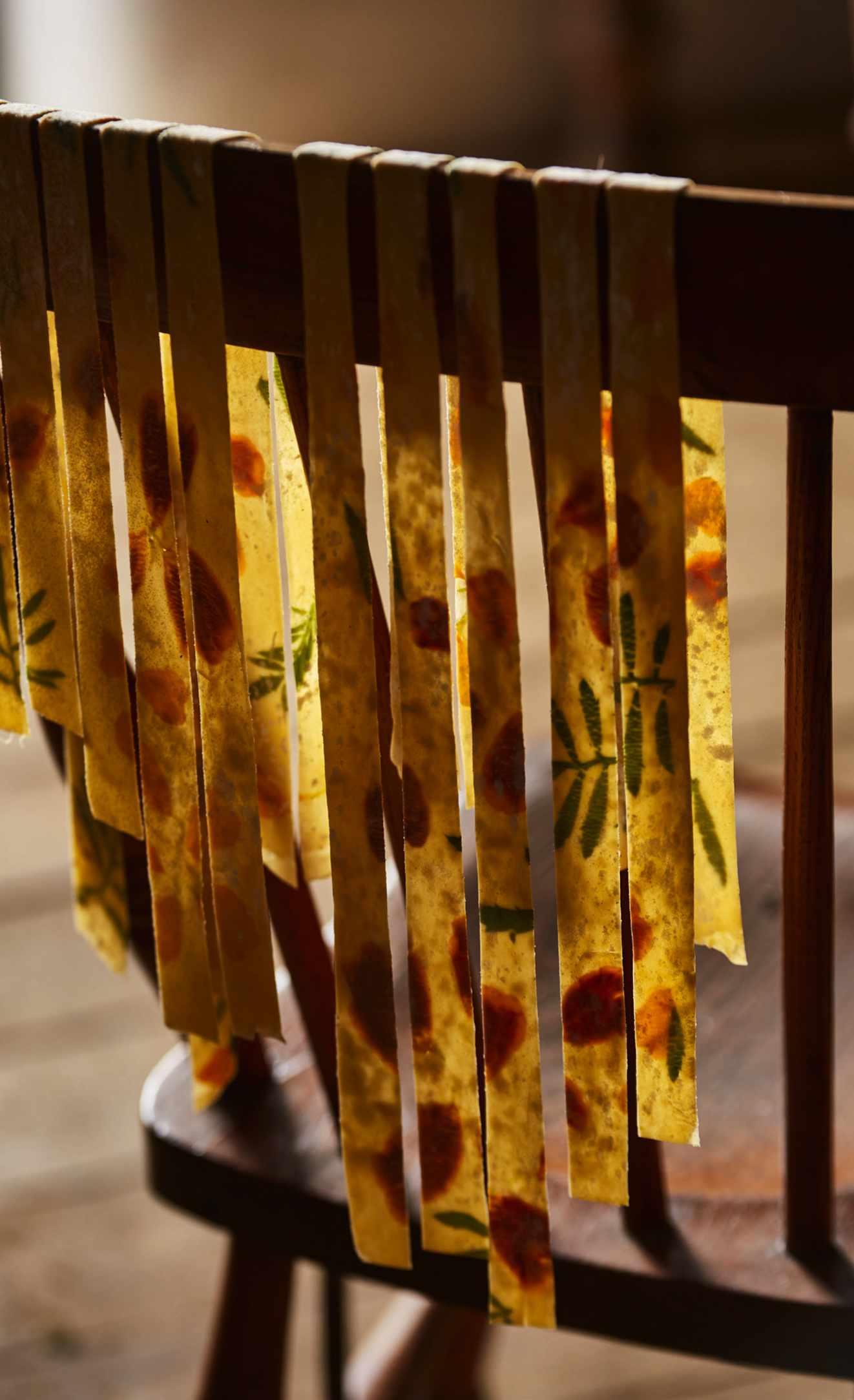
7. Fill a large pan with water and bring to the boil. Meanwhile, put a wide pan over a medium-high heat. When it is hot, add the butter and cook for a couple of minutes, until you start to see brown specks. Immediately toss in the sage leaves and cook for 30 seconds, until the sage is crisp. Remove from the heat.
8. Once the pasta water is boiling, salt it generously. Add the pasta and cook for 4 minutes. Drain well and add to the sage butter in the wide pan. Toss the pasta in the butter and season with black pepper. Serve in warm bowls, topped with grated Parmesan.
110 gardensillustrated.com JUNE 2023
RECIPES EDIBLE FLOWERS

Gardening is a fantastic hobby, helping to boost mental health and spiritual well-being; so now is the time to get out into the garden to discover and enjoy the beauty of nature and we at Peter Beales are aiming to help you achieve that.
We feel that every garden deserves a rose and every rose from our extensive world leading collection is of the finest quality, carefully selected and hand cultivated to the highest of standards here in East Anglia.
With over 800 varieties available, we are positive you’ll find the perfect roses for your garden.

rosa ‘Minnehaha’
• MAIL ORDER • SPECIALIST PLANTS www.classicroses.co.uk 01953 454707 Norfolk NR17 1AY
Every
garden deserves a rose...
Scan me
Carnation and blackberry cooler
I find that you can extract the flavour from even not particularly scented carnations by making a syrup. The petals also give up their colour in the boiling water, so if you use coloured flowers you end up with a beautiful pink or red syrup that looks and tastes amazing in a cocktail. I often use frozen blackberries, since they cool the cocktail as you make it. It works well without the vodka, too, but you might want to add a splash more syrup to taste.
INGREDIENTS
Serves 2
For the carnation syrup: (makes about 400ml)
• 15g carnation petals (about 30–40 flowers)
• 300g sugar
For the cocktail:
• 50g fresh or frozen blackberries
• A few basil leaves, plus extra to garnish
• 100ml vodka (optional)
• Juice of 1 lime
• 300ml sparkling water
• Couple of carnation flowers (here we have used Dianthus caryophyllus), to garnish
METHOD
1. To make the syrup, put the petals in a bowl or jug, pour over 300ml boiling water and leave to infuse overnight, or for at least 12 hours.
2. Strain the resulting liquid into a small pan and add the sugar. Heat gently, stirring, until the sugar has dissolved, then increase the heat and simmer for a minute. Remove from the heat and allow to cool, then pour the syrup into a bottle or jar and store in the fridge. It should last for a couple of weeks in this way; for longer storage, I recommend freezing it.
3. To make the cocktail, put the blackberries and basil in a cocktail shaker or jug and crush together with a cocktail ‘muddler’ or the end of a wooden spoon. Add 80ml carnation syrup, the vodka and lime juice, and shake or stir well.
4. Put ice cubes in two highball glasses and strain half the mixture into each glass. My cocktail shaker has a coarse strainer that means some, but not all, of the blackberry bits end up in the drink. If you like, you can use a sieve to strain the mixture and then add a little of the crushed blackberries back to the drink. Top up with sparkling water and garnish with basil and carnation flowers or petals.

112 gardensillustrated.com JUNE 2023 RECIPES EDIBLE FLOWERS
METHOD
1. If you are straining the yoghurt, put it in a sieve or colander lined with a piece of muslin or a clean dish towel and set it over a bowl. If you can, tie up the ends of the cloth and suspend it from a hook or cupboard handle above a bowl, so gravity helps to strain the yoghurt more quickly. Otherwise, just give the cloth a little shake or stir every so often. Leave it for a couple of hours. You will be left with thin milky coloured water in the bowl and thick yoghurt in the cloth. If you want you can keep the milky water to use in bread-making.
2. Preheat the oven to 160ºC/320ºF/Gas 3. Scrub the beetroots well and put them in an ovenproof dish with a lid. Drizzle over a little olive oil and season well with salt. Toss the beetroot in the oil and salt until they are well coated, then put on the lid.
Roasted beetroot and tomatoes with yoghurt and nasturtium salsa

I love this combination of warm roasted vegetables with cool yoghurt and a drizzle of peppery salsa verde. I particularly love the colours, as the pink beetroot bleeds into the yoghurt and contrasts with the red tomatoes, the green salsa and the brightorange petals. Use small beetroots if you can – they are generally sweeter. Remember to start making this dish in good time, since it will take you a couple of hours to strain the yoghurt. To save time, you could use Greek yoghurt instead.
INGREDIENTS
Serves 4 as a side dish
• 500g plain yoghurt
• Olive oil
• 400g beetroot
• 200g cherry tomatoes
• 25g walnuts
• 100g mixed nasturtium leaves and flowers
• 10g fresh ginger, peeled and grated or finely chopped
• Pinch of sugar
• 1 garlic clove, peeled and grated
• Salt and freshly ground black pepper
• Tiny nasturtium leaves or petals, to garnish
• Bread, to serve
3. Cut the cherry tomatoes in half. Toss with 2tsp olive oil and plenty of salt and pepper, then arrange on a baking sheet, cut sides up.
4. Bake the tomatoes for 1½ hours, until soft, sticky and sweet. At the same time, cook the beetroot for about an hour, checking after 45 minutes to see if they are soft by sticking a small, sharp knife into the centre of one.
5. Meanwhile, put the walnuts on a baking sheet and roast in the oven for 15 minutes. Allow to cool and then roughly chop into large chunks.
6. When the beetroots are soft, take them out of the oven and leave them to cool in the dish with the lid on. Sealing the moisture in means they will be easier to peel once cool.
7. Once the beetroots are cool enough to handle, peel and cut into wedges. If they are fresh enough, the skins should slip off.
8. Put the nasturtium leaves and flowers in a food processor with the ginger and pulse a couple of times until finely chopped. Drizzle in 4tbsp olive oil, the sugar and a pinch of salt, and pulse again briefly to combine. Taste, and add more salt if necessary. Alternatively, chop everything finely by hand and mix in a small bowl.
9. Add the garlic to the yoghurt and season well with salt and pepper. Put the yoghurt on a plate or small platter, using a spatula or the back of a spoon to spread it out. Drizzle over two thirds of the nasturtium and ginger salsa, swirling it a little into the yoghurt, then arrange the beetroot and tomatoes on top. Dot over the remaining salsa, sprinkle with the walnuts and garnish with nasturtium petals or small leaves. Serve with plenty of bread to mop up the yoghurt.
114 gardensillustrated.com JUNE 2023 RECIPES EDIBLE FLOWERS
This was Sylvia’s promise to you...
A generation ago, a woman named Sylvia made a promise. As a doctor’s secretary, she’d watched stroke destroy the lives of so many people. She was determined to make sure we could all live in a world where we’re far less likely to lose our lives to stroke. She kept her promise, and a gift to the Stroke Association was included in her Will. Sylvia’s gift helped fund the work that made sure many more of us survive stroke now than did in her lifetime.

Sylvia changed the story for us all. Now it’s our turn to change the story for those who’ll come after us.
Stroke still shatters lives and tears families apart. And for so many survivors the road to recovery is still long and desperately lonely. If you or someone you love has been affected by stroke – you’ll know just what that means.
Rebuilding lives after stroke
But it doesn’t have to be like this. You can change the story, just like Sylvia did, with a gift in your Will. All it takes is a promise.
You can promise future generations a world where researchers discover new treatments and surgeries and every single stroke survivor has the best care, rehabilitation and support network possible, to help them rebuild their lives.
Will you make that promise to generations to come? Please, leave a gift in your Will to the Stroke Association.
Find out how by calling 020 7566 1505 or email legacy@stroke.org.uk or visit stroke.org.uk/legacy
The Stroke Association is registered as a charity in England and Wales (No 211015) and in Scotland (SC037789). Also registered in the Isle of Man (No. 945) and Jersey (NPO 369), and operating as a charity in Northern Ireland.

Waterfront green
Rotterdam-based LOLA Landscape
Architects has designed extensive green spaces to surround a new residential tower in the Dutch city of Nijmegen. At 120 metres tall, the tower, Duet, designed by Dutch architecture practice Powerhouse, in collaboration with de Architekten Cie, will dominate the city’s riverside area, and will lead out on to a leafy public square at ground level. Nearby an expansive park, accessible by ramps, will sit on the roof of a multi-storey car park and provide ample space for residents to socialise outside, and reinforce an existing green corridor that links Nijmegen’s central station to the waterfront. lola.land; powerhouse-company.com


WORDS MOLLY BLAIR; IMAGES PROLOOG News, garden design insight and sourcebook JUNE 2023 gardensillustrated.com 117

FLOW STATE
The brief
This courtyard garden in Provence, part of an old mas or agricultural property, was open to the road and full of rubble when designer James Basson first saw it. The striking new design is the result of a collaboration between James and the owner, a bold American client.“She was hugely inspired by the landscapes of the Spanish landscape architect Fernando Caruncho, known for his daring, minimal, agricultural landscapes around big rural properties,” explains James.“She loved that look, and it was very different from what we do, which is a bit prettier, more planty and less structurally focused. So we had this nice contrast between who and what we are, and who and what she is.

“The client wanted something strong but that allowed us to be creative and come up with solutions, as long as it fitted with her aesthetic. She was prepared to put a big budget into a small space so we could really do something compelling.” The Caruncho influence aside, the client stipulated no other requirements for the garden.
The design
James took inspiration in part from Christopher Bradley-Hole’s Daily Telegraph Garden at the RHS Chelsea Flower Show in 2013, an abstraction of the English landscape that was divided into many distinct blocks. Echoing Caruncho’s bold references to his local landscapes, James decided to evoke the patterns of the nearby field systems and the industrial raised canals of the Durance flood plain.
He came up with a scheme comprising steel-edged beds, which are a nod to the local fields, each minimally filled with just one or two plant species. These ‘fields’ are dissected by deep and narrow steel ‘canals’ or troughs, around which rainwater is gently pumped via a highly sophisticated but simple-looking system. The same steel is used for a decorative pergola and gate.
Turn the page for James’s design ideas
DESIGN INSIGHT JUNE 2023 gardensillustrated.com 119
Designer James Basson has created a bold walled garden in Provence that reflects the canals and fields of the local landscape
WORDS VERONICA PEERLESS PHOTOGRAPHS MARIANNE MAJERUS
Left The courtyard was originally open to the road, so James designed a new wall made of local stone, creating a walled garden. Mild-steel troughs dissect planting beds that contain a mix of clipped and informal plants. Almond trees are a nod to the orchards that surround the property.
Essential elements
5
7
PERGOLA
The pergola, made of the same mild steel as the water troughs, was shaped and constructed by a local forge. “The troughs are highly engineered and industrial, whereas the pergola has a more organic quality,” says James. “Of course, in the long run it would be useful to give some shade by growing a vine or wisteria up it. I often cover the top of a pergola with split cane, which I like because it breathes, and can be removed once plants have grown up it.”
GATE AND WALL
The orchards around the property were inspiration for the gate, made by the same forge that constructed the troughs. “The artist Mondrian did drawings of an apple tree, breaking it down into simple lines, which we reinterpreted here.” The courtyard was previously open to the road, so a stone wall was built to give a walled-garden effect. At one point, a trough cuts through the wall, suggesting that it continues beyond the property (see facing page, top).
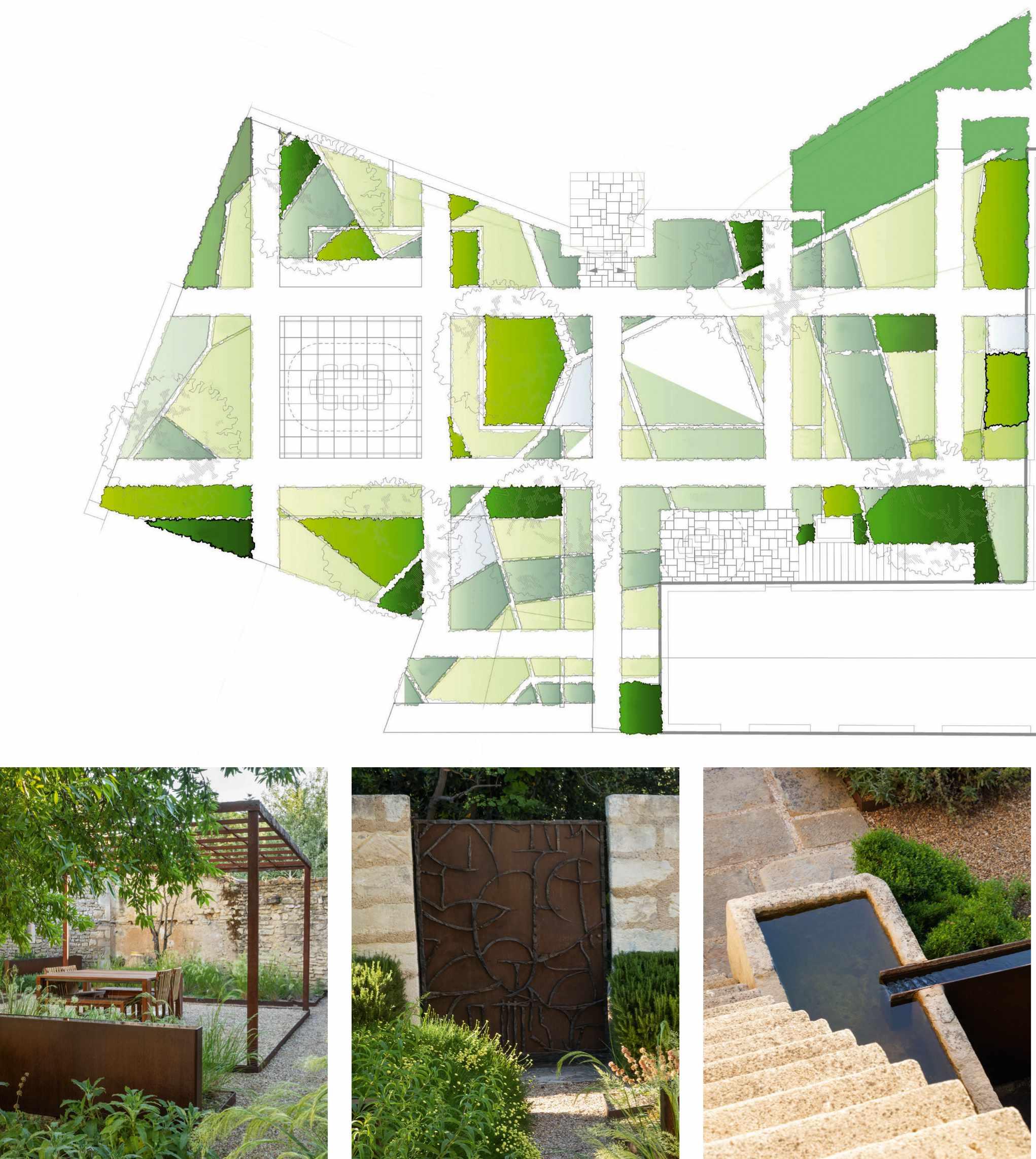
STONE TROUGH
“We wanted to make a link between the stone of the house and landscape and this canal system,” explains James. The stone trough is at the bottom of the staircase that descends from the bedroom, so that the client can get down to the garden directly in the evenings.“Stone is often used for collecting water in this area,” explains James.“Here, it’s the source for our ‘spring’. The water wells up from the bottom and overflows out into the canal system.”
1 Wide steel trough
2 Pergola covered dining area
3 Gate
4 Steel canals
Seating area
6 Stone trough
1 2 3 6 7 5 4
Steps
The ‘canal’ system
A rainwater-harvesting system collects runoff from the house, and stores it in a 20-cubic-metre tank beneath the pergola. “It actually rains a lot in Provence, for very short periods, but it still doesn’t rain enough – we have to top the water up,” says James. From there, the water circulates around the garden, trickling up from a stone trough near the steps of the house and overflowing into a sophisticated ‘canal’ system of steel troughs, reservoirs and pumps.
The system appears simple, but it was a feat of engineering. The troughs were masterminded by Alex Rocke at Harrod Horticultural. “Alex is fascinated by water engineering. The design was a real twin development.”
The system is divided into three imperceptible sections and powered by three pumps around the site. “As you walk between two tanks, the water drops down into a reservoir and comes up at the same level on the other side of the path,” explains James.
The troughs are made of mild steel. “Corten steel is a better option if you’re going to live forever, but if you’re going to live for around 100 years, thick mild steel is fine. It lasts a long time,” says James. The engineered pieces were shipped from Britain to France, so “they could be no longer or wider than the truck”. They were then craned into place on site, and the pieces welded together.
James wanted to make these ‘canals’ stand above the ground, to reflect the industrial waterways of varying heights in the local landscape, so the troughs rise to waist height (around 80cm high). They are all set on variable feet that can be adjusted, which means that the water can be made perfectly
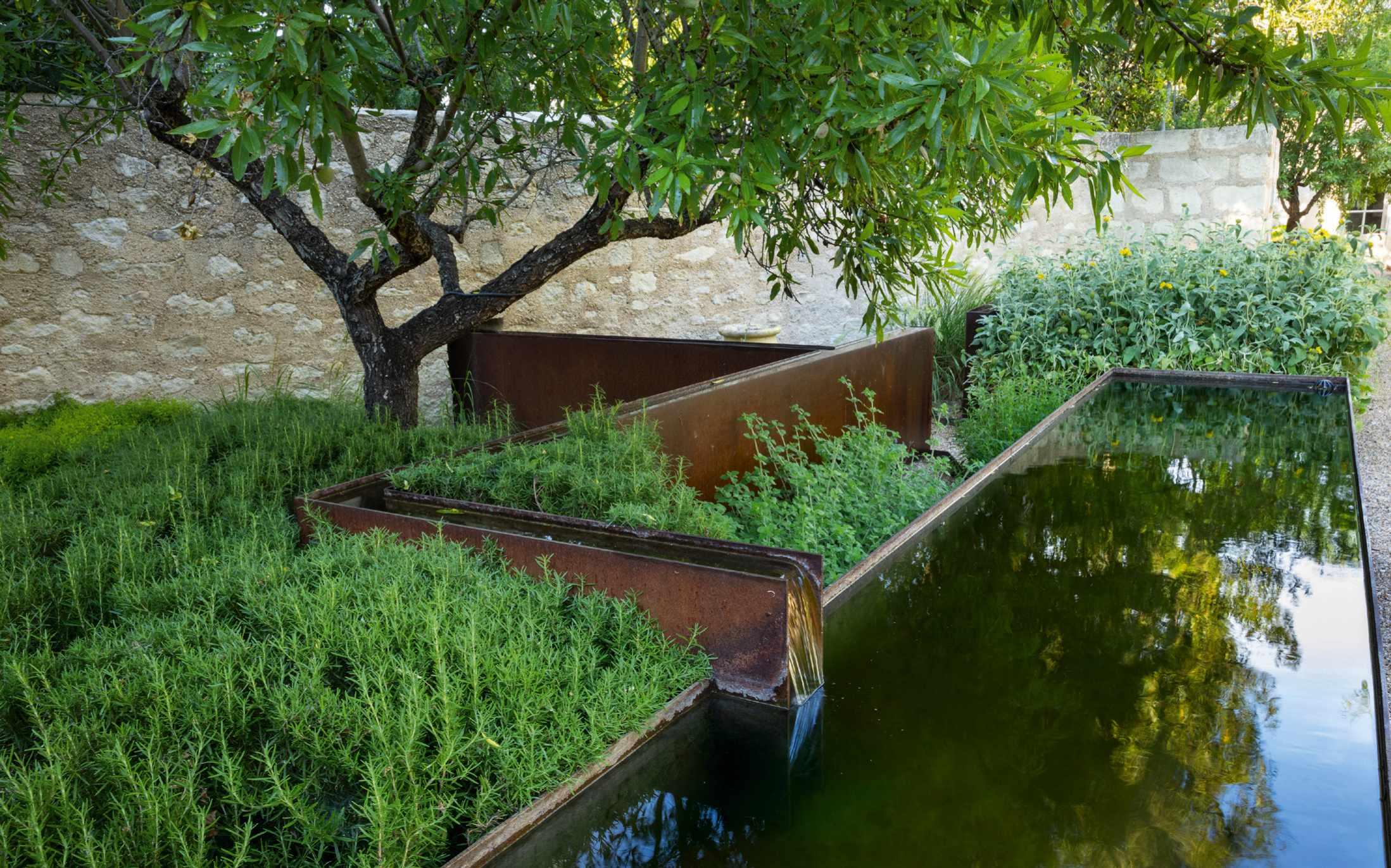
level, and looks like it is almost brimming over. “The presence of this raised water has a mass to it,” explains James. “These are not shallow rills that are running fast – they are deep troughs of water.” The water circulates gently, so creates little sound. “The water doesn’t have a cooling effect; more of a quietening effect,” says James. The water is also very reflective. “There are brilliant lines of reflection cutting through the landscape, which is really dramatic.”
James is the first to admit that the system is high maintenance. “Each downpipe in the troughs has a small, specially designed collection basket, so that leaves or other debris doesn’t block the whole system. You have to empty these little baskets almost daily, otherwise the troughs might overflow. The engineering was exquisite because we managed to get this very fine level of height of water within the tank, but it’s very inflexible. Fortunately, the client is there full time, and can clear the baskets as necessary.”
Edging and paths
Steel edging has been cut and folded to form the ‘field’ pattern. “Instead of having one edge cutting through the fields, there are two, leaving a gravelled space of 10cm in between, which suggests a pathway.”
Rolled local gravel is used everywhere in the garden, around 2-3cm deep, so it’s very firm, on a base of hard core. “It forms very tidy paths that are very easy to maintain, and allows the planting to be a bit less weighty.”
DESIGN INSIGHT
JUNE 2023 gardensillustrated.com 121

Dry planting
“New clients in Provence often want olives and lavenders, the ubiquitous plants of the Mediterranean,” says James. Here, however, he has used almond trees. “They are potentially less traditional but we found brilliant old trees that had lots of character and looked like they’d been there before we started. They also brought bright green into this minimal garden – olives would have looked too hard against the steel.”
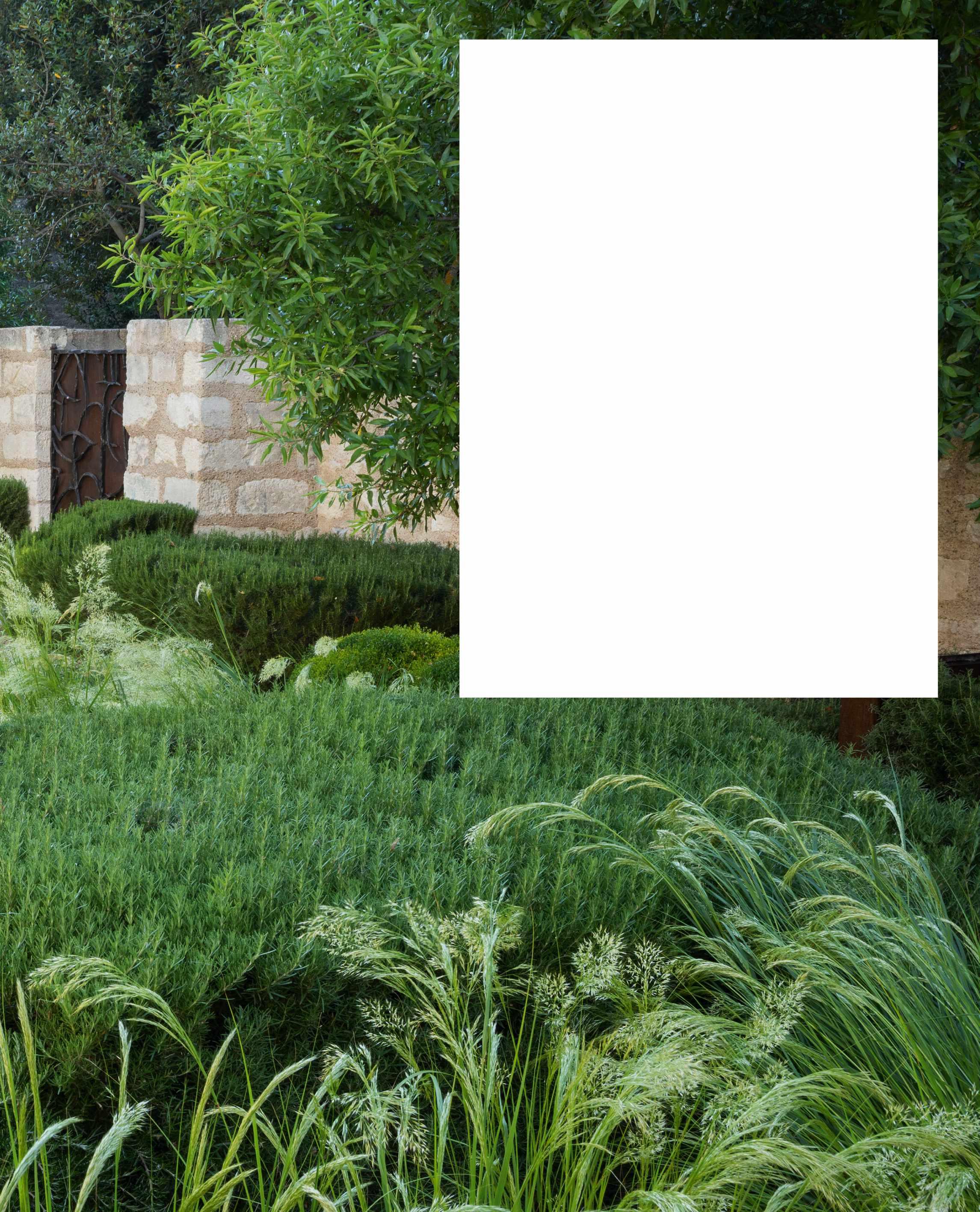
Rosemary is a key plant in this garden, anchoring the planting and giving year-round structure. It can be pruned into tidy blocks, which the client wanted. They contrast with another key plant, Stipa calamagrostis, which echoes the surrounding wheat fields. Culinary herbs such as sage, thyme, oregano and lemon verbena are planted in their own blocks so that their texture or unique qualities can be enjoyed. “In some places, the same creeping thyme is on either side of the path, but sometimes the planting ‘jumps’ from one block to another. Some plants cross between many of the ‘fields’ and some plants are just in individual blocks.
“The garden was previously a rubble-filled courtyard and the soil was dreadful – which is exactly what we wanted. We decompacted the soil, broke up the rubble and rotavated it in. The soil here is clay, so what the plants need most is air.” Surprisingly, the water table of the garden is high, thanks to the local technique of flooding the fields from the canals. “All of the beds are slightly raised, 5cm off the ground, so that the plants never sit in water.” The plants are also mulched with 10cm of gravel to prevent them seeding around, and are never irrigated. ■
JUNE 2023 gardensillustrated.com 123 DESIGN INSIGHT
Find out more about James’s work at scapedesign.com
Garden studios
Find your perfect work space with our selection of garden studios


COMPILED BY MOLLY BLAIR
SUSTAINABLE SPRUCE
Dominator Insulated Garden Office, From £8,909.99, Dunster House, 01234 817897, dunsterhouse.co.uk




NATURAL SPACE
Modular Studio, From £22,620, Eco Space Studios, 020 7703 4004, ecospacestudios.com

BESPOKE BUILD
Optima Specification, From £22,000, Garden Spaces, 0845 387 9387, gardenspaces.co.uk
SHEPHERD’S HUT
The Cabin, From £32,000, Plankbridge, 01300 348414, plankbridge.com
TAILOR MADE
The Garden Studio, From £20,000, Garden Studios, 01296 320333, gardenstudio.co.uk
PITCHED ROOF
The Burnham Studio, From £16,850, Crane Garden Buildings, 01760 444229, cranegardenbuildings.co.uk
Discover a wider range of studios by scanning this QR code with your phone camera, or visit gardensillustrated. com/gardenstudio

MODERN
Hampton Grey Studio, From £7,995, Sanctum Garden Studios, 01257 279161, sanctumgardenstudios.com
CHALET STYLE
Garden Studio with Apex Roof, From £5,015, Malvern Garden Buildings, 01932 783999, malverngardenbuildings.co.uk

CLASSIC
Traditional Garden Room, From £10,250, Warwick Garden Buildings, 01926 815757, warwickbuildings.co.uk
124
124 gardensillustrated.com JUNE 2023 DESIGN SOURCEBOOK
The tap that does it all
100°C BOILING, CHILLED AND SPARKLING WATER
With a Quooker in your kitchen you always have 100°C boiling water alongside regular hot and cold. Add a Cube and you will also have chilled, filtered sparkling water – all from the same tap. Interested? Book a virtual experience with a Quooker expert. You control the appointment and what you see. For further details and to book your appointment, scan the QR code or visit quooker.co.uk

Rewards PROGRAMME
It’s a summer of savings with the Gardens Illustrated Reader Rewards scheme, with more discounts to discover online
FREE WINE
HOW IT WORKS
1Browse
Take a look at some of our latest fantastic offers, covering gardening, lifestyle, travel, food and drink, and more.
2 Redeem
Follow the link provided in each offer and apply the offer code when placing your order.
3 Find even more Go to gardensillustrated.com/offers to find the full range of discounts, deals and competitions available to you.
SAVE 5% THIS SUMMER ON ALL SAGA RIVER CRUISES

Step aboard Saga’s exclusive ships this summer and discover the best of Europe. During the day, set off to explore cities, wine towns and ancient sites, then return to your ship for delicious dining and evening entertainment as you sail on to the next destination. Designed exclusively with Saga customers in mind, these cruises allow you to explore Europe’s variety of celebrated rivers aboard luxurious cruise ships, all with spacious cabins and high levels of service.
To book call 0800 300 400 quoting GDNIL or visit saga.co.uk/ gardens-2023
ENJOYA FREE CASE OFWINE
We’d like to introduce you to your new favourite wine club! Wine52 showcases the very best independent winemakers on the planet. Each month it visits an exciting new region and brings back a selection of exceptional and unique wines for members. Join and experience a whole new world of wine, and you’ll also get a free case of three wines – just cover postage costs of £8.95. You’ll also receive Wine52’s in-house magazine Glugand two tasty snacks.

To claim your case, visit www.wine52.com/WGDL23 and choose whether you want all white, all red or a mixture.
To browse our full selection of offers, go to gardensillustrated.com/offers
SAVE 5% 126 gardensillustrated.com JUNE 2023
SAVE 20%
COURSES TO HELP YOUR SKILLS BLOOM WITH CREATE ACADEMY
Learn new gardening and floristry skills this summer with Create Academy’s immersive online video courses. Discover how to grow year-round beautiful cut flowers with The Land Gardeners, learn how to dry and arrange everlasting flowers with floral artist Bex Partridge, take your floristry to the next level with leading florist Willow Crossley, or redesign your garden with Dan Pearson, plus so much more. So whether you’re considering retraining or seeking inspiration, Create Academy has a greenfingered course for you.

Claim your discount using code GARDENS20 when booking your course at createacademy.com.
SAVE 10% WITH HURTIGRUTEN EXPEDITION CRUISES

Hurtigruten Expeditions are the world’s largest and leading expedition cruise line with a focus on exploration,adventure,and science.Whether you’re setting foot on awe-inspiringAntarctica or spotting unique wildlife on the Galápagos Islands,you’re going to leave with enough memories to last a lifetime.Only the most authentic experiences await our travellers,so that your only dilemma is deciding which expedition to take first!
Use code HRG-GIL at hurtigruten.co.uk for your 10% discount or call 020 3553 1644.
ENJOYAYEAR-LONG 15% DISCOUNT WITH SARAH RAVEN
Sarah Raven offers a comprehensive range of seeds, bulbs and plants, most of which are tested by Sarah herself in her East Sussex garden.You’ll also find lots of gardening equipment, including tools and pots, plus a delightful range of gifts and homeware.You can get 15% off everything on Sarah Raven’s website for the whole of 2023, helping you to get your garden blooming beautifully all year round.

Use code GIL23YR at sarahraven.com to claim your 15% online discount.
To browse our full selection of offers, go to gardensillustrated.com/offers
SAVE
SAVE 10%
15%
Willow Crossley The Land Gardeners
Bex Partridge
JUNE 2023 gardensillustrated.com 127
Dan Pearson
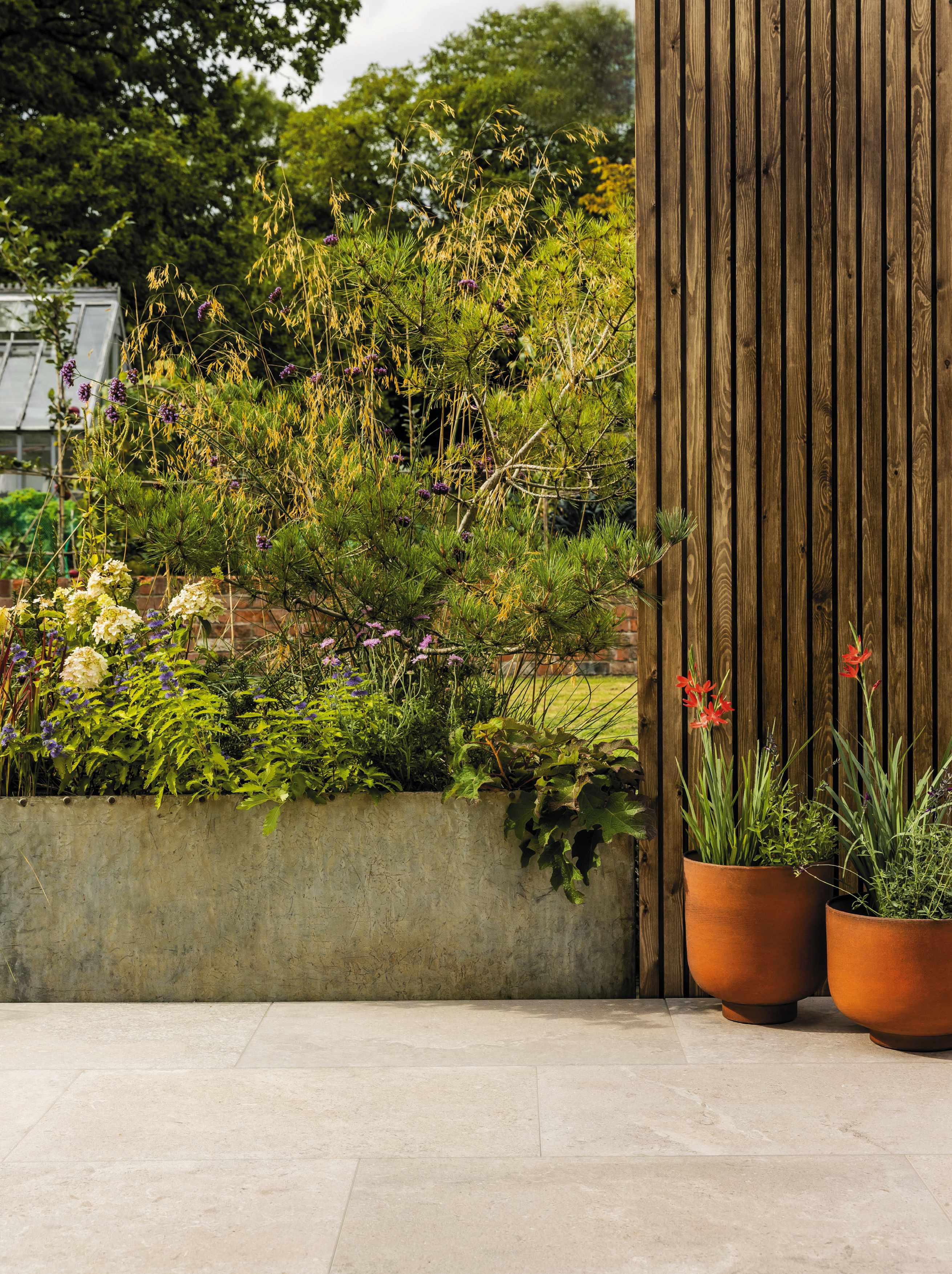
DOWNTOOLS
Book reviews, the crossword, competition and Alice Vincent
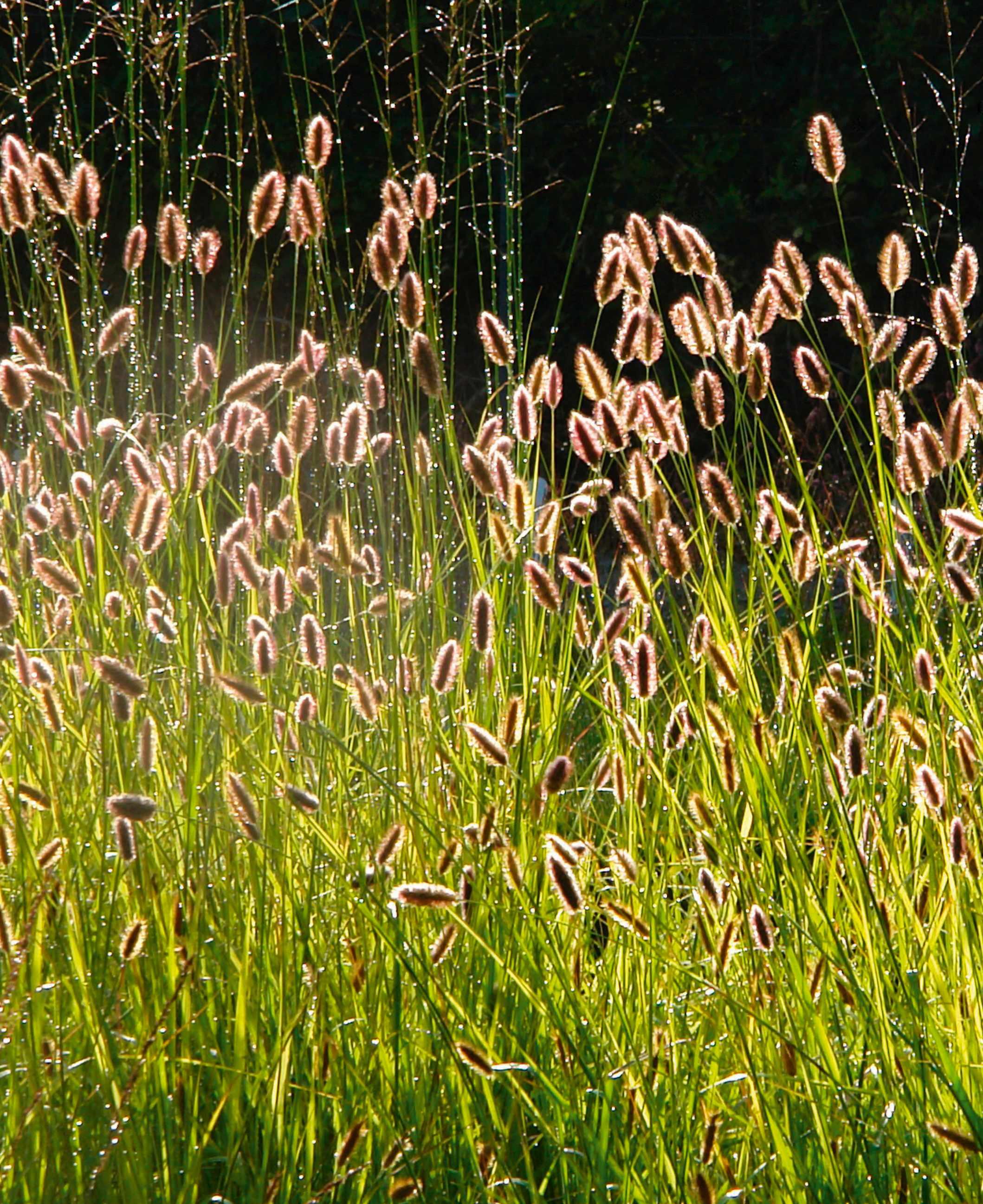
JUNE 2023 gardensillustrated.com 129
Highly regarded expert Neil Lucas offers ideas, inspiration and advice in his latest book Grasses for Gardens and Landscapes, reviewed on page 130.
NEIL LUCAS
GARDEN STYLE: A BOOK OF IDEAS by Heidi Howcroft and Marianne Majerus

Mitchell Beazley, £40 ISBN 978-1784727826
beautifully curated sourcebook of garden styles, with stunning images of gardens around the world from an internationally acclaimed photographer. Reviewer Natalie Ashbee is a garden consultant and garden writer.
Some may argue that garden styles have barely changed in 1,000 years, with trends simply coming and going along the way, but when you have the gallery of a renowned garden photographer to view, you know you will see something different.
This book is published as a companion to Garden Design: A Book of Ideas by the same authors, but stands solidly on its own feet. Majerus’s photographs draw you in with a rich sense of time and place, and Howcroft elaborates on each with the precision you’d expect from a well-honed landscape architect, giving planting detail and design breakdown in crisp, clear fashion. Case studies illustrate each style, and there are additional chapters on colour, styling and lighting.
In the introduction, Howcraft provides loose style guidelines and advises readers to be realistic but open to a merging of styles to suit your needs. I love her idea of putting a photo of your household on a mood board of chosen images to see if you ‘fit’ the picture.
The genius of this book is that the photos lead the way, with much of the text taking the form of expanded captions to explain their context. The photos tell the story in a very user-friendly fashion, and there is a worldwide feel to the book, which offers up some real delights, including Majerus’s own garden in Luxembourg. There are some stunning British gardens, too, such as Jane Brockbank’s design for a tricky, L-shaped garden that manages to squeeze in a pool and a garden room among the shade-loving planting.
Whether purchased as an indulgent coffee-table book or an inspirational sourcebook, Garden Style could be equally useful to designers, landscapers and architects as a mood board to illustrate styles and help clients visualise their thoughts. I recommend reading this book several times: once for the pure indulgence of the glorious photography, again to absorb the description of each style, and yet again to enjoy the inspirational ideas.
For those unfamiliar with ornamental grasses as garden plants, prepare to be inspired. For those already well used to seeing and hearing about grasses and the so-called New Wave planting style, prepare to be re-inspired and a little more educated. For this book is a great study, as the author states, of ‘arguably the most successful group of plants on the planet’.
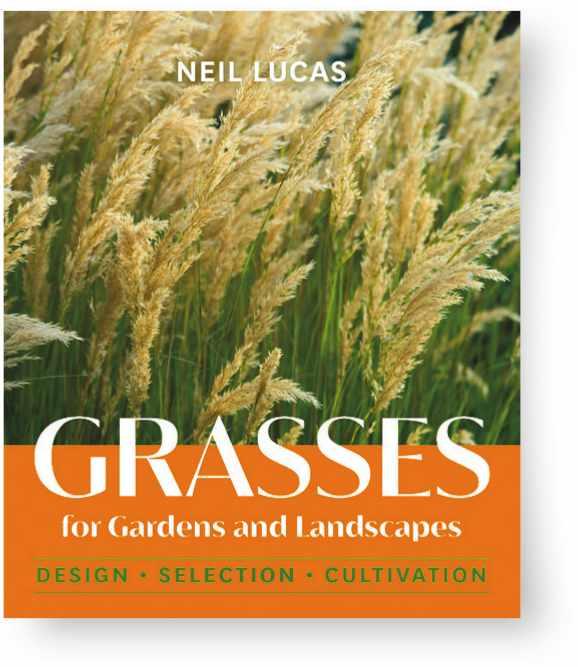
Neil Lucas is a tremendously well-respected authority on growing and designing with grasses – he is the UK’s leading expert on them and runs the renowned garden and nursery, Knoll Gardens, in Dorset.
In this book, he makes the subject accessible for amateur gardeners, with chapters on how to create rhythm and designing for seasonality, alongside helpful, concise and practical guidance. Within the same pages, however, Lucas also manages to provide useful and eye-opening information for the professional gardener or designer.
His descriptions of the garden areas at Knoll, along
GRASSES FOR GARDENS AND LANDSCAPES: DESIGN, SELECTION, CULTIVATION
by Neil Lucas
Timber Press, £40
ISBN 978-1643261157
with species lists, are wonderful starting points for those faced with particular growing conditions in their own gardens. There is also an informative chapter on choosing the right grasses for a wide variety of situations. Lucas’s passion for sustainable gardening is clear – by studying natural plant communities and really understanding the conditions in which particular groups of grasses do well, we can create more resilient, durable and biodiverse gardens. As Lucas says, these ‘can serve as a substitute [for native ecosystems], providing a place for the other species on which we ourselves depend’. There’s a vast amount of practical advice, from caring for grasses to where to see and buy them in Canada, the USA, the UK and Europe. The A-Z directory makes this book an invaluable source of reference for the best grasses and grass-like plants available today. One to be enjoyed and consulted again and again.
DOWNTOOLS BOOK REVIEWS
Insightful, practical advice based on the author’s extensive experience and passion for biodiversity and natural ecosystems.
Reviewer Joe Perkins is a garden and landscape designer.
130 gardensillustrated.com JUNE 2023
A
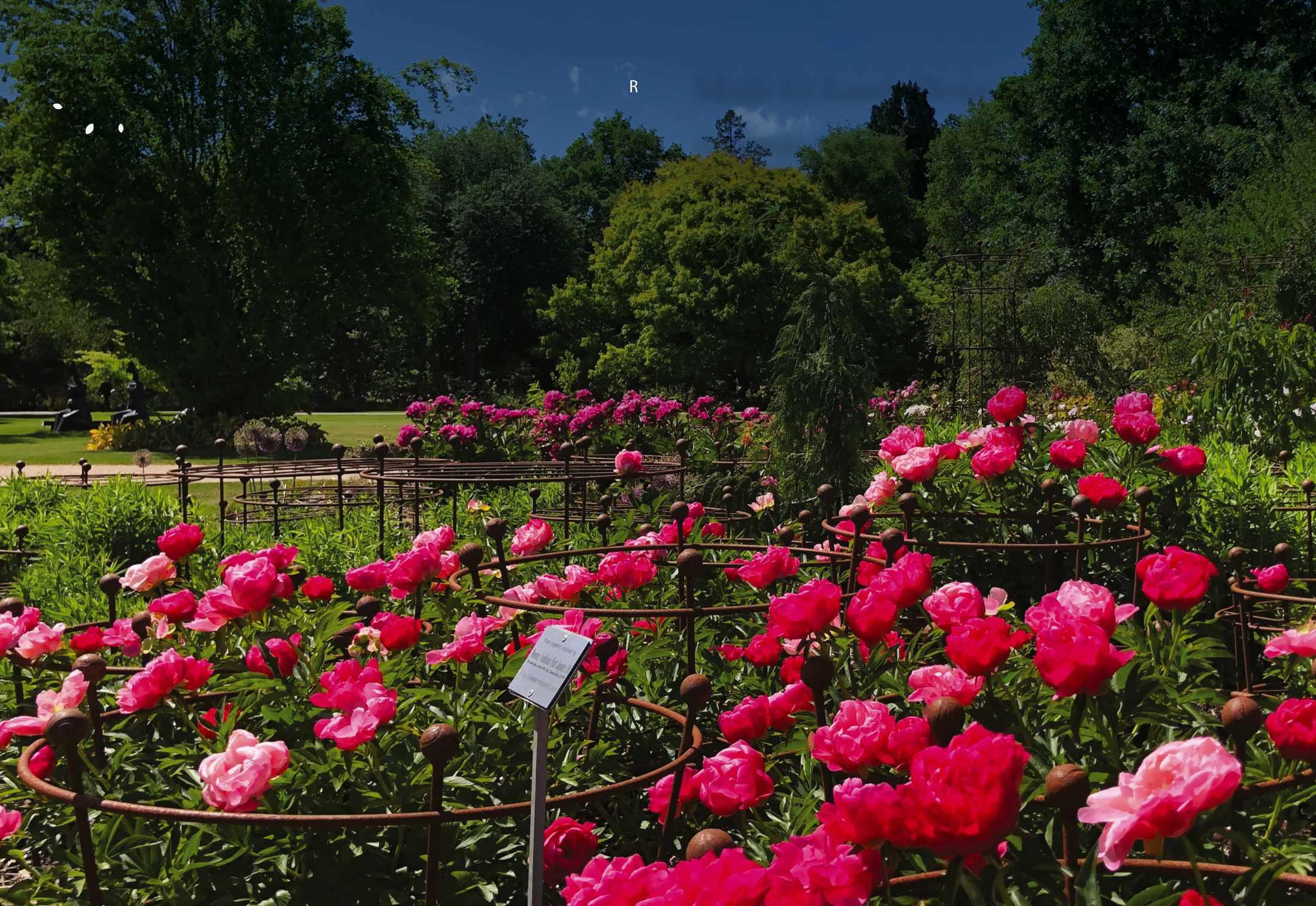

Made by hand. Designed to last a lifetime. For catalogue requests and enquiries: 01285 706511 View our range and purchase online: muntons.net Cultivation Digging Available from Joules, Marshalls, Waitrose and leading retailers. Tel: 01279 401570 • info@pedigreegarden.co.uk • www.pedigreegarden.co.uk The New
of British Bulldog Tools
over 240 years of Heritage, Craftsmanship & Manufacturing bloodlines. Transformation Our New Garden Tool Collection Beautifully packaged garden tools featuring designs from the V&A collection n
Generation
bred from
ONE YEAR GOOD GARDENING DIPLOMA
September 2023 – beg July 2024 BOOKING NOW
Covers the best in planting design while training in the more serious aspects of horticultural techniques. Practical sessions held at Arundel Castle under the guidance of head gardener Martin Duncan and at Sandhill Farm House, Rogate. Lectures by many leading gardening personalities and regular visits to outstanding private gardens. Students also learn to draw up planting plans.
(1 day a week (Tues), 10.30am–3.15pm, over three terms)
THE ESSENTIAL GARDEN DESIGN DIPLOMA

January – March 2024 BOOKING NOW
Based at the Chelsea Physic Garden and led by Rosemary Alexander and architect Catriona Rowbotham, the course is an overview of Garden Design, covering all the elements needed to rethink an average garden.Taking students step by step through site surveying, using the grid, horizontal and vertical features, garden layouts and planting plans, costing and specification, plus drawing tuition and homework on design and plant portfolios.Tutors are well respected in the industry and will guide students on how to succeed in this diverse profession.
(2 days a week (Wed &Thu), 10.30am–3.15pm, plus 2 days homework)

GARDENING FOR BEGINNERS
April 2024
One of our most popular courses, led by master horticulturist Ben Pope, which aims to take each student through all the practical elements of caring for a garden from soil, tools, maintenance, seed sowing and propagating, weed control and pests and diseases.The first 3 days will be spent with lectures at the Chelsea Physic Garden and the final day will be spent gaining practical experience in Rosemary Alexander’s much praised garden near Petersfield and another private garden nearby, where Ben is in charge. Participants will be given a chance to prune, plant, sow seeds and regular maintenance tasks will be discussed. A light lunch and refreshments will be provided daily.
GARDEN DESIGN & CARING FOR YOUR GARDEN
Distance Learning Courses study anytime, anywhere in the world
A stepping stone to a new career.These two correspondence courses are a step by step guide to either designing your own garden or learning how to plant and maintain an existing garden: drawing up plans, hard landscaping, site analysis, planting, month by month tasks etc.Taught through a comprehensive course book, with projects submitted to us. (1-3 years to complete and individual assessment)
Not sure which Diploma course is for you?
We prefer potential students to attend an Information Session when Rosemary explains the whole course content and you can see our facilities at the historic Chelsea Physic Garden. JUST CONTACT US TO SET UP A DATE/TIME www.englishgardeningschool.co.uk
Email: info@englishgardeningschool.co.uk

Tel: 01730 818373
Long established as the leader in all design and gardening tuition and based at the unique and historic Chelsea Physic Garden
Our instant hedging is grown, irrigated, fed and trimmed by experts at every stage, to give you a perfect hedge every time.

 Garden of Medicinal Plants – Chelsea Physic Garden Photo: R Alexander
Garden of Medicinal Plants – Chelsea Physic Garden Photo: R Alexander
01386 750585 sales@readyhedge.com matthew@readyhedge.com www.readyhedge.com
Know-how. ® Variety
Taxus baccata (English Yew)
shown:
THE 30-MINUTE GARDENER: CULTIVATE BEAUTY AND JOY BY GARDENING EVERY DAY
 by Greg Loades
by Greg Loades
Timber Press, £25
ISBN 978-1643261331
Reviewer
Some habits are worth acquiring and, when it comes to the benefits of developing a gardening routine, few of us are likely to demur. But while Greg Loades isn’t the first to recommend a daily foray into the garden, the suggestion is broached here via mindful moments that stretch into minutes and then, it is hoped, into hours. With uncompromising honesty, Loades sets the timer at half an hour from the off, with nary a concession to the ‘time-poor’ gardener. Thirty minutes is a big chunk from anyone’s day, but there for the taking when recovered from goggling at box-sets or social media and even, Loades argues, workable around his own share of family caring responsibilities. A commitment, then; the reward being immersion in ‘a parallel universe that is bursting with life, to delight in the process of natural growth, and to embrace nature’s pace’.
Aware that not all readers will have shared his own childhood affinity for growing,
Loades encourages us in stages to spend more time outside; from being in the garden, through belonging and believing in its innate desire to grow, before we celebrate becoming a 30-minute-a-day gardener. If there’s infectious enthusiasm for keen observation, record keeping and developing a creative practice (the presence of Julia Cameron’s The Artist’s Way in the recommended reading section comes as no surprise), it’s balanced by advocacy for a concept Loades refers to as ‘facing north’ – a continual process of recentring ourselves in the garden, and finding joy and peace in that space.
Seasonal chapters offer timely recommendations for projects and plantings, the author’s conversational prose complemented throughout by Neil Hepworth’s evocative photography. This is thoughtful instruction that will earn its space on the bookshelves of newbie gardeners, or those of older hands looking for new ways to offer encouragement.
I have a lot of shelf space dedicated to books that major on delicious perennial edibles, so a new book is going to have to work hard to find a place among my hard-earned volumes. Cold-Hardy Fruits and Nuts does exactly that.
The book’s proposition is simple – to present 50 easy-togrow fruits and nuts suitable for the home garden or at the landscape scale – and it delivers with a thoroughness that makes it a tempting resource. For each entry, expect a description, pollination requirements, optimum site specifics, cultivars, how to propagate it, how to use it to best effect in the kitchen, and much more besides. The writing is lively and engaging –there’s a historic, cultural and anecdotal intro to each that complements the technical and horticultural information. The images are numerous, clear and well placed, and as engaging as they are instructive.
The choice of species is particularly enjoyable, and it is a delight to see a handful of surprises – such as Himalayan
COLD-HARDY FRUITS AND NUTS: 50 EASY-TO-GROW PLANTS FOR THE ORGANIC HOME GARDEN OR LANDSCAPE
 by Allyson Levy and Scott Serrano
by Allyson Levy and Scott Serrano
Chelsea Green Publishing, £30
ISBN 978-1645020455
chocolate berry, Korean stone pine and spikenard – in the mix. There is a good scattering of the familiar – from pears to pecans, blackcurrants to boysenberries – along with many – such as schisandra, seaberries, honeyberries and huckleberries – that might be familiar to forest gardeners. The majority of species are naturally resilient, making this an excellent choice for those new to gardening and/or looking to grow using organic principles.
The authors come from a fascinating perspective: as veteran growers and founders of Hortus Arboretum and Botanical Gardens in upstate New York, they have developed a wealth of experience and knowledge, shared in the book.
For a book that might influence how you garden and care for what you grow, it is well worth the price tag. If you are an edible gardener interested in widening the scope of what you grow, or a designer looking to explore where edible perennials meet the ornamental, this book will serve you very well indeed.
DOWNTOOLS BOOK REVIEWS
A well-curated guide to 50 easy-to-grow fruits and nuts that tells you just about all you need to know to succeed in growing them.
Reviewer Mark Diacono is a food and garden writer.
An attractive and well-constructed argument for locating meaning and fulfilment in the garden through the cultivation of daily practice.
JUNE 2023 gardensillustrated.com 133 I
Andrew Timothy O’Brien is a writer and online garden coach.
THE GROVE: A NATURE ODYSSEY IN 19½ FRONT GARDENS
 by Ben Dark
by Ben Dark
Mitchell Beazley, £9.99
ISBN 978-1784727413
A confident and elegantly written account of the fascinating narratives and histories entangled within the garden plants of a residential London street. Reviewer Matt Collins is head gardener at the Garden Museum.
‘One autumn afternoon, the hedge outside No 67 Norroy Road changed my life’, opens Ben Dark’s captivating debut. ‘Those Euonymus came from nowhere.’ It is the perfect place to begin a book that deals in both the commonplace and the wonder of garden plants: that moment every new gardener experiences, when a street plant is recognised for the first time and its name uttered in an exciting new language. A hedge will never again be just a hedge.
Grove Park, an unassuming residential road in south London is the subject matter of this engrossing book, now published in paperback. Taking 19 of its front-garden plants as chapter headings – plants that could be ‘found on any road in any town’ – Dark (seasoned gardener, landscape historian and host of the much-loved podcast The Garden Log) whisks us from the ordinary to the extraordinary, revealing the remarkable natural and social histories behind their ubiquitous blooms. You’ll have read books like this before –musings on plants woven from
encounters in and around gardens – but I doubt many from recent decades. As reflected in the work of the writers he quotes, including Vita Sackville-West and Christopher Lloyd, Dark’s prose is in the tradition of classic garden writing: humorous, relatable, poetic and insightful. It boasts all the inventive description and sure-footed liveliness of Victorian naturalist William Robinson.
As such, The Grove is a refreshing read among modern narrative gardening books: it roams free of the typical season-by-season structure or the embroidered memoir style (anecdotal interjections – as a head gardener, a Londoner, a young father – are concise and smart, and shy away from self-indulgence). You’ll learn how the buddleja gained its tenacity and the box its destructive moth; of the burrowing behaviour of bulbs; how Verbena bonariensis marries design with disarray; and how a suburban front garden can be anything but pedestrian.
Other books
Among other new releases this month you’ll find all you ever wanted to know about tulips, hen-keeping and growing your own.
A GARDENER’S GUIDE TO TULIPS by Matthew Smith and Grete Smith

Crowood Press, £16.99
ISBN 978-0719842030
A practical guide to growing tulips, including a wealth of information on current and past selections, planting situations and gardens where tulips have been used to great effect.
THE EDUCATION OF A GARDENER by Russell Page

Vintage Classics, £14.99
ISBN 978-1784877743
This classic memoir by the legendary gardener and landscaper, Russell Page, was first published in 1962. It now has a new introduction by Alan Titchmarsh.
CHICKEN BOY: MY LIFE WITH HENS by Arthur Parkinson

Particular Books, £22
ISBN 978-0241573655
Hen-keeping tips and introductions to common, rare and pure-breed hens, illustrated with the author’s watercolours and photographs.
GROW COOK INSPIRE by Helen Cross Grow, Cook, Inspire, £20

ISBN 978-1399950800
Aimed at teachers, parents, children and carers, this illustrated guide on growing and cooking seasonally is inspired by the author’s own experience.
GROWING AT GREENFIELDS by Diana Yates

Pavilion Books, £25
ISBN 978-1911682509
Diana Yates of BBC Beechgrove takes us through a year in the life of her garden, Greenfields, in the Scottish Borders as she plants, nurtures and harvests.
DOWNTOOLS BOOK REVIEWS 134 gardensillustrated.com JUNE 2023
For tickets: www.ashridgehouse.org.uk



Privacy in gardens can be created using trees to hide or screen out an undesirable view. Trees grown for this purpose often have a clear stem up to fence panel height around 1.8-2m with a full bushy canopy above, forming a good screen above the fence line. This type of screening is particularly useful if the garden is overlooked by neighbouring properties or to retain lower-level exposure to an attractive wall or area.
Semi-mature trees can be planted to achieve effective screening from the offset with evergreens being preferred for this purpose as they screen throughout the year. However, a planting scheme that includes deciduous trees can provide rich contrast and seasonal interest.
Screening trees
Practicality Brown can supply a range of top quality trees for screening, which are particularly useful for creating privacy. This is our selection of the best screening trees, and all are in stock at our nursery in Iver, Bucks:
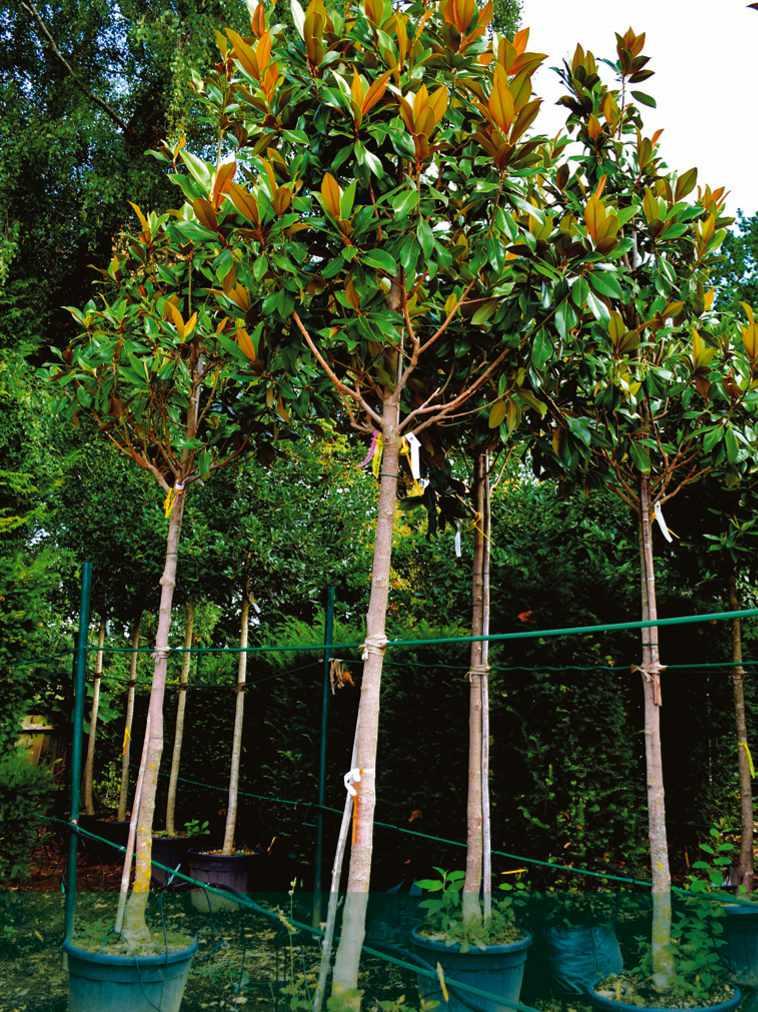
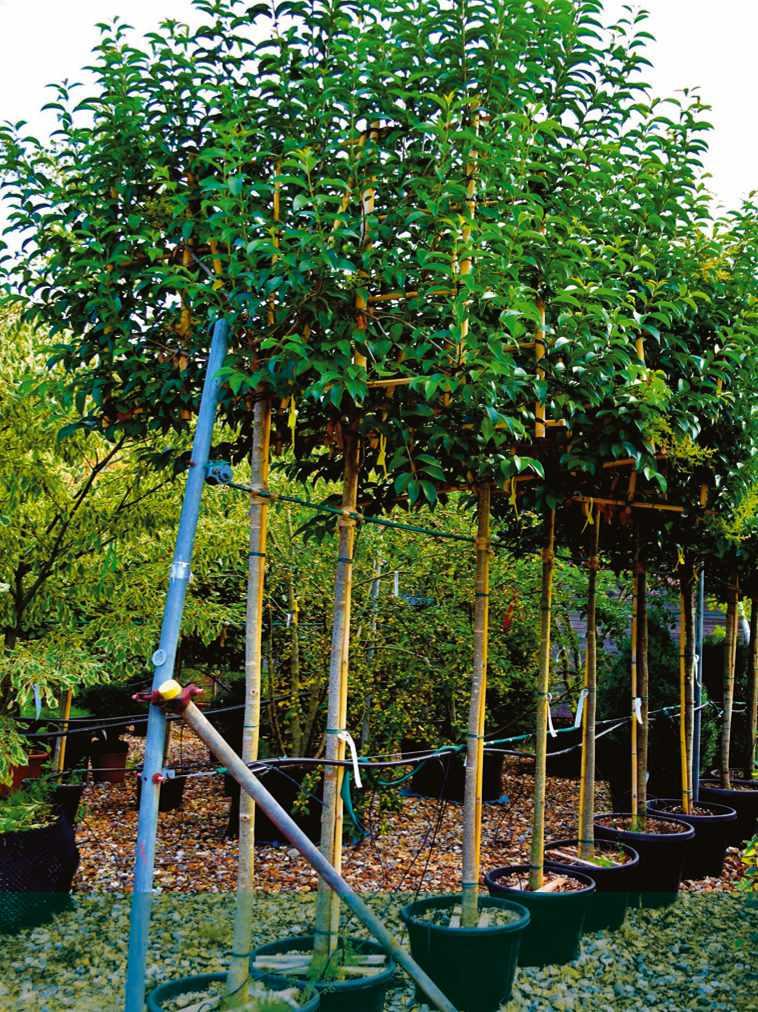


• Eriobotrya japonica
• Ilex aquifolium Nellie R Stevens
• Ilex castaneifolia
• Ligustrum japonicum
• Magnolia grandiflora
• Osmanthus aquifolium
• Photinia fraseri ‘Red Robin’
• Pinus nigra

• Prunus laurocerasus ‘Novita’
• Viburnum lucidum
Pleached trees
We also have a range of pleached trees which can be used in the same way; pleached trees can be effective for formal screening and where space is limited.
These are our best trees that are in stock:
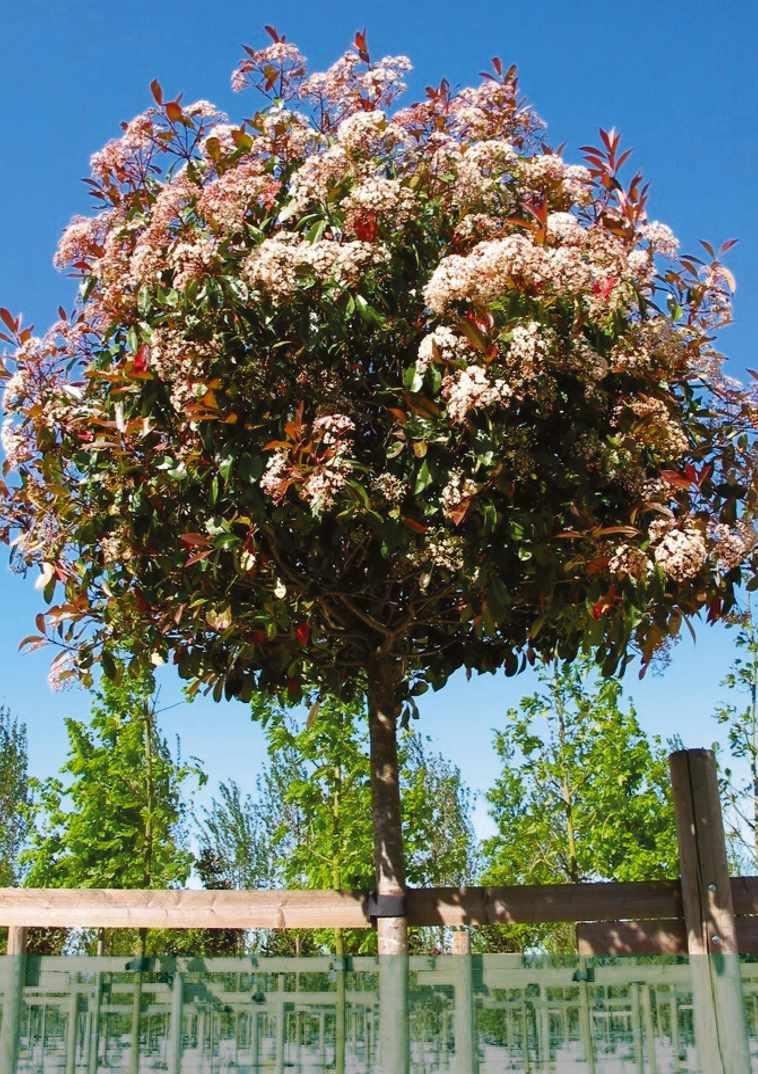
• Ilex aquifolium Nellie R Stevens
• Ligustrum japonicum
• Magnolia grandiflora
• Photinia fraseri ‘Red Robin’
• Prunus laurocerasus ‘Novita’
tree & edge ursery
As well as the screening trees, Practicality Brown grows a range of premium quality Practical Instant Hedge™ at the nursery in Iver. You are welcome to visit to view both trees and hedges.
Conac us for deails email rees@pracbrown.co.uk or call 01753 652022 for more informaion

 Ilex Nellie R Stevens
Ligustrum japonicum (pleached)
Magnolia grandiflora
Ilex Nellie R Stevens
Ligustrum japonicum (pleached)
Magnolia grandiflora
Ct PvC t SC tS
Photinia Red Robin
www.pracbrown.co.uk
Summer gardens to visit
Summer is a great time to visit this collection of glorious gardens

1COTTESBROOKE HALL & GARDENS
Come admire the profusion of roses trained in spirals and organic shapes on walls and in borders providing colour, beauty and intoxicating scent. Wander through our garden rooms, each with its own distinct style and colourful border displays of irises, lupins and delphiniums.
Northampton NN6 8PF | 01604 505808 | cottesbrooke.co.uk

2
WATERPERRY GARDENS
A place to explore, relax and shop in beautiful surroundings. The gardens are ablaze with colour over the long summer days. Heading the way are lupins and roses followed by delphiniums. Don’t miss the Rare Plant Fair on the 11 June. Open 10am to 5.30pm.

Nr Wheatley, Oxfordshire OX33 1LA | 01844 339226 | waterperrygardens.co.uk
3
DYFFRYN GARDENS, NATIONAL TRUST
4
5
4HEVER CASTLE & GARDENS
Experience Hever Castle at the height of its summer beauty, with one of the finest displays of roses and summer blooms in Kent. Hever in Bloom (19– 22 June) showcases the glorious gardens with floral displays in the Castle and free garden tours included with admission.
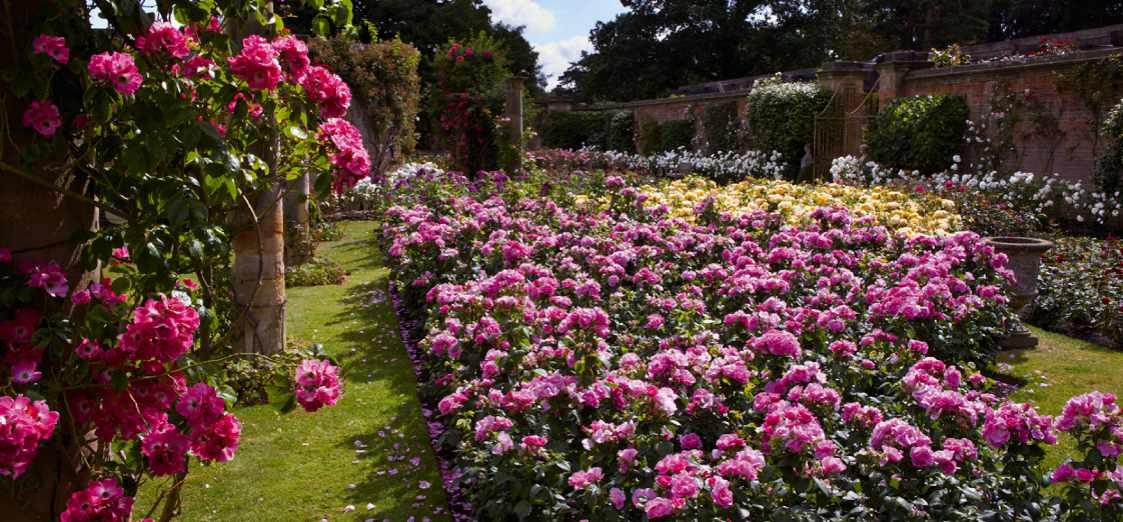
Hever, Edenbridge, Kent TN8 7NG | 01732 865224 | hevercastle.co.uk
On the outskirts of Cardiff, Dyffryn Gardens offers up surprises and secrets with year-round seasonal highlights. The 55 acre, Grade-I listed Edwardian gardens include grand vistas, a rambling Arboretum, themed Garden Rooms, Kitchen Gardens, exotic Glass House, café, shop and Log Stack play areas.

St Nicholas,Vale of Glamorgan CF5 6FZ | nationaltrust.org.uk/dyffryn-gardens
5
GREAT DIXTER HOUSE AND GARDENS
Great Dixter is a vibrant, daring and immersive garden. A place of constant experimentation, observation and education. We lead the way in ornamental gardening with a touch of the wild, bringing the countryside in and enriching biodiversity.
Northiam, East Sussex TN31 6PH | 01797 252878 | greatdixter.co.uk

ADVERTISEMENT FEATURE
1
2
3
Crossword
PRINT VERSION
You can buy printed issues of the magazine published up to six issues ago at buysubscriptions.com or see below for details.
DIGITAL VERSION
Save money when you subscribe to the digital edition –see page 22
CLOTHBOUND SLIPCASES
Cost from £9.99 each (inc p&p). Subscriber discounts available – see below for details.
TO ORDER PRINTED COPIES OR SLIPCASES
GARDENS ILLUSTRATED PRINTED ISSUES ORDER


FORM
Complete this form and send to: Gardens Illustrated, Back Issues, PO Box 3320, 3 Queensbridge, Northampton NN4 7BF (You may photocopy this form).
SINGLE ISSUES
I would like to order copy/copies of issue(s)
SUBSCRIBERS NON-SUBSCRIBERS
■ UK – £5.29 per copy
■ EU – £5.99 per copy
■ UK – £6.49 per copy
■ EU – £7.49 per copy
■ Rest of world – £6.99 per copy ■ Rest of world – £8.49 per copy
CLOTHBOUND SLIPCASES
I would like to order slipcase(s)
SUBSCRIBERS NON-SUBSCRIBERS
■ UK – £8.49 each
■ EU – £9.45 each
■ Rest of world – £10.80 each
■ UK – £9.99 each
■ EU – £10.50 each
■ Rest of world – £12 each Postage & packaging is included in all prices.
PAYMENT DETAILS
■ I enclose a cheque/international money order made payable to Our Media Ltd for £
■ I would like to pay by credit/debit card, please debit my card
Visa ■ Mastercard ■
■ ■ ■ ■ ■ ■ ■ ■ ■ ■ ■ ■ ■ ■ ■ ■
Expiry date ■ ■ ■ ■ Issue no. (if shown) ■ ■
Signature Date / /
YOUR DETAILS
Title Forename Surname Address Post/Zip code Daytime tel no.
Email address Subscriber number (if applicable)
Gardens Illustrated (published by Our Media Limited) would like to send you updates, special offers and promotions by email. You can unsubscribe at any time.


Please tick here if you would like to receive these ■
We would also like to keep in touch by post and telephone about other relevant offers and promotions from our publisher Our Media Limited. If you’d rather not be contacted this way please tick here post ■ phone ■ . For more information about how to change the way we contact you, and how we hold your personal information, please see our privacy policy, which can be viewed online at policies.immediate.co.uk/privacy
ACROSS
1 Underground runner forming new plants at the tip – lots on developing (6)
5 National Trust for Scotland’s Highlands botanical garden – were vine to be transformed (8)
9 Have a longing for English … red-skinned maincrop potato (7)
10 Carrot cultivar with blunt-ended roots, named after a city of western France (6)
11/7 Annual growth markers observable in cross-sections of timber (4,5)
12 Areas between base of leaf stalks and stems … spoilt salix (5)
13 Genus of broad-leaved bamboo –in mimosas, actually (4)
14 A common name for Monarda plant – honey producer’s salve? (3,4)
16 An F1 sweet, tender baby beetroot – film director’s order? (6)
18 Intertwine hedge branches – chapel affected (6)
20 Taxus: popular with topiarists (3,4)
22 Concorde or Comice, for example (4)
24 Eg a swathe of snowdrops (5)
26 Top removed from bushy boundary revealing border (4)
28 A sweet red pepper with long, pointed fruits – in Craspedia blossoms (6)
29 Plant with prickly stems and leaves in eg Onopordum genus (7)
30 Former genus name of mat-forming shrub produced from bare heap (8)
31 Genus of campion and catchfly (6)
DOWN
2 English dynastic period when knot gardens became popular (5)
3 thunbergii, or bush clover, has arching shoots with rose-purple racemes (9)
4 A Phlox paniculata with purple-eyed white flowers – bliss! (7)
5 An Escallonia with large, white panicles – ie ivy variety (5)
6 Filipendula rubra ‘______’ has rose-pink flower spikes – part of seven US tagetes! (7)
7 See 11 across
8 Tool sharpener … these won’t change! (9)
14 A Crocus malyi, pure white with yellow throat – ‘Darcey Bussell’? (9)
15 The hawthorn flower … might? (3)
17 Common name for Potentilla erecta – mostly anguish! (9)
19 Famous Cotswold garden and a named Hypericum (7)
21 Flexible willow stems used in thatching – is white, perhaps (7)
23 The madder genus in shrub I arranged (5)
25/27 Describes snowdrops dug up after flowering, and in leaf, for immediate replanting (2,3,5)
SOLUTIONS TO MAY CROSSWORD

BUYING BACK ISSUES OF
✂ UNITED KINGDOM 03330 162114 OUTSIDE UK +44 1604 973722 +44
ACROSS 4 Mock orange 9 Abutilon 10 Meteor 11 Flag 13 Sheen 14 Ruys 15 Signals 16 Aspera 18 Crispa 20 Dove tree 22 Inca 24 Smell 27 Aerial 28 Snow pear 30 Tillandsia 31 Dill. DOWN 2 Umbel 3/25 Hot Lips 4 Melissa 5 Conkers 6 Osmunda 7 Aster 8 Glory tree 12 Gages 15 Sprengeri 17 Petal 19 Absalon 20 Dresses 21 Villosa 23 Ariel 26/1 Pearl bush 29 Pod.
• Solutions to this issue’s crossword will be printed in the July issue KEEP IN TOUCH







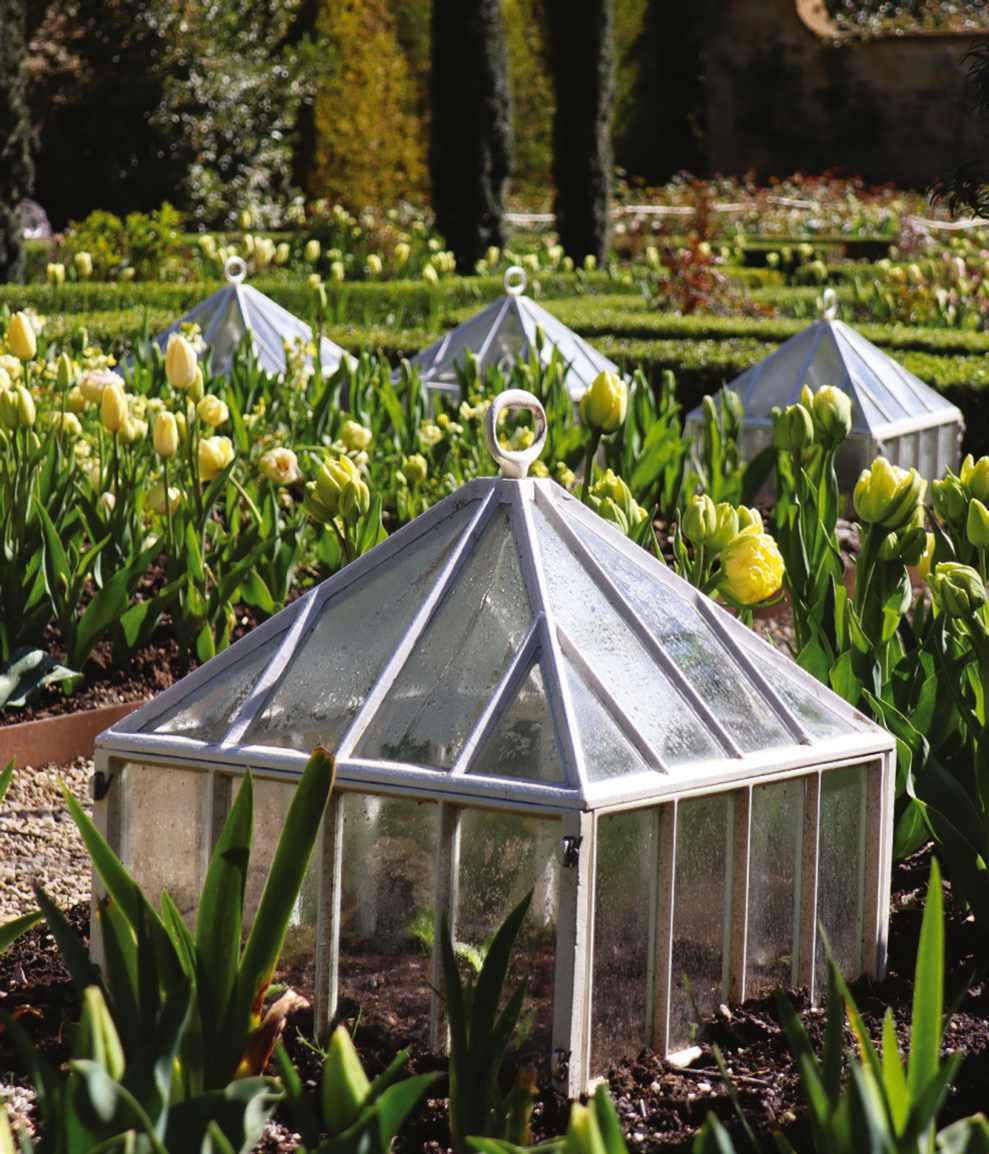




























01473 328272 • sales@schsupplies.co.uk • www.schsupplies.co.uk Indoor Watering Units Garden Waterers & Sprayers Contact us today for a FREE brochure featuring over 200 British products, or visit our website to find out more. MADE IN BRITAIN SCH manufacture a vast selection of robust garden waterers & sprayers, perfect for areas far from your fixed water source. Estate & Garden Waterers Hanging Basket Waterers do r at n U its Indoor Units Small Sprayers Towed Sprayers Push Sprayers Ref: THBW Ref: IDU Ref: GBS5 Ref: GWCS9 Ref: PSP Ref: GWC(E) PLANT SUPPORTS & Garden Artefacts Beautiful designs for perennials,roses,shrubs & climbers Made in England www.leanderplantsupports.co.uk Tel. 01773 550495 P Claverton Cloches MAKERS OF EXQUISITE CAST-IRON CLOCHES CLAVERTONCLOCHES.COM +44 (0)7521 467371 Discover more at ecozone com Availaible at Ocado.com | Amazon.co.uk | Ecozonedirect.com &Biodegradable mineral-based formula* *among other ingredients m r a Multi-Purpose Cleaning Power For Clean, Polished & Protected Surfaces at Home & in The Garden.

LOVESPRINGWATCH? LOVE DON’T MISS THIS EXCLUSIVE OFFER Scan the QR code to download your digital edition straight away or visit try.discoverwildlife.com/ springwatch2023 Here is your chance to sample an issue of the world’s best wildlife magazine absolutely free! Alternatively,subscribetodayandGETYOURFIRST6ISSUESFORJUST£9.99!* Visit buysubscriptions.com/WLSP23HA or call 03330 162 114† QUOTE CODE WLSP23HA *Offer available to UK Direct Debit orders only and subject to availability. After your first six issues for £9.99 you will pay £18.99 every six issues, saving 42% on the shop price. If you cancel within two weeks of receiving your fifth issue, you will pay no more than £9.99. This is an introductory offer and we reserve the right to reject or cancel any application for a trial subscription offer if the customer has previously purchased a trial offer for the same magazine or any other magazine in the Our Media portfolio. For a full list of our titles visit buysubscriptions.com/portfolio. Your subscription will start with the next available issue. +UK calls will cost the same as other standard fixed line numbers (starting 01 or 02) and are included as part of any inclusive or free minutes allowances (if offered by your phone tariff). Outside of free call packages call charges from mobile phones will cost between 3p and 55p per minute. Lines are open Mon to Fri 8am-6pm and Sat 9am-1pm. OFFER ENDS 31st JULY 2023.
WIN a three-night stay at Le Jardin des Douars in Morocco
Treat yourself to a relaxing stay at a luxury hotel set within a lush botanical garden in rural Morocco. Enter our competition for your chance to win a three-night stay.

Located in the hills beyond Essaouira and overlooking the Oued Ksob river, the family-run Le Jardin des Douars is the leading independent hotel in Essaouira. This hotel offers individually designed bedrooms, suites and villas, plus two outdoor swimming pools. The hotel is also home to its own hammam and spa where therapists offer the traditional hammam ritual and various body and face spa treatments using highly prized argan oil, extracted from the region’s famed argan trees.
But what perhaps makes this hotel truly unique is its lush
botanical gardens. These gardens alone draw visitors to explore the ropical plants and trees, including various impressive palms such as Phoenix canariensis, Sabal palmetto and Butia capitata, and the stunning bottlebrush Callistemon linearis. One of the gardeners will happily show you around to point out the various botanical highlights.
If guests can draw themselves away from Le Jardin des Douars, then a shuttle service offers expeditions to nearby beaches, dunes, the local medina, hills and countryside.
With around 320 days of sunshine per year, Essaouira is an ideal, year-round, outdoor destination. Find out more at jardindesdouars.com
THE PRIZE
For the winner and one guest, the prize (worth £1,035) includes:
• Accommodation for three nights, including use of the outdoor swimming pools
• Dinner each one evening
• Lunch each one day
• Daily breakfast each
• A hammam or massage each one day
• Transfers to and from Essaouira airport
• A return shuttle to and from the medina
HOW TO ENTER
For your chance to win, answer this question correctly:
From what part of the argan tree is argan oil extracted?
a) Bark b) Leaves c) Seed
Enter online at gardensillustrated.com/ morocco
Closing date 11.59pm, 16 June 2023.
Terms and conditions The Promoter is Our Media Limited (company number 05715415). Entrants must be UK residents, aged 18 or over. Flights not included. The stay must be booked from 1 September 2023 and is valid until 30 June 2024, subject to date availability (excluding 21-31 December 2023 and 28 March – 6 April 2024). Stay is for two guests sharing an entry-level room. Travel insurance not included. Full terms and conditions can be found a gardensillustrated.com/morocco
Lush, tropical planting surrounds the guest facilities.
One of the hotel’s two swimming pools.
Relaxing and comfortable guest accommodation.
JUNE 2023 gardensillustrated.com 141 LAWRENCE QUAMMU, © 2014 PHOTOGRAPHE
DOWNTOOLS READER COMPETITION
LAWRENCE QUAMMU, MIHOCI.COM
To enter, scan the QR code with your phone camera, or go to gardensillustrated. com/morocco
gardensillustrated.com

Head to the Gardens Illustrated website for more exclusive content on gorgeous gardens and the best seasonal plants. You’ll also find the latest horticultural news and details of forthcoming events – plus podcasts, offers and competitions

Watch our easy guide to making a peony support
Sissinghurst Castle head gardener Troy Scott Smith shows how to make a natural support for peonies.
Why aphids are such remarkable insects
Find out how amazing aphids can adapt to pesticides, clone themselves and are a food source for other insects.

Discover how to attract wildlife into your garden

Learn about the best plants and flowers to attract pollinating insects and how to create habitats for them.
Top garden events to enjoy this summer
Whether you want to learn a new skill, or find your nearest plant fair, our events guide has all the details.
142 gardensillustrated.com JUNE 2023
Summer inspiration
WONDERLAND BOUTIQUE
Bring some sunshine into your wardrobe with a pure-silk scarf from Wonderland Boutique. Only £39 which includes gift wrapping and p&p, they also make a perfect gift and can be sent directly to the recipient.

01263 732643 wonderlandboutique.com
DEVENICK DESIGNS
‘Primrose and Phoebe’ the Posh Birds garden sculpture is part of our Thinimals® collection. At 1.2m tall, this contemporary eye-catching design will add elegance to any garden bed, pond or rockery. Made in stainless steel, with a choice of two bright, powder-coat finishes the sculpture is suited to formal or informal styles of garden.
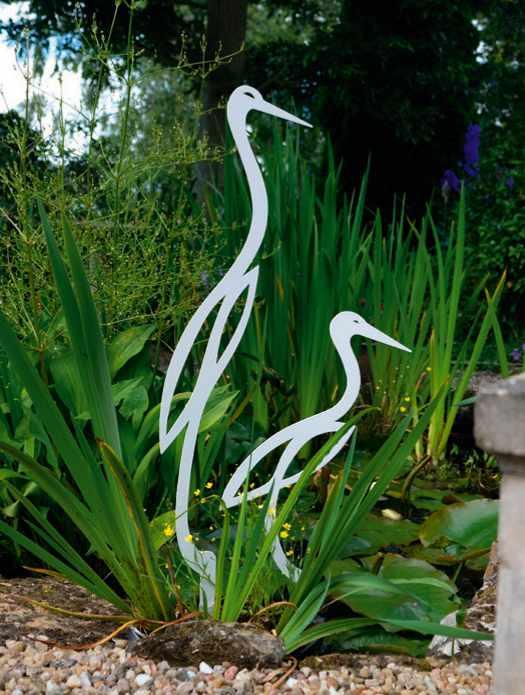
07720 841394 devenickdesigns.co.uk
CLARKE CRS400 ROTARY SOIL SIEVE

Ideal for use in the garden or allotment. Sieve soil and compost to get smooth, fine results. Spring-loaded handle applies pressure to the compost or soil forcing it through the tough diamond mesh.
0115 956 5555 machinemart.co.uk
RUTH MOILLIET SCULPTURE
Ruth Moilliet produces highly finished sculptures inspired by the plant kingdom. Clients can choose from an existing portfolio or commission a bespoke artwork. For smaller pieces follow the purchase link on the website. Featured artwork

– Allium – coloured stainless steel sculpture@ruthmoilliet.com ruthmoilliet.com
HARRIS DRYBOOTS
Harris Dryboots are handmade using fine quality Malaysian rubber. An ideal alternative to a cumbersome knee-length wellington boot…they are washable, cotton lined with padding around the ankle, they have a reinforced ‘digging’ sole, a deep gusset for easy access/ removal and are vegan friendly. £81.99 per pair + p&p.
07974 977112 thedrybootcompany.com
BACKDOORSHOES
Everyone needs a pair! Perfect footwear to slip on and tend to the garden, walk the dog or even nip out to the garden office. They are lightweight, waterproof, durable and versatile. We have over 30 fun designs to suit all! 15% online discount for Gardens Illustrated readers using code: GIJUNE23

01202 232357 backdoorshoes.co.uk

ADVERTISEMENT FEATURE
From beautiful craftsmanship to handmade pots and practical accessories, we can help to make your summer garden special
Nursery guide
Get inspired with the best plant, tree and shrub suppliers


BEETHAM NURSERIES
Beetham Nurseries is a familyowned, independent Garden Centre and Growing Nursery on the A6 in south Cumbria, just four miles from the M6 motorway. Established in 1984, we are proud to offer our customers something different and unique. The Growing Nursery is a traditional retail plant nursery where you will find thousands of herbaceous perennials; they will always be interesting and grown by us here at Beetham Nurseries.
beethamnurseries.co.uk | 015395 63630
ASHWOOD NURSERIES
A plantsman’s paradise and an independent nursery situated in the West Midlands open seven days a week. We specialise in hellebores, hardy cyclamen, salvias, hepaticas, lewisias, hydrangeas, dwarf conifers, snowdrops, primula auricula and many more beautiful plants. Our UK mail order service sends plants, garden essentials and gifts direct to your doorstep. John’s Garden is open every Saturday for charity. Please visit our website for full details.

ashwoodnurseries.com | 01384 401996
LANGTHORNS PLANTERY
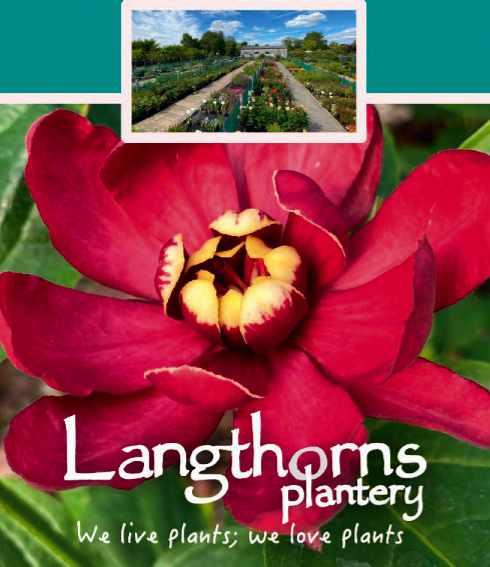
With an eye for the unusual and a vast range of plants of all sizes, the team at Langthorns Plantery is on hand to help you choose the right plants for your garden. Our collection of more than 5,000 varieties includes ornamental and fruit trees, shrubs, perennials, roses, climbers, bamboos, grasses, herbs and wildflowers. View online or visit our Plantery and share our passion for plants.
langthorns.com | 01371 872611
OLD COURT NURSERIES
Specialist nursery and garden set at the foot of the Malvern Hills. Open Wednesday to Saturday 11am to 5pm. The one-and-a-half acre garden is full of year-round interest and the adjacent nursery is well stocked with plants grown on site. Holders of the National Plant Collection of autumn flowering asters and related genre (Michaelmas daisies), as well as an extensive tender succulent and fern collection. Mail order available.
autumnasters.co.uk | 01684 540416
BLUEBELL ARBORETUM & NURSERY

Specialist nursery growing hardy trees, shrubs and climbers including a huge selection of unusual species and cultivars. Informative website with plenty of plant photos and a reliable mail-order service is available. Surrounded by a beautiful nine-acre woodland garden (an RHS partner garden), which is open to visitors all year round.
bluebellnursery.com | 01530 413700
BUNKERS HILL PLANT NURSERY

A family-run plant nursery near Woodstock in Oxfordshire, with an old-fashioned feel and traditional values. In autumn and winter we specialise in bareroot stock of roses, soft fruit, fruit trees, ornamental trees, hedging, pleached trees and rootball plants. Then in spring and summer the nursery is bursting with a huge selection of perennials and shrubs with an assortment of rare or unusual plants. We are also pleased to send bulbs and roses nationwide.
bunkershillgardenshop.co.uk | 01869 331492
ADVERTISEMENT FEATURE
JULY
• How to adapt a suburban UK garden for climate change and increased biodiversity
• A dynamic garden in Portugal with bold, modern planting that’s shaking up the traditional garden culture
• The old walled garden of a former Scottish manse transformed with a joyful melding of food and flowers
• The best blooms for July with expert advice and inspiration

• Rooftop planting by Piet Oudolf and Tom de Witte
ON SALE 16 JUNE
Save money when you subscribe to the digital edition – see page 22. Also in selected Waitrose, Sainsbury’s and Tesco stores, as well as WHSmith, and all good magazine retailers.
JUNE 2023 gardensillustrated.com 145 IN THE NEXT ISSUE
CLIVE NICHOLS, MARIANNE MAJERUS, JASON INGRAM, RICHARD BLOOM
WORKING OUT
It feels very, well, 2020 to be bringing up the whole garden studio thing. Remember this time three years ago, when we all emerged, blinking, into that glorious summer in the wake of lockdown, sitting on our individual picnic blankets and still not hugging our friends? Chances are you would have had a conversation about a garden office/gym/ studio at some point. Sales of garden buildings increased by 500 per cent between January and May 2021; sheds weren’t far behind with a rocketing rise of 460 per cent.

And now, ever the harbinger of cool, I have joined the masses in getting a ‘studio’, or a ‘posh shed’ in the garden. Theoretically, it’s there to be worked in – not that you’d ever find me calling it a ‘shoffice’.
Arriving to the party three years late, I would have thought that the process might have been easier, frankly. I’d naively hoped to have the thing built last October. We finally got it done in May. Planning permission was a huge spanner in the works: outbuildings less than 15m square and shorter than 2.5m are allowable by permitted development rights, but if you live in a flat, like we do, you don’t have permitted development rights. Thus ensued a papertrail in which we
discovered we lived in a conservation area nobody – not even our solicitor or patient planning liaison – knew existed. It’s all been very dull, with the exception of a baby arriving in the middle of it all.
The baby was the main motivating factor: he sleeps in the room that I used to write in, you see. And so a posh shed to house a wall of bookshelves and a desk was considered a solution. I suppose if I worked out I could have dedicated it to dumbbells, instead, or walls of eggboxes, as a podcasting friend aspires to. Many of us harbour posh-shed dreams: my father built a workshop that, adorably,hasitsownadjoiningtinymicroshed, which holds garden tools.
Knowing which one to buy was a minefield. Garden studios range from DIY efforts created from second-hand windows, sheets of plasterboard, and the assistance of corner spirit levels and YouTube, to swoon-worthy architectural wonders that start around the £30,000 mark as a ballpark figure. There are many off-the-shelf options, from companies including Green Retreats (the no-landfill company vouched for by Kevin McCloud –prices start around £20,000) and Malvern Garden Buildings (more traditional designs starting at around £4,000). Recommended at
the top end are the sustainability-focused Trew Turner, which makes beautiful bespoke outbuildings, and Koto Cabins, purveyors of achingly tasteful Scandinavian and Japaneseinspired prefabs.
Modular options offer the choice of relative affordability with bespoke touches: U-Build, a not-for-profit self-build system that stresses the ease with which it can be adapted, involves two designers for a £200 consultancy fee, and then delivers variations on its flat-pack sheds from £7,000. Okopod’s small offices start at £12,900. Both include insulation, and boast swift construction – although U-Build leaves the customer to decide who puts it up. Or you could just contract a carpenter to build you what you fancy to your budget.
This is not our forever home nor garden and, as mentioned, we’ve had a baby in the middle of a cost-of-living crisis. In short, cash was always going to be a constraint. We ended up going with a small independent company who adapted a standard studio design to meet our needs for four, rather than five, figures. I rehomed a rambling rose from my parents to grow over the top of it, and made peace with the fact that, like the study it is replacing, it will inevitably fill up with non-studious rubbish. A garden room of one’s own. ■
Coming late to the garden-office party, Alice Vincent was hoping someone else might have taken the hard work out of creating the perfect garden studio
146 gardensillustrated.com JUNE 2023
ILLUSTRATION ALICE PATTULLO


If you love your garden, you’ll know it takes time and care to create something truly wonderful. That’s why we put our faith in traditional joinery techniques such as mortise and tenon joints to give our greenhouses strength and integrity. Using only the highest quality Western Red Cedar. Handcrafted in our Cotswold workshops. No wonder Gabriel Ash are the only timber greenhouses endorsed by the Royal Horticultural Society (RHS). For a Free Brochure call 01242 662 926 or visit gabrielash.com The Classic Freestanding Greenhouses are now available to buy online. Our Coldframes and Accessories are also available online. See us at the RHS Hampton Court Palace Garden Festival (3rd – 9th July), and the RHS Flower Show Tatton Park (19th – 23rd July) The Classic Six The RHS Hyde Hall Planthouse The Classic Grow & Store ®The Royal Horticultural Society. The Royal Horticultural Society, and its logo, are trade marks of The Royal Horticultural Society. (Registered Charity No. 222879/SC038262) and used under licence from RHS Enterprises Limited. in the MadewithPride Cotswolds The RHS Portico April 2023










































































 1. Château Planters, powder-coated steel and accoya wood, from £1,500, 01423 400100, ornamenti.co.uk
1. Château Planters, powder-coated steel and accoya wood, from £1,500, 01423 400100, ornamenti.co.uk
 Cordless POWER. BY STIHL.
ONE BATTERY. MANY TOOLS.
Cordless POWER. BY STIHL.
ONE BATTERY. MANY TOOLS.



































 AGM*. RHS H7, USDA 5a-7b†
AGM*. RHS H7, USDA 5a-7b†

 25cm x 45cm. AGM. RHS H7, USDA 3a-7b.
25cm x 45cm. AGM. RHS H7, USDA 3a-7b.

 ‘Totally Tangerine’
RHS
45-50cm. AGM. RHS H7.
‘Totally Tangerine’
RHS
45-50cm. AGM. RHS H7.





















































 7 Syringa vulgaris ‘De Mirabel’
7 Syringa vulgaris ‘De Mirabel’



 WORDS ALYS FOWLER PHOTOGRAPHS SIETSKE DE VRIES
WORDS ALYS FOWLER PHOTOGRAPHS SIETSKE DE VRIES

 Small pools of purple from Iris ‘Dusky Dancer’, Allium hollandicum ‘Purple Sensation’ and Salvia nemorosa ‘Caradonna’
of green foliage and grasses.
Small pools of purple from Iris ‘Dusky Dancer’, Allium hollandicum ‘Purple Sensation’ and Salvia nemorosa ‘Caradonna’
of green foliage and grasses.












































 Garden of Medicinal Plants – Chelsea Physic Garden Photo: R Alexander
Garden of Medicinal Plants – Chelsea Physic Garden Photo: R Alexander
 by Greg Loades
by Greg Loades
 by Allyson Levy and Scott Serrano
by Allyson Levy and Scott Serrano
 by Ben Dark
by Ben Dark















 Ilex Nellie R Stevens
Ligustrum japonicum (pleached)
Magnolia grandiflora
Ilex Nellie R Stevens
Ligustrum japonicum (pleached)
Magnolia grandiflora











































